
24 February 2017 KENNEDY WILSON EUROPE REAL ESTATE PLC (“KWE”, the “Company” or the “Group”) FULL-YEAR RESULTS FOR THE YEAR ENDED 31 DECEMBER 2016 KWE DELIVERS 23% INCOME GROWTH Kennedy Wilson Europe Real Estate Plc (LSE: KWE), an LSE listed property company that invests in real estate across the UK, Ireland, Spain and Italy, today announces its audited full-year results for the year ended 31 December 2016. Income statement 31 December 2016 31 December 2015 Change (%) Net operating income (“NOI”) (£m) 160.3 130.1 23.2 IFRS net profit after taxation (£m) 66.0 259.0 -74.5 Adjusted earnings (£m) 74.1 65.0 14.0 Adjusted earnings per share (p) 55.2 47.9 15.2 DPS paid (p) 48.0 35.0 37.1 Quarterly DPS announced (p) 12.0 12.0 - Balance sheet 31 December 20161 31 December 2015 Change (%) Adjusted NAV (£m) 1,533.7 1,596.5 -3.9 IFRS NAV (£m) 1,535.9 1,629.2 -5.8 Adjusted NAV per share (p) 1,215.9 1,174.5 3.5 IFRS NAV per share (p) 1,217.6 1,198.5 1.6 Valuation movement (£m) -8.6 211.8 Na Net debt (£m) 1,234.8 1,109.6 11.3 Loan to value (LTV) (%) 42.8 39.7 3.1pp Operational highlights: Portfolio value at £2,882.2 million1 generating annualised topped-up NOI2 of £163.7 million across 223 properties Solid asset management progress having completed 140 commercial lease transactions (1.1 million sq ft), delivering an uplift over previous passing rent of 11.4% and outperforming valuers’ preceding ERVs by 3.1% Secure and sustainable income underpinned by strong portfolio occupancy of 95% and long WAULTs of 7.1 years (8.9 years to expiry) £413.1 million of sales across 89 properties3, at an average exit yield of 5.8%, a spread of 180bps over entry yield on cost; delivering a premium to book value of 4.8% and generating an attractive return on cost of 31.8%; £200 million non-core disposal programme completed ahead of June 2017 target Practical completion of Baggot Plaza and Block K, Vantage, our two largest developments in Dublin, together expected to add £8.1 million of annualised NOI Financial highlights: 3.5% increase in Adjusted NAV per share to 1,215.9 pence (Dec-15: 1,174.5 pence) 37% increase in dividends paid of 48.0 pence per share (FY-15: 35.0 pence per share) or £64.4 million of dividends paid in 2016 Raised a further £318.6 million of unsecured financing by tapping the 2025 Euro bond by a further €150 million to a benchmark size of €550 million and the 2022 Sterling bond by a further £200 million to £500 million Low weighted average cost of debt of 3.0%, with 92% of debt fixed or hedged Long debt term of 6.1 years; LTV of 42.8% and well within target range Completed £100 million share buyback of 9.8 million shares at an average price of 1,020 pence per share, representing a 17.7% discount to Q3-16 adjusted NAV per share Post year end achievements: Strong leasing momentum continues with 17 lease transactions completed, adding a further £0.7 million of incremental annualised income; delivering a rental uplift of 18.1% ahead of previous passing and outperforming valuers’ preceding ERVs by 11.4% Agreement for lease signed with Tesco at Stillorgan Shopping Centre, Co. Dublin, for a new 25-year lease (term certain 15 years) and planning permission received for new extension unit unlocking asset management opportunities
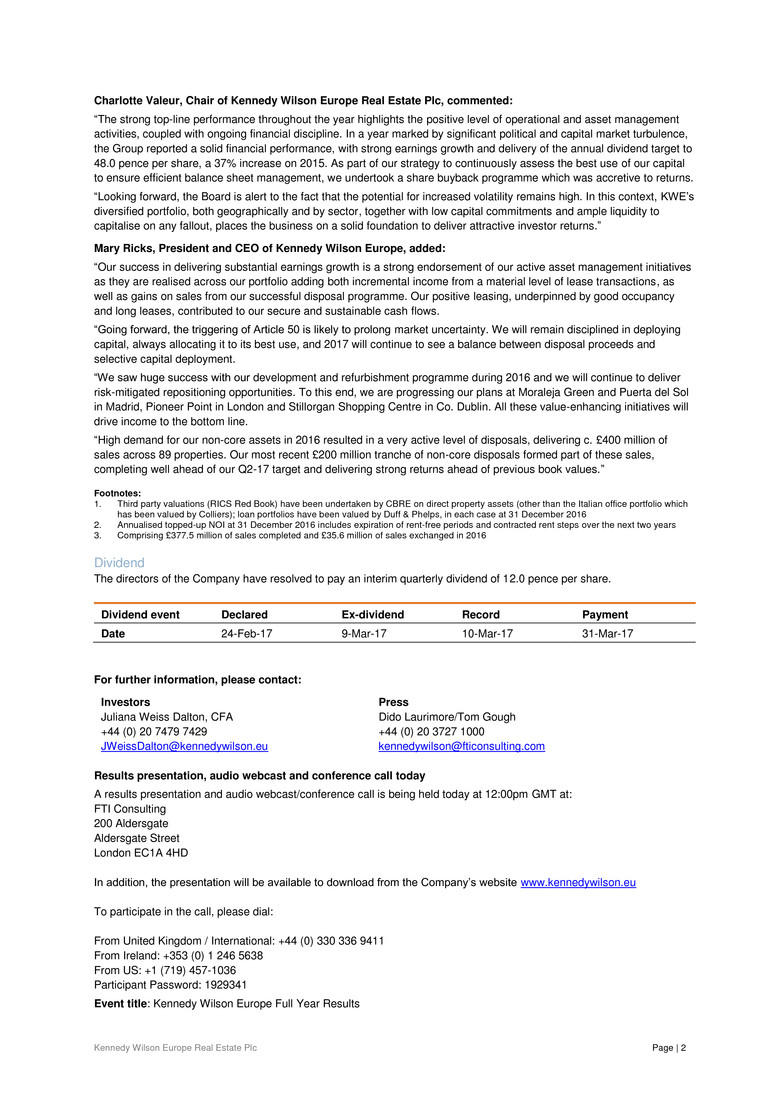
Kennedy Wilson Europe Real Estate Plc Page | 2 Charlotte Valeur, Chair of Kennedy Wilson Europe Real Estate Plc, commented: “The strong top-line performance throughout the year highlights the positive level of operational and asset management activities, coupled with ongoing financial discipline. In a year marked by significant political and capital market turbulence, the Group reported a solid financial performance, with strong earnings growth and delivery of the annual dividend target to 48.0 pence per share, a 37% increase on 2015. As part of our strategy to continuously assess the best use of our capital to ensure efficient balance sheet management, we undertook a share buyback programme which was accretive to returns. “Looking forward, the Board is alert to the fact that the potential for increased volatility remains high. In this context, KWE’s diversified portfolio, both geographically and by sector, together with low capital commitments and ample liquidity to capitalise on any fallout, places the business on a solid foundation to deliver attractive investor returns.” Mary Ricks, President and CEO of Kennedy Wilson Europe, added: “Our success in delivering substantial earnings growth is a strong endorsement of our active asset management initiatives as they are realised across our portfolio adding both incremental income from a material level of lease transactions, as well as gains on sales from our successful disposal programme. Our positive leasing, underpinned by good occupancy and long leases, contributed to our secure and sustainable cash flows. “Going forward, the triggering of Article 50 is likely to prolong market uncertainty. We will remain disciplined in deploying capital, always allocating it to its best use, and 2017 will continue to see a balance between disposal proceeds and selective capital deployment. “We saw huge success with our development and refurbishment programme during 2016 and we will continue to deliver risk-mitigated repositioning opportunities. To this end, we are progressing our plans at Moraleja Green and Puerta del Sol in Madrid, Pioneer Point in London and Stillorgan Shopping Centre in Co. Dublin. All these value-enhancing initiatives will drive income to the bottom line. “High demand for our non-core assets in 2016 resulted in a very active level of disposals, delivering c. £400 million of sales across 89 properties. Our most recent £200 million tranche of non-core disposals formed part of these sales, completing well ahead of our Q2-17 target and delivering strong returns ahead of previous book values.” Footnotes: 1. Third party valuations (RICS Red Book) have been undertaken by CBRE on direct property assets (other than the Italian office portfolio which has been valued by Colliers); loan portfolios have been valued by Duff & Phelps, in each case at 31 December 2016 2. Annualised topped-up NOI at 31 December 2016 includes expiration of rent-free periods and contracted rent steps over the next two years 3. Comprising £377.5 million of sales completed and £35.6 million of sales exchanged in 2016 Dividend The directors of the Company have resolved to pay an interim quarterly dividend of 12.0 pence per share. Dividend event Declared Ex-dividend Record Payment Date 24-Feb-17 9-Mar-17 10-Mar-17 31-Mar-17 For further information, please contact: Investors Juliana Weiss Dalton, CFA +44 (0) 20 7479 7429 JWeissDalton@kennedywilson.eu Press Dido Laurimore/Tom Gough +44 (0) 20 3727 1000 kennedywilson@fticonsulting.com Results presentation, audio webcast and conference call today A results presentation and audio webcast/conference call is being held today at 12:00pm GMT at: FTI Consulting 200 Aldersgate Aldersgate Street London EC1A 4HD In addition, the presentation will be available to download from the Company’s website www.kennedywilson.eu To participate in the call, please dial: From United Kingdom / International: +44 (0) 330 336 9411 From Ireland: +353 (0) 1 246 5638 From US: +1 (719) 457-1036 Participant Password: 1929341 Event title: Kennedy Wilson Europe Full Year Results

Kennedy Wilson Europe Real Estate Plc Page | 3 The live audio webcast will be available on the Company’s website www.kennedywilson.eu About Kennedy Wilson Europe Kennedy Wilson Europe Real Estate Plc is an LSE listed property company that invests in real estate across the UK, Ireland, Spain and Italy. It aims to generate superior shareholder returns by unlocking value of under-resourced real estate across its target geographies. Its existing portfolio is primarily invested across office and retail in the UK and Ireland, weighted towards London, the South East and Dublin. For further information on Kennedy Wilson Europe Real Estate Plc, please visit www.kennedywilson.eu About Kennedy Wilson Kennedy Wilson Europe Real Estate Plc is externally managed by a wholly-owned Jersey incorporated subsidiary of Kennedy-Wilson Holdings, Inc. Kennedy-Wilson Holdings, Inc. (NYSE:KW) is a global real estate investment company. KW owns, operates, and invests in real estate both on its own and through its investment management platform. KW focuses on multifamily and commercial properties located in the Western U.S., UK, Ireland, Spain, Italy and Japan. To complement KW’s investment business, it also provides real estate services primarily to financial services clients. For further information on Kennedy Wilson, please visit www.kennedywilson.com Cautionary Statement and Forward Looking Statements This announcement has been prepared for, and only for the members of the Company, as a body, and no other persons. The Company, its directors, employees, agents or advisers do not accept or assume responsibility to any other person to whom this document is shown or into whose hands it may come and any such responsibility or liability is expressly disclaimed. By their nature, the statements concerning the risks and uncertainties facing the Company and/ or the Group in this announcement involve uncertainty since future events and circumstances can cause results and developments to differ materially from those anticipated. This announcement may contain certain forward-looking statements with respect to Kennedy Wilson Europe Real Estate Plc (the “Company”) and its subsidiaries (together, the “Group”), and the Group’s financial condition, results of operations, business, future plans and strategies, anticipated events or trends, and similar matters, that are not historical facts. Such forward-looking statements involve known and unknown risks, uncertainties and other factors, which may cause the actual results of operations, performance or achievements of the Group or industry results to be materially different from any future results, performance or achievements expressed or implied by such forward-looking statements. These forward- looking statements speak only as at the date of this announcement. The Company undertakes no obligation to release publicly any revisions or updates to these forward-looking statements to reflect future events, circumstances, unanticipated events, new information or otherwise except as required by law or any appropriate regulatory authority. Past performance is no guide to future performance and persons needing advice should consult an independent financial adviser. Nothing in this announcement should be construed as a profit forecast.

Kennedy Wilson Europe Real Estate Plc Page | 4 Chair’s introduction On behalf of the Board, I am pleased to present our full-year results for 2016. The investment management team delivered significant operational wins across the portfolio, delivering its best leasing results to date; a notable achievement in a year marked by significant political and capital market turbulence. In this context, the Group delivered a solid financial performance, growing earnings and delivering on the annual dividend target. At the same time the team improved the mix of unsecured debt and extended debt maturities whilst keeping our average cost of debt low. The portfolio stands at £2,882.2 million, primarily driven by £295.9 million of acquisition and capital expenditure activity and £165.1 million in foreign exchange gain, owing to material Euro appreciation relative to Sterling. This was offset by very profitable disposal activity and a modest portfolio valuation decline of £8.6 million or only -0.3%. The team also delivered considerable development projects, achieving practical completion, on time and budget, at both Baggot Plaza, Dublin 4, which is let to Bank of Ireland for 25 years, and Block K, Central Park, Dublin 18, where 166 new PRS units were built adjacent to our existing Vantage scheme. Notably, we have already let 72% of the units in the three months to December 2016. Furthermore, the significant refurbishments completions at 111 Buckingham Palace Road, Victoria, London SW1 and Portmarnock Hotel, Co. Dublin, have transformed both properties and are expected to drive income to the bottom line. The business benefitted from active balance sheet management in the year, utilising both of KWE’s unsecured bonds, raising £318.6 million by tapping the 2025 Euro bond by €150 million and the 2022 Sterling bond by £200 million, increasing the bonds outstanding to €550 million and £500 million, respectively. Together they extended our debt maturities to 6.1 years and locked in additional fixed rate debt. Along with the rest of the UK listed real estate sector, and despite strong progress across all parts of the business, we witnessed a material disconnect between KWE’s share price and the underlying business. As part of our ongoing commitment to balance sheet management, we undertook a £100 million share buyback programme, which was accretive to both earnings and NAV per share. We continue to monitor how we can best deliver sustainable total returns for shareholders and have distributed £164.4 million in 2016 through a combination of dividends and share buybacks. Results The Group delivered Adjusted NAV per share of 1,215.9 pence, up 3.5% over December 2015. Adjusted earnings per share were 55.2 pence per share (£74.1 million in total) and basic earnings per share were 49.1 pence per share (£66.0 million in total). Dividends Dividends of 48.0 pence per share, or £64.4 million were paid during the year, reflecting a dividend cover based on 2016 adjusted earnings of 1.1 times, and a 37% increase on the 35.0 pence per share paid in 2015. Today, the Board announces a quarterly interim dividend of 12.0 pence per share. The quarterly dividend will be paid on 31 March 2017 to shareholders on the register at the close of business on 10 March 2017. In the context of the material disposals delivered to date, the Board is comfortable with the level of the dividend being both sustainable and offering an attractive dividend yield to shareholders of c. 5%. The Board will continue to assess the appropriate dividend pay-out on a quarterly basis. Industry achievements In March 2016, the shares of KWE became constituent members of the FTSE EPRA/NAREIT Global Real Estate Index Series and the GPR 250 Index Series. These are both important specialist indices for our investors, in addition to the FTSE 250 Index, which KWE has been a member of since 2014. The Company is a fee-paying member of EPRA, the European trade body for listed real estate securities, and follows EPRA’s Best Practice Recommendations for both operational (EPRA BPRs) and sustainability (EPRA sBPRs) reporting disclosure. In 2015, we achieved EPRA Silver and Bronze for operational and sustainable reporting disclosures respectively, and aim to further improve on this. Outlook The investment and occupier markets across our business remain open and active, illustrated by our record-breaking leasing and disposal activity, both ahead of preceding valuations and delivering attractive returns. We expect the period of market uncertainty to persist and market volatility to potentially increase, as it remains too early to ascertain the impact of the UK’s negotiations to exit the EU and the impact that will have on the UK and the rest of Europe. The Board remains alert to both potential risks and opportunities for KWE’s business. With £539.7 million of disposals since 2015, the natural evolution away from smaller lot sizes demonstrates that our wholesale to retail strategy is working. It has not only improved the portfolio quality but also delivered solid occupancy, longer leases and attractive profits. KWE benefits from a diversified portfolio, both geographically and by sector, low
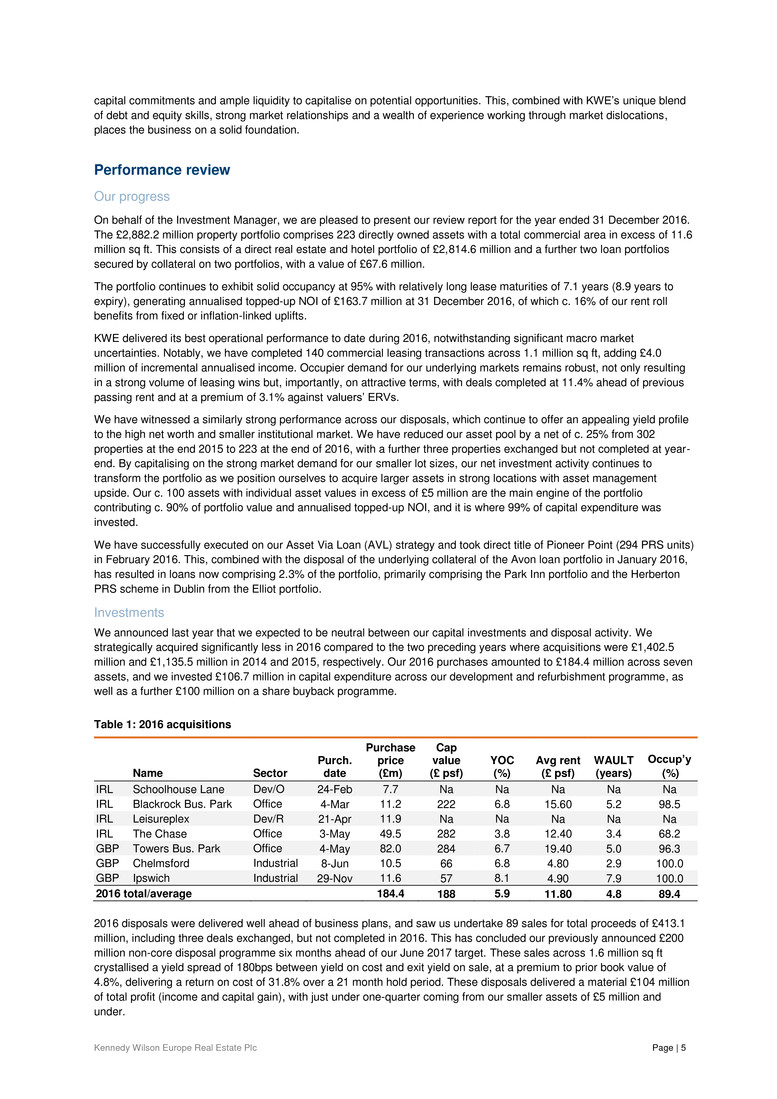
Kennedy Wilson Europe Real Estate Plc Page | 5 capital commitments and ample liquidity to capitalise on potential opportunities. This, combined with KWE’s unique blend of debt and equity skills, strong market relationships and a wealth of experience working through market dislocations, places the business on a solid foundation. Performance review Our progress On behalf of the Investment Manager, we are pleased to present our review report for the year ended 31 December 2016. The £2,882.2 million property portfolio comprises 223 directly owned assets with a total commercial area in excess of 11.6 million sq ft. This consists of a direct real estate and hotel portfolio of £2,814.6 million and a further two loan portfolios secured by collateral on two portfolios, with a value of £67.6 million. The portfolio continues to exhibit solid occupancy at 95% with relatively long lease maturities of 7.1 years (8.9 years to expiry), generating annualised topped-up NOI of £163.7 million at 31 December 2016, of which c. 16% of our rent roll benefits from fixed or inflation-linked uplifts. KWE delivered its best operational performance to date during 2016, notwithstanding significant macro market uncertainties. Notably, we have completed 140 commercial leasing transactions across 1.1 million sq ft, adding £4.0 million of incremental annualised income. Occupier demand for our underlying markets remains robust, not only resulting in a strong volume of leasing wins but, importantly, on attractive terms, with deals completed at 11.4% ahead of previous passing rent and at a premium of 3.1% against valuers’ ERVs. We have witnessed a similarly strong performance across our disposals, which continue to offer an appealing yield profile to the high net worth and smaller institutional market. We have reduced our asset pool by a net of c. 25% from 302 properties at the end 2015 to 223 at the end of 2016, with a further three properties exchanged but not completed at year- end. By capitalising on the strong market demand for our smaller lot sizes, our net investment activity continues to transform the portfolio as we position ourselves to acquire larger assets in strong locations with asset management upside. Our c. 100 assets with individual asset values in excess of £5 million are the main engine of the portfolio contributing c. 90% of portfolio value and annualised topped-up NOI, and it is where 99% of capital expenditure was invested. We have successfully executed on our Asset Via Loan (AVL) strategy and took direct title of Pioneer Point (294 PRS units) in February 2016. This, combined with the disposal of the underlying collateral of the Avon loan portfolio in January 2016, has resulted in loans now comprising 2.3% of the portfolio, primarily comprising the Park Inn portfolio and the Herberton PRS scheme in Dublin from the Elliot portfolio. Investments We announced last year that we expected to be neutral between our capital investments and disposal activity. We strategically acquired significantly less in 2016 compared to the two preceding years where acquisitions were £1,402.5 million and £1,135.5 million in 2014 and 2015, respectively. Our 2016 purchases amounted to £184.4 million across seven assets, and we invested £106.7 million in capital expenditure across our development and refurbishment programme, as well as a further £100 million on a share buyback programme. Table 1: 2016 acquisitions Name Sector Purch. date Purchase price (£m) Cap value (£ psf) YOC (%) Avg rent (£ psf) WAULT (years) Occup’y (%) IRL Schoolhouse Lane Dev/O 24-Feb 7.7 Na Na Na Na Na IRL Blackrock Bus. Park Office 4-Mar 11.2 222 6.8 15.60 5.2 98.5 IRL Leisureplex Dev/R 21-Apr 11.9 Na Na Na Na Na IRL The Chase Office 3-May 49.5 282 3.8 12.40 3.4 68.2 GBP Towers Bus. Park Office 4-May 82.0 284 6.7 19.40 5.0 96.3 GBP Chelmsford Industrial 8-Jun 10.5 66 6.8 4.80 2.9 100.0 GBP Ipswich Industrial 29-Nov 11.6 57 8.1 4.90 7.9 100.0 2016 total/average 184.4 188 5.9 11.80 4.8 89.4 2016 disposals were delivered well ahead of business plans, and saw us undertake 89 sales for total proceeds of £413.1 million, including three deals exchanged, but not completed in 2016. This has concluded our previously announced £200 million non-core disposal programme six months ahead of our June 2017 target. These sales across 1.6 million sq ft crystallised a yield spread of 180bps between yield on cost and exit yield on sale, at a premium to prior book value of 4.8%, delivering a return on cost of 31.8% over a 21 month hold period. These disposals delivered a material £104 million of total profit (income and capital gain), with just under one-quarter coming from our smaller assets of £5 million and under.
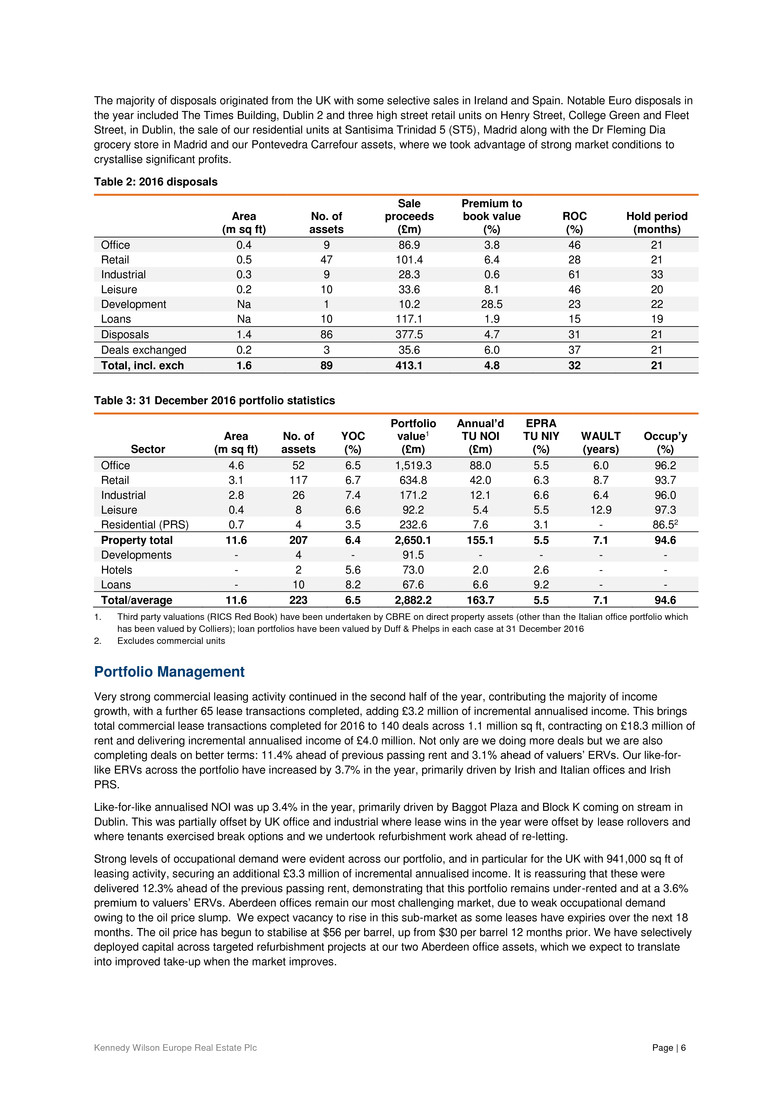
Kennedy Wilson Europe Real Estate Plc Page | 6 The majority of disposals originated from the UK with some selective sales in Ireland and Spain. Notable Euro disposals in the year included The Times Building, Dublin 2 and three high street retail units on Henry Street, College Green and Fleet Street, in Dublin, the sale of our residential units at Santisima Trinidad 5 (ST5), Madrid along with the Dr Fleming Dia grocery store in Madrid and our Pontevedra Carrefour assets, where we took advantage of strong market conditions to crystallise significant profits. Table 2: 2016 disposals Area (m sq ft) No. of assets Sale proceeds (£m) Premium to book value (%) ROC (%) Hold period (months) Office 0.4 9 86.9 3.8 46 21 Retail 0.5 47 101.4 6.4 28 21 Industrial 0.3 9 28.3 0.6 61 33 Leisure 0.2 10 33.6 8.1 46 20 Development Na 1 10.2 28.5 23 22 Loans Na 10 117.1 1.9 15 19 Disposals 1.4 86 377.5 4.7 31 21 Deals exchanged 0.2 3 35.6 6.0 37 21 Total, incl. exch 1.6 89 413.1 4.8 32 21 Table 3: 31 December 2016 portfolio statistics Sector Area (m sq ft) No. of assets YOC (%) Portfolio value1 (£m) Annual’d TU NOI (£m) EPRA TU NIY (%) WAULT (years) Occup’y (%) Office 4.6 52 6.5 1,519.3 88.0 5.5 6.0 96.2 Retail 3.1 117 6.7 634.8 42.0 6.3 8.7 93.7 Industrial 2.8 26 7.4 171.2 12.1 6.6 6.4 96.0 Leisure 0.4 8 6.6 92.2 5.4 5.5 12.9 97.3 Residential (PRS) 0.7 4 3.5 232.6 7.6 3.1 - 86.52 Property total 11.6 207 6.4 2,650.1 155.1 5.5 7.1 94.6 Developments - 4 - 91.5 - - - - Hotels - 2 5.6 73.0 2.0 2.6 - - Loans - 10 8.2 67.6 6.6 9.2 - - Total/average 11.6 223 6.5 2,882.2 163.7 5.5 7.1 94.6 1. Third party valuations (RICS Red Book) have been undertaken by CBRE on direct property assets (other than the Italian office portfolio which has been valued by Colliers); loan portfolios have been valued by Duff & Phelps in each case at 31 December 2016 2. Excludes commercial units Portfolio Management Very strong commercial leasing activity continued in the second half of the year, contributing the majority of income growth, with a further 65 lease transactions completed, adding £3.2 million of incremental annualised income. This brings total commercial lease transactions completed for 2016 to 140 deals across 1.1 million sq ft, contracting on £18.3 million of rent and delivering incremental annualised income of £4.0 million. Not only are we doing more deals but we are also completing deals on better terms: 11.4% ahead of previous passing rent and 3.1% ahead of valuers’ ERVs. Our like-for- like ERVs across the portfolio have increased by 3.7% in the year, primarily driven by Irish and Italian offices and Irish PRS. Like-for-like annualised NOI was up 3.4% in the year, primarily driven by Baggot Plaza and Block K coming on stream in Dublin. This was partially offset by UK office and industrial where lease wins in the year were offset by lease rollovers and where tenants exercised break options and we undertook refurbishment work ahead of re-letting. Strong levels of occupational demand were evident across our portfolio, and in particular for the UK with 941,000 sq ft of leasing activity, securing an additional £3.3 million of incremental annualised income. It is reassuring that these were delivered 12.3% ahead of the previous passing rent, demonstrating that this portfolio remains under-rented and at a 3.6% premium to valuers’ ERVs. Aberdeen offices remain our most challenging market, due to weak occupational demand owing to the oil price slump. We expect vacancy to rise in this sub-market as some leases have expiries over the next 18 months. The oil price has begun to stabilise at $56 per barrel, up from $30 per barrel 12 months prior. We have selectively deployed capital across targeted refurbishment projects at our two Aberdeen office assets, which we expect to translate into improved take-up when the market improves.

Kennedy Wilson Europe Real Estate Plc Page | 7 Table 4: 2016 asset management transactions No. of lease transactions Commercial area (sq ft) Incremental annual income (£m) % ahead of prev. rent % ahead of valuers’ ERV GBP 101 941,000 3.3 12.3 3.6 IRL 29 108,500 0.6 9.6 2.1 ESP 10 8,500 0.1 -4.9 -4.6 Total 140 1,058,000 4.0 11.4 3.1 No. of lease transactions Commercial area (sq ft) Incremental annual income (£m) % ahead of prev. rent % ahead of valuers’ ERV Lettings 34 139,100 2.4 Na 4.1 Re-gears 64 582,000 0.7 9.7 3.8 Rent reviews 42 336,900 0.9 13.3 2.1 Total 140 1,058,000 4.0 11.4 3.1 A significant level of PRS renewal and letting activity was undertaken over the year at our three properties: Pioneer Point in the UK, Vantage (including Block K) and Liffey Trust in Ireland. Overall, occupancy was down, driven by the continued transition of Pioneer Point from short term lets to Assured Shorthold Tenancies (ASTs). Our Irish PRS assets remain under-rented and we witnessed strong ERV growth per unit of 19.2% over the year, driven by Vantage, as we continued to let existing units at attractive levels and Block K where our leasing efforts have exceeded all targets. We achieved practical completion of the 166-unit Block K development in the second half of the year and began our formal leasing in October 2016. At year end, we had already let 120 of 166 units (72%), which is well ahead of business plan. Table 5: Notable lease transactions completed in H2-16 Scheme Lease transaction Acq’n port. Property, city Sector Area (sq ft) Type Tenant Area (sq ft) Term (years) % over prev. rent GBP Jupiter Friars Bridge Court, London Office 99,100 Re-gear London & South Eastern Railway 25,300 2 +63 GBP Artemis Douglas House, Reigate Office 26,500 Re-gear Kimberly Clark 26,500 5 +14 GBP Na Great Blakenham, Ipswich Industrial 203,400 Re-gear Magnus Group 98,500 15 +8 GBP Gatsby Portlethen Retail Park, Aberdeen Retail 96,600 Re-gear Homebase 44,400 10 -6 GBP Artemis Theta House, Camberley Office 50,700 Re-gear Amer Sports 16,600 51 +2 GBP Artemis Marsh Street, Bristol Office 36,100 Re-gear AON 21,100 5 +37 GBP Gatsby Eley Road Indust. Estate, Edmonton Industrial 41,300 Re-gear SIG Trading 19.600 102 +74 GBP Artemis Theta House, Camberley Office 50,700 New lease Surrey & Boarders NHS Trust 16,500 73 Prev. vacant GBP Gatsby Portlethen Retail Park, Aberdeen Retail 96,600 New lease B&M 23,000 15 Prev. vacant GBP Artemis 8 Wells Place, Merstham Industrial 19,400 New lease FG Curtis 19,400 102 Prev. vacant GBP Artemis 6 Lochside, Edinburgh Office 40,000 New lease HSBC 9,000 51 Prev. vacant GBP Gatsby Park Farm Indust. Park, Wellingboro. Industrial 25,000 Rent review TNT 25,000 Na +12 1. 10-year lease to expiry with tenant break option (TBO) at year five 2. 15-year lease to expiry with TBO at year ten 3. 14-year lease to expiry with TBO at year seven
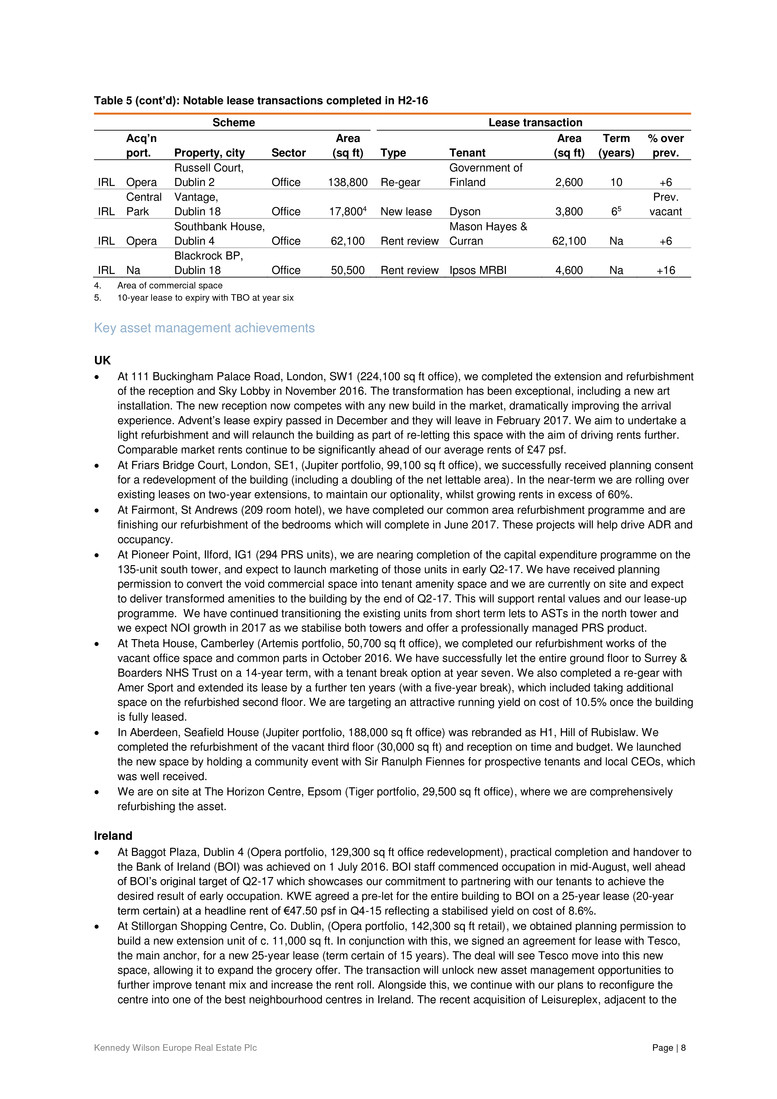
Kennedy Wilson Europe Real Estate Plc Page | 8 Table 5 (cont’d): Notable lease transactions completed in H2-16 Scheme Lease transaction Acq’n port. Property, city Sector Area (sq ft) Type Tenant Area (sq ft) Term (years) % over prev. IRL Opera Russell Court, Dublin 2 Office 138,800 Re-gear Government of Finland 2,600 10 +6 IRL Central Park Vantage, Dublin 18 Office 17,8004 New lease Dyson 3,800 65 Prev. vacant IRL Opera Southbank House, Dublin 4 Office 62,100 Rent review Mason Hayes & Curran 62,100 Na +6 IRL Na Blackrock BP, Dublin 18 Office 50,500 Rent review Ipsos MRBI 4,600 Na +16 4. Area of commercial space 5. 10-year lease to expiry with TBO at year six Key asset management achievements UK At 111 Buckingham Palace Road, London, SW1 (224,100 sq ft office), we completed the extension and refurbishment of the reception and Sky Lobby in November 2016. The transformation has been exceptional, including a new art installation. The new reception now competes with any new build in the market, dramatically improving the arrival experience. Advent’s lease expiry passed in December and they will leave in February 2017. We aim to undertake a light refurbishment and will relaunch the building as part of re-letting this space with the aim of driving rents further. Comparable market rents continue to be significantly ahead of our average rents of £47 psf. At Friars Bridge Court, London, SE1, (Jupiter portfolio, 99,100 sq ft office), we successfully received planning consent for a redevelopment of the building (including a doubling of the net lettable area). In the near-term we are rolling over existing leases on two-year extensions, to maintain our optionality, whilst growing rents in excess of 60%. At Fairmont, St Andrews (209 room hotel), we have completed our common area refurbishment programme and are finishing our refurbishment of the bedrooms which will complete in June 2017. These projects will help drive ADR and occupancy. At Pioneer Point, Ilford, IG1 (294 PRS units), we are nearing completion of the capital expenditure programme on the 135-unit south tower, and expect to launch marketing of those units in early Q2-17. We have received planning permission to convert the void commercial space into tenant amenity space and we are currently on site and expect to deliver transformed amenities to the building by the end of Q2-17. This will support rental values and our lease-up programme. We have continued transitioning the existing units from short term lets to ASTs in the north tower and we expect NOI growth in 2017 as we stabilise both towers and offer a professionally managed PRS product. At Theta House, Camberley (Artemis portfolio, 50,700 sq ft office), we completed our refurbishment works of the vacant office space and common parts in October 2016. We have successfully let the entire ground floor to Surrey & Boarders NHS Trust on a 14-year term, with a tenant break option at year seven. We also completed a re-gear with Amer Sport and extended its lease by a further ten years (with a five-year break), which included taking additional space on the refurbished second floor. We are targeting an attractive running yield on cost of 10.5% once the building is fully leased. In Aberdeen, Seafield House (Jupiter portfolio, 188,000 sq ft office) was rebranded as H1, Hill of Rubislaw. We completed the refurbishment of the vacant third floor (30,000 sq ft) and reception on time and budget. We launched the new space by holding a community event with Sir Ranulph Fiennes for prospective tenants and local CEOs, which was well received. We are on site at The Horizon Centre, Epsom (Tiger portfolio, 29,500 sq ft office), where we are comprehensively refurbishing the asset. Ireland At Baggot Plaza, Dublin 4 (Opera portfolio, 129,300 sq ft office redevelopment), practical completion and handover to the Bank of Ireland (BOI) was achieved on 1 July 2016. BOI staff commenced occupation in mid-August, well ahead of BOI’s original target of Q2-17 which showcases our commitment to partnering with our tenants to achieve the desired result of early occupation. KWE agreed a pre-let for the entire building to BOI on a 25-year lease (20-year term certain) at a headline rent of €47.50 psf in Q4-15 reflecting a stabilised yield on cost of 8.6%. At Stillorgan Shopping Centre, Co. Dublin, (Opera portfolio, 142,300 sq ft retail), we obtained planning permission to build a new extension unit of c. 11,000 sq ft. In conjunction with this, we signed an agreement for lease with Tesco, the main anchor, for a new 25-year lease (term certain of 15 years). The deal will see Tesco move into this new space, allowing it to expand the grocery offer. The transaction will unlock new asset management opportunities to further improve tenant mix and increase the rent roll. Alongside this, we continue with our plans to reconfigure the centre into one of the best neighbourhood centres in Ireland. The recent acquisition of Leisureplex, adjacent to the

Kennedy Wilson Europe Real Estate Plc Page | 9 shopping centre, provides further opportunities for the centre. We are in early stages of design for a potential mixed- use scheme offering retail and PRS uses. At Block K Vantage at Central Park, Dublin 18 (166 PRS units and 15,000 sq ft of commercial space), practical completion was achieved at the end of July 2016 and we began letting units in October 2016. By the year end, we had successfully let 120 of the 166 units, a significant achievement and at rents ahead of business plan. The development complements the existing 276-unit Vantage scheme and brings KWE’s total ownership at Central Park to 442 PRS units and 34,000 sq ft of commercial space. At The Chase in Dublin 18 (175,600 sq ft), the partial fit-out works of the vacant office space (55,200 sq ft) completed by year-end. We have also engaged a design team to undertake a refurbishment and remodelling of some of the ground floor to create an impressive reception commensurate with the quality and size of the building. Contractors are now onsite and we expect to complete these works by Q3-17. At Schoolhouse Lane, Dublin 2 (13,300 sq ft office redevelopment), we received our planning consent in Q3-16 to extend the building to approximately 16,000 sq ft. We are currently on site and expect to complete the full works by summer 2017 and are targeting a stabilised yield of approximately 6.3% once the building is fully let. At Portmarnock Hotel & Golf Links, Co. Dublin (135 room hotel), extensive refurbishment to the exterior entrance, bedrooms, lounges, reception and restaurant areas completed in the year. Customers’ reaction to the improvements have been very positive and culminated with the Irish Golf Tour Operators awarding the hotel Irish Golf Resort of the Year for 2016. Spain At Puerta del Sol 9, Madrid (37,000 sq ft commercial/residential conversion to retail redevelopment), which is located on one of Madrid’s busiest squares, we submitted a planning application to convert the asset to retail use as a flagship store. We have received positive preliminary feedback from both the municipality and potential retail tenants. At Santisima Trinidad 5, Madrid (31,750 sq ft commercial to residential conversion), we have completed the sale of 22 of 24 available units in this high-end residential block with 28 parking spaces. Since year-end, we sold one further unit, leaving one penthouse unit available for sale. Our markets UK UK GDP for Q4-16 was up 0.7% according to the ONS, slightly ahead of the previous two quarters and resulting in 1.8% total GDP growth for 2016, down slightly from 2.2% in 2015. The occupational market saw rental values holding steady in the second half of the year, as tenant demand remained firm. CBRE reports that rental values for UK commercial property increased by 1.7% for 2016 as a whole. Across our own portfolio we have seen healthy levels of occupier demand, allowing us to complete leases at favourable terms, beating our leasing target for 2016 and generating a good pipeline of deals in solicitors' hands. The Central London occupational market continued to hold up despite initial uncertainty post the EU referendum vote. Take-up was still in line with the 10-year average, although 18% below 2015 numbers, according to CBRE. Investment demand remained strong with the weaker pound attracting new foreign entrants to the market and driving demand, particularly for prime, stabilised assets. In the Victoria submarket take-up hit 445,000 sq ft, ahead of the 5-year average, with prime rents holding firm at £82.50 psf, according to Cushman & Wakefield. Following the completion of other new build schemes in the area, the benefit of the improved amenity continues to enhance the overall tenant experience and the attractiveness of the submarket. For South East offices, take-up fell to 2.8 million sq ft, 11% below the 10-year average, according to CBRE. Notwithstanding this fact, the lack of availability in several submarkets drove continued rental growth in markets to which we have exposure, such as Maidenhead, Croydon and Watford. The industrial sector continues to perform strongly with increasing take-up, benefiting from ongoing structural shifts to online retail. Across the UK as a whole, industrial property performed the strongest with total returns of 7.2% over the last 12 months, according to CBRE, the only sector to see rising capital values over the year. We have seen strong high street retail investment demand and have taken advantage of the strong liquidity for our small lot size disposals to achieve sales ahead of valuations, across the UK. In particular, the demand for small lot sizes has been driven by demand from high net worth investors, given the ongoing low yield environment and recent stamp duty and buy-to-let tax changes diminishing the relative attractiveness to traditional residential investment for this buyer group. The Aberdeen office market remains challenging and may see signs of improvement with the oil price now at $56 per barrel up from $30 per barrel 12 months earlier, a more sustainable level for the industry. The investment market continues to benefit from strong levels of demand for smaller lot sizes and well-let prime assets. Investment volumes are down relative to peak 2015 volumes, however 2016 volumes were still ahead of the 10-year average, according to CBRE. According to the CBRE index, capital values for UK property fell by 2.4% in 2016, driven by
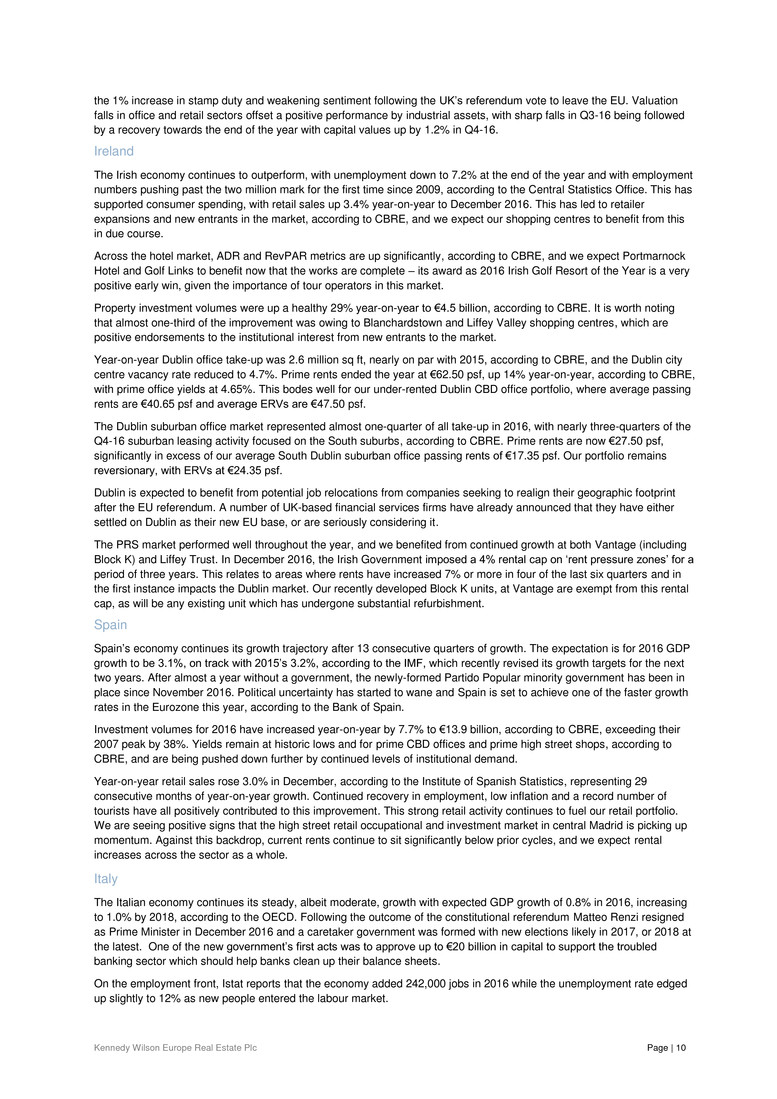
Kennedy Wilson Europe Real Estate Plc Page | 10 the 1% increase in stamp duty and weakening sentiment following the UK’s referendum vote to leave the EU. Valuation falls in office and retail sectors offset a positive performance by industrial assets, with sharp falls in Q3-16 being followed by a recovery towards the end of the year with capital values up by 1.2% in Q4-16. Ireland The Irish economy continues to outperform, with unemployment down to 7.2% at the end of the year and with employment numbers pushing past the two million mark for the first time since 2009, according to the Central Statistics Office. This has supported consumer spending, with retail sales up 3.4% year-on-year to December 2016. This has led to retailer expansions and new entrants in the market, according to CBRE, and we expect our shopping centres to benefit from this in due course. Across the hotel market, ADR and RevPAR metrics are up significantly, according to CBRE, and we expect Portmarnock Hotel and Golf Links to benefit now that the works are complete – its award as 2016 Irish Golf Resort of the Year is a very positive early win, given the importance of tour operators in this market. Property investment volumes were up a healthy 29% year-on-year to €4.5 billion, according to CBRE. It is worth noting that almost one-third of the improvement was owing to Blanchardstown and Liffey Valley shopping centres, which are positive endorsements to the institutional interest from new entrants to the market. Year-on-year Dublin office take-up was 2.6 million sq ft, nearly on par with 2015, according to CBRE, and the Dublin city centre vacancy rate reduced to 4.7%. Prime rents ended the year at €62.50 psf, up 14% year-on-year, according to CBRE, with prime office yields at 4.65%. This bodes well for our under-rented Dublin CBD office portfolio, where average passing rents are €40.65 psf and average ERVs are €47.50 psf. The Dublin suburban office market represented almost one-quarter of all take-up in 2016, with nearly three-quarters of the Q4-16 suburban leasing activity focused on the South suburbs, according to CBRE. Prime rents are now €27.50 psf, significantly in excess of our average South Dublin suburban office passing rents of €17.35 psf. Our portfolio remains reversionary, with ERVs at €24.35 psf. Dublin is expected to benefit from potential job relocations from companies seeking to realign their geographic footprint after the EU referendum. A number of UK-based financial services firms have already announced that they have either settled on Dublin as their new EU base, or are seriously considering it. The PRS market performed well throughout the year, and we benefited from continued growth at both Vantage (including Block K) and Liffey Trust. In December 2016, the Irish Government imposed a 4% rental cap on ‘rent pressure zones’ for a period of three years. This relates to areas where rents have increased 7% or more in four of the last six quarters and in the first instance impacts the Dublin market. Our recently developed Block K units, at Vantage are exempt from this rental cap, as will be any existing unit which has undergone substantial refurbishment. Spain Spain’s economy continues its growth trajectory after 13 consecutive quarters of growth. The expectation is for 2016 GDP growth to be 3.1%, on track with 2015’s 3.2%, according to the IMF, which recently revised its growth targets for the next two years. After almost a year without a government, the newly-formed Partido Popular minority government has been in place since November 2016. Political uncertainty has started to wane and Spain is set to achieve one of the faster growth rates in the Eurozone this year, according to the Bank of Spain. Investment volumes for 2016 have increased year-on-year by 7.7% to €13.9 billion, according to CBRE, exceeding their 2007 peak by 38%. Yields remain at historic lows and for prime CBD offices and prime high street shops, according to CBRE, and are being pushed down further by continued levels of institutional demand. Year-on-year retail sales rose 3.0% in December, according to the Institute of Spanish Statistics, representing 29 consecutive months of year-on-year growth. Continued recovery in employment, low inflation and a record number of tourists have all positively contributed to this improvement. This strong retail activity continues to fuel our retail portfolio. We are seeing positive signs that the high street retail occupational and investment market in central Madrid is picking up momentum. Against this backdrop, current rents continue to sit significantly below prior cycles, and we expect rental increases across the sector as a whole. Italy The Italian economy continues its steady, albeit moderate, growth with expected GDP growth of 0.8% in 2016, increasing to 1.0% by 2018, according to the OECD. Following the outcome of the constitutional referendum Matteo Renzi resigned as Prime Minister in December 2016 and a caretaker government was formed with new elections likely in 2017, or 2018 at the latest. One of the new government’s first acts was to approve up to €20 billion in capital to support the troubled banking sector which should help banks clean up their balance sheets. On the employment front, Istat reports that the economy added 242,000 jobs in 2016 while the unemployment rate edged up slightly to 12% as new people entered the labour market.

Kennedy Wilson Europe Real Estate Plc Page | 11 Despite the political instability, the investment market continues to improve with total transaction volume of €9.1 billion in 2016, according to CBRE, a 12% increase over the prior year. While the investment market continues to be dominated by international investors, domestic investors have become significantly more active, bringing additional liquidity to the market. Investor focus continues to be on the office market, particularly Milan, where CBRE reports prime office yields of 3.75%, a 25 basis point decrease over the prior year. Annual absorption was 304,000 sq m, 7% above the 10-year average and helping generate a 2% increase in prime office rents to €500psm per annum, according to CBRE. The Rome market is also improving with annual take-up of 150,000 sq m, a 43% increase over the prior year, and CBRE also reports that prime rents in the CBD and EUR submarkets increased by 5.3% and 3.1%, respectively, over the prior year. The ongoing improvement in both the occupational and investment markets should positively affect our Rome and Milan office assets, which account for a combined c. 60% of our Italian portfolio, by value.

Kennedy Wilson Europe Real Estate Plc Page | 12 Managing risks KWE’s approach to risk management At KWE, assessment of risk is a cornerstone of our strategy and our risk management framework is fundamental to its delivery. Our integrated approach reflects a combination of a top-down strategic view with complementary bottom-up operational processes. The top-down approach involves a review of the external environment in which we operate, to guide an assessment of the risks which we are comfortable exposing the business to in pursuit of our strategy. The bottom-up process involves the identification, management and monitoring of risks in each area of our business to ensure that risk management is embedded in the business operations and policies. Oversight of this process is provided through maintenance of a composite risk register at the Group-level as well as regional risk registers in target markets where we operate through regulated vehicles. This approach ensures that operational risks are fully considered in determining the risk appetite and corresponding strategy of the business. Board’s role in the process The Board is ultimately responsible for determining the nature and extent of the principal risks it is willing to take to achieve its strategic objectives. Its policy is to have systems in place which optimise the Company’s abil ity to manage risk in an effective and appropriate manner. By regularly reviewing the risk appetite of the business, the Board ensures that the risk exposure remains appropriate at any point in the cycle. Importantly the Board perceives risk not only as having a potential negative influence on the business but also as an opportunity for financial outperformance as we have access to the Investment Manager’s expertise to take and manage risks. As a property company in the post-Brexit world, exposure to risk is inherent in our business but is subject to an extensive range of mitigating controls. Audit Committee’s role in the process The Board has delegated responsibility for detailed assessment of the risk management process to the Audit Committee. At each quarterly meeting, the Audit Committee carries out a detailed review of the risk register, the control processes run by the Investment Manager, and the manner in which any required corrective action is to be taken by the Investment Manager and reports its findings to the Board. Investment Manager’s role in the process The Investment Manager acts as KWE’s Alternative Investment Fund Manager (AIFM) for the purposes of the Jersey Financial Services Commission’s (JFSC) The Alternate Investment Fund Managers Directive (AIFMD) related regulations, and is responsible for risk management. The Investment Manager is responsible for the ongoing process of identifying, evaluating, monitoring, and managing risks facing the business, together with maintaining controls to manage these risks. The Investment Manager in turn places reliance on its advisory teams to monitor and manage operational risk on an ongoing basis, as well as identifying emerging risks and putting appropriate responses in place. Risk registers, which exist at both the Group and regional levels where the Group invests through regulated vehicles, provide a framework for all staff of the Investment Manager group to contribute to delivering our strategy by recognising their shared responsibility for the effective management of risk. PRINCIPAL RISKS AND UNCERTAINTIES Macro-economic risks Risk Impact Mitigation General economic conditions Impact: Medium Likelihood: High Change on 2015: Increased - Low European growth and weak productivity indicators, coupled with the UK exit from the EU and an increase in protectionist rhetoric in the USA (albeit alongside an apparently expansionary fiscal policy) remain a concern in our current markets of operation - A slowdown in economic growth increases the risk of lower than expected rental levels, occupancy deterioration and asset valuation uncertainty - Regular review of the economic environment to assess whether any changes in outlook present risks, as well as opportunities, which impact execution of our strategy - Broad mandate to investment management team allowing for flexible approach to investing across real estate markets in Europe, with limited restrictions across asset class, sector or capital structure, resulting in risk diversification across the portfolio - High occupancy levels (95%) and long WAULT (7.1 years to first break), making any deterioration in the occupier market have a muted short-term effect on the Group’s turnover

Kennedy Wilson Europe Real Estate Plc Page | 13 Macro-economic risks (cont’d) Risk Impact Mitigation Availability of finance Impact: Low Likelihood: Low/Medium Change on 2015: Reduced - Reduced appetite for real estate lending may adversely affect our ability to refinance facilities and reduce our financing capacity for future investments - Diversified borrowings between secured and unsecured debt and a weighted average expiry of 6.1 years - BBB (stable) credit rating reaffirmed by S&P during the year - Strong relationships with our financing partners, credit rating agencies and advisors - Ready access to debt markets through EMTN programme Strategic risks Risk Impact Mitigation Failure to implement and poor execution of the investment strategy Impact: Medium/High Likelihood: Low Change on 2015: No change - Poor execution of our investment strategy could result in significant underperformance and reduced profitability. Specific execution risks include, among others: o timing of investment and divestment decisions o incorrect allocation of capital o exposure to any development risk or significant refurbishment programme o failure to implement the approved business plan o excessive exposure to one particular sector, asset, tenant or regional concentration - Benefits from strong investment sourcing capability: long-standing market relationships ensure access to future opportunities - Expert local knowledge, combined with significant and continued investment in people and infrastructure - Investment decisions subject to risk evaluation; post acquisition, continuous monitoring of KPIs, business plan targets and financial metrics Development and construction Impact: Medium Likelihood: Low Change on 2015: Reduced - Property development projects inherently carry risks with them. These include: o planning risk: the inability to secure planning consent due to political, legislative, regulatory and other risks inherent in the planning environment o construction risk: timing delays, reliance on third parties, including the risk of contractor failure, and additional cost overruns o occupier risk: occupiers may be reluctant to take space upon project completion - Currently no significant development project exposures. 15% NAV limits on aggregate development costs reducing the overall potential impact of development risk - Access to strong and experienced construction and development management team - Strong discipline of extensive consultation, design and technical work pre-project commencement - Assessment of market cycle and likely customer demand pre-commitment to new developments and pre-lets
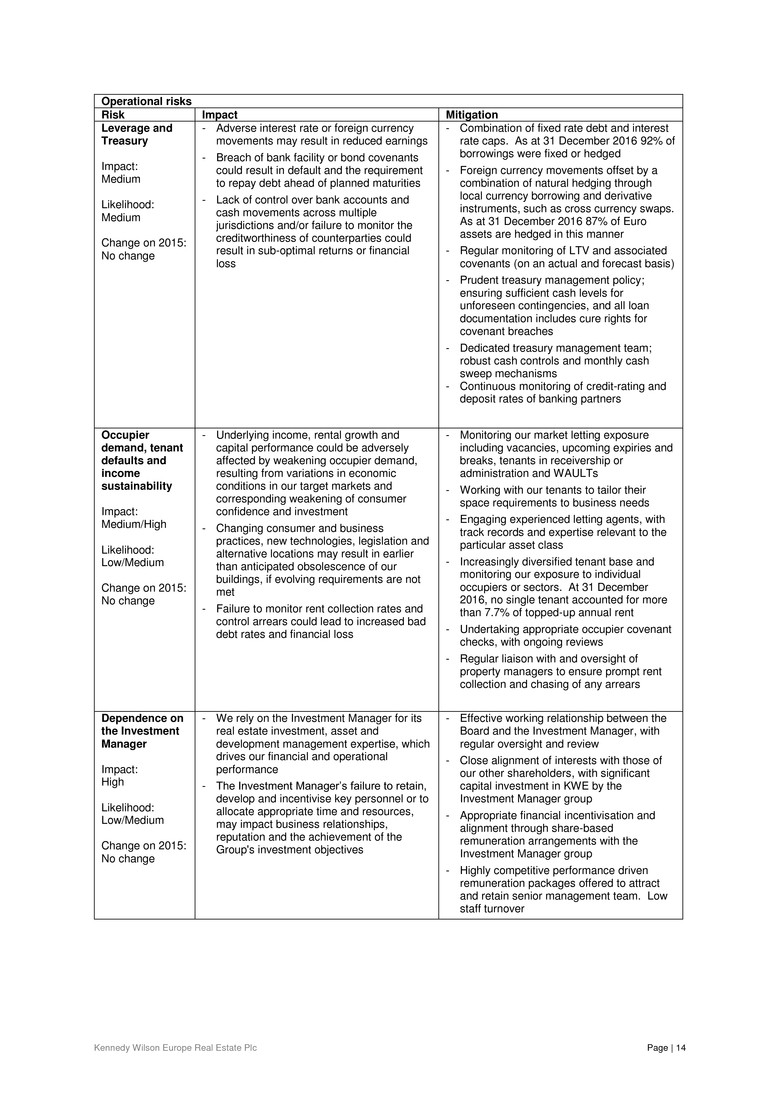
Kennedy Wilson Europe Real Estate Plc Page | 14 Operational risks Risk Impact Mitigation Leverage and Treasury Impact: Medium Likelihood: Medium Change on 2015: No change - Adverse interest rate or foreign currency movements may result in reduced earnings - Breach of bank facility or bond covenants could result in default and the requirement to repay debt ahead of planned maturities - Lack of control over bank accounts and cash movements across multiple jurisdictions and/or failure to monitor the creditworthiness of counterparties could result in sub-optimal returns or financial loss - Combination of fixed rate debt and interest rate caps. As at 31 December 2016 92% of borrowings were fixed or hedged - Foreign currency movements offset by a combination of natural hedging through local currency borrowing and derivative instruments, such as cross currency swaps. As at 31 December 2016 87% of Euro assets are hedged in this manner - Regular monitoring of LTV and associated covenants (on an actual and forecast basis) - Prudent treasury management policy; ensuring sufficient cash levels for unforeseen contingencies, and all loan documentation includes cure rights for covenant breaches - Dedicated treasury management team; robust cash controls and monthly cash sweep mechanisms - Continuous monitoring of credit-rating and deposit rates of banking partners Occupier demand, tenant defaults and income sustainability Impact: Medium/High Likelihood: Low/Medium Change on 2015: No change - Underlying income, rental growth and capital performance could be adversely affected by weakening occupier demand, resulting from variations in economic conditions in our target markets and corresponding weakening of consumer confidence and investment - Changing consumer and business practices, new technologies, legislation and alternative locations may result in earlier than anticipated obsolescence of our buildings, if evolving requirements are not met - Failure to monitor rent collection rates and control arrears could lead to increased bad debt rates and financial loss - Monitoring our market letting exposure including vacancies, upcoming expiries and breaks, tenants in receivership or administration and WAULTs - Working with our tenants to tailor their space requirements to business needs - Engaging experienced letting agents, with track records and expertise relevant to the particular asset class - Increasingly diversified tenant base and monitoring our exposure to individual occupiers or sectors. At 31 December 2016, no single tenant accounted for more than 7.7% of topped-up annual rent - Undertaking appropriate occupier covenant checks, with ongoing reviews - Regular liaison with and oversight of property managers to ensure prompt rent collection and chasing of any arrears Dependence on the Investment Manager Impact: High Likelihood: Low/Medium Change on 2015: No change - We rely on the Investment Manager for its real estate investment, asset and development management expertise, which drives our financial and operational performance - The Investment Manager’s failure to retain, develop and incentivise key personnel or to allocate appropriate time and resources, may impact business relationships, reputation and the achievement of the Group's investment objectives - Effective working relationship between the Board and the Investment Manager, with regular oversight and review - Close alignment of interests with those of our other shareholders, with significant capital investment in KWE by the Investment Manager group - Appropriate financial incentivisation and alignment through share-based remuneration arrangements with the Investment Manager group - Highly competitive performance driven remuneration packages offered to attract and retain senior management team. Low staff turnover
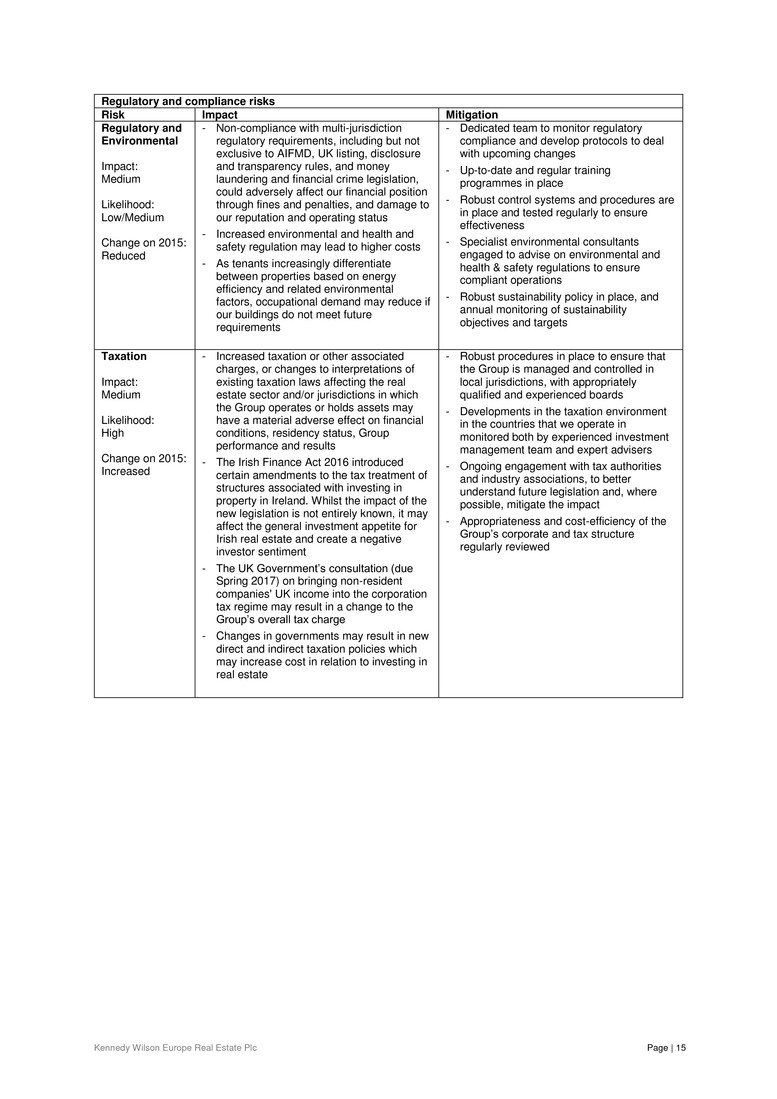
Kennedy Wilson Europe Real Estate Plc Page | 15 Regulatory and compliance risks Risk Impact Mitigation Regulatory and Environmental Impact: Medium Likelihood: Low/Medium Change on 2015: Reduced - Non-compliance with multi-jurisdiction regulatory requirements, including but not exclusive to AIFMD, UK listing, disclosure and transparency rules, and money laundering and financial crime legislation, could adversely affect our financial position through fines and penalties, and damage to our reputation and operating status - Increased environmental and health and safety regulation may lead to higher costs - As tenants increasingly differentiate between properties based on energy efficiency and related environmental factors, occupational demand may reduce if our buildings do not meet future requirements - Dedicated team to monitor regulatory compliance and develop protocols to deal with upcoming changes - Up-to-date and regular training programmes in place - Robust control systems and procedures are in place and tested regularly to ensure effectiveness - Specialist environmental consultants engaged to advise on environmental and health & safety regulations to ensure compliant operations - Robust sustainability policy in place, and annual monitoring of sustainability objectives and targets Taxation Impact: Medium Likelihood: High Change on 2015: Increased - Increased taxation or other associated charges, or changes to interpretations of existing taxation laws affecting the real estate sector and/or jurisdictions in which the Group operates or holds assets may have a material adverse effect on financial conditions, residency status, Group performance and results - The Irish Finance Act 2016 introduced certain amendments to the tax treatment of structures associated with investing in property in Ireland. Whilst the impact of the new legislation is not entirely known, it may affect the general investment appetite for Irish real estate and create a negative investor sentiment - The UK Government’s consultation (due Spring 2017) on bringing non-resident companies' UK income into the corporation tax regime may result in a change to the Group’s overall tax charge - Changes in governments may result in new direct and indirect taxation policies which may increase cost in relation to investing in real estate - Robust procedures in place to ensure that the Group is managed and controlled in local jurisdictions, with appropriately qualified and experienced boards - Developments in the taxation environment in the countries that we operate in monitored both by experienced investment management team and expert advisers - Ongoing engagement with tax authorities and industry associations, to better understand future legislation and, where possible, mitigate the impact - Appropriateness and cost-efficiency of the Group’s corporate and tax structure regularly reviewed
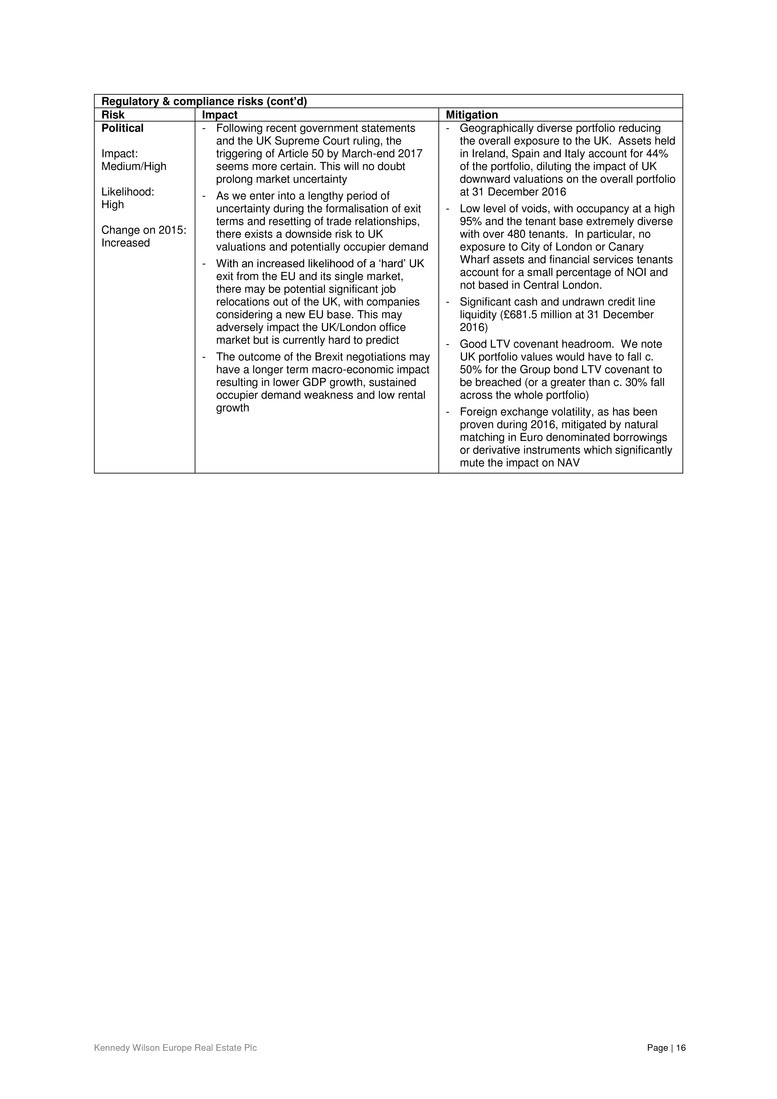
Kennedy Wilson Europe Real Estate Plc Page | 16 Regulatory & compliance risks (cont’d) Risk Impact Mitigation Political Impact: Medium/High Likelihood: High Change on 2015: Increased - Following recent government statements and the UK Supreme Court ruling, the triggering of Article 50 by March-end 2017 seems more certain. This will no doubt prolong market uncertainty - As we enter into a lengthy period of uncertainty during the formalisation of exit terms and resetting of trade relationships, there exists a downside risk to UK valuations and potentially occupier demand - With an increased likelihood of a ‘hard’ UK exit from the EU and its single market, there may be potential significant job relocations out of the UK, with companies considering a new EU base. This may adversely impact the UK/London office market but is currently hard to predict - The outcome of the Brexit negotiations may have a longer term macro-economic impact resulting in lower GDP growth, sustained occupier demand weakness and low rental growth - Geographically diverse portfolio reducing the overall exposure to the UK. Assets held in Ireland, Spain and Italy account for 44% of the portfolio, diluting the impact of UK downward valuations on the overall portfolio at 31 December 2016 - Low level of voids, with occupancy at a high 95% and the tenant base extremely diverse with over 480 tenants. In particular, no exposure to City of London or Canary Wharf assets and financial services tenants account for a small percentage of NOI and not based in Central London. - Significant cash and undrawn credit line liquidity (£681.5 million at 31 December 2016) - Good LTV covenant headroom. We note UK portfolio values would have to fall c. 50% for the Group bond LTV covenant to be breached (or a greater than c. 30% fall across the whole portfolio) - Foreign exchange volatility, as has been proven during 2016, mitigated by natural matching in Euro denominated borrowings or derivative instruments which significantly mute the impact on NAV

Kennedy Wilson Europe Real Estate Plc Page | 17 Finance review Table 6: Financial key performance indicators (KPIs) 31 December 2016 31 December 2015 Total accounting return (%) 7.6 18.0 Adjusted NAV per share (p) 1,215.9 1,174.5 Adjusted earnings per share (p) 55.2 47.9 Dividends paid (p) 48.0 35.0 LTV (%) 42.8 39.7 Weighted average cost of debt (%) 3.0 2.9 Overview The 2016 financial results reflect continued positive profits and earnings growth. NOI grew to £160.3 million, an increase of 23% on the prior year primarily owing to the benefit of acquisitions along with successful leasing levels; partly offset by disposals activity. This resulted in increased adjusted earnings of 55.2 pence per share, a 15.2% increase on 2015. Increased earnings have been reflected in dividend levels paid in the year which amounted to 48.0 pence per share, 2015: 35.0 pence per share, a 37% year on year increase and meeting the target we set last year. The dividend cover from adjusted earnings was 1.1 times during 2016. The first interim dividend of 2017 declared by the Board of 12.0 pence per share will continue to provide a sustainable and attractive dividend yield for our investors. The total accounting return for the year was 7.6% which was the combination of NAV per share growth primarily driven by the accretive share buyback programme, solid retained earnings as well as a small element of foreign exchange gain plus dividends paid, which contributed 4.1% to the total return. In June 2016, our investment grade credit rating was reaffirmed by S&P and we have continued to actively manage our debt profile to increase the mix of unsecured debt. This was achieved through a successful £200 million tap of our 2022 £300 million notes which were issued in June 2015 and a €150 million tap of our 2025 €400 million notes issued in November 2015. Secured debt principal totalling £230.0 million was repaid in the year and, as a consequence, unsecured debt represents 57% of all debt drawn at year end. This positive financing activity has resulted in our average term to maturity increasing to 6.1 years (2015: 5.9 years). Our weighted average cost of debt is a competitive 3.0% which also enjoys a high level of certainty given 92% of borrowings are fixed rate or hedged by way of interest rate caps. In September 2016, we announced a share buyback programme of £100 million which completed on 28 November. This added 1.2% to the NAV per share return in the year and demonstrates our ongoing commitment to proactive balance sheet management. Net operating income Net operating income consists of net rental income, the hotel earnings and loan portfolio interest income. The chief drivers of the notable net operating income growth in the year are the full period impact of acquisitions completed in 2015 and part period impact of those acquisitions completed in the year, along with a successful level of leasing activity. This was partly offset by increased disposals for 2016, in excess of our targets. Administrative expenses Total administrative expenses (excluding hotel operations, which are included in NOI) are £11.6 million (2015: £10.9 million). A significant proportion of the expenses are fixed in nature which means that as the Group has become more fully invested the administrative expenses as a percentage of NOI have dropped to 7.2% from 8.4% in 2015. The cost to portfolio value ratio of 40bps is in-line with the expectation at the half-year. Investment Management fees Investment Manager fees The Investment Manager receives a management fee at an annual rate of 1.0% of the Group’s EPRA NAV, payable quarterly. The fee is settled 50% in cash and 50% in shares, in line with the investment management agreement. Where the prevailing share price is at a discount to IFRS NAV, an amount equivalent to the fee is applied insofar as possible towards market purchases of existing shares. The total management fee for 2016 is £16.3 million (2015: £15.2 million). The management fee in respect of the fourth quarter is £3.9 million, where the 50% share component is expected to be settled through market purchases of existing shares.
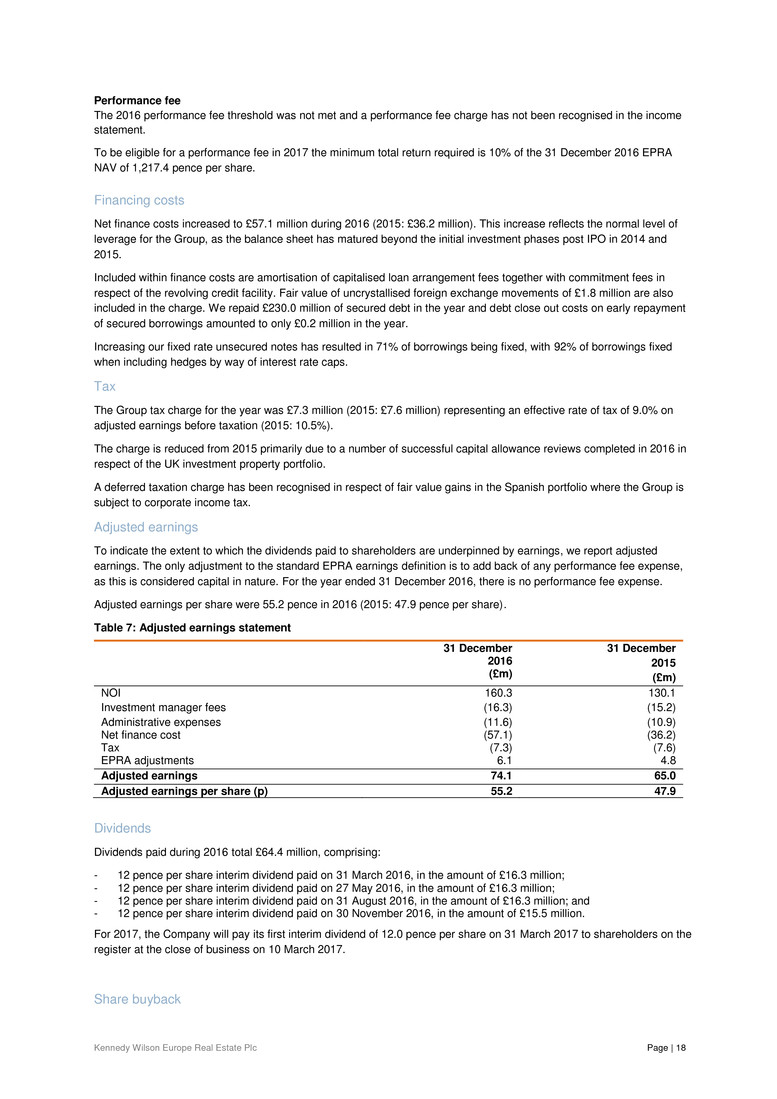
Kennedy Wilson Europe Real Estate Plc Page | 18 Performance fee The 2016 performance fee threshold was not met and a performance fee charge has not been recognised in the income statement. To be eligible for a performance fee in 2017 the minimum total return required is 10% of the 31 December 2016 EPRA NAV of 1,217.4 pence per share. Financing costs Net finance costs increased to £57.1 million during 2016 (2015: £36.2 million). This increase reflects the normal level of leverage for the Group, as the balance sheet has matured beyond the initial investment phases post IPO in 2014 and 2015. Included within finance costs are amortisation of capitalised loan arrangement fees together with commitment fees in respect of the revolving credit facility. Fair value of uncrystallised foreign exchange movements of £1.8 million are also included in the charge. We repaid £230.0 million of secured debt in the year and debt close out costs on early repayment of secured borrowings amounted to only £0.2 million in the year. Increasing our fixed rate unsecured notes has resulted in 71% of borrowings being fixed, with 92% of borrowings fixed when including hedges by way of interest rate caps. Tax The Group tax charge for the year was £7.3 million (2015: £7.6 million) representing an effective rate of tax of 9.0% on adjusted earnings before taxation (2015: 10.5%). The charge is reduced from 2015 primarily due to a number of successful capital allowance reviews completed in 2016 in respect of the UK investment property portfolio. A deferred taxation charge has been recognised in respect of fair value gains in the Spanish portfolio where the Group is subject to corporate income tax. Adjusted earnings To indicate the extent to which the dividends paid to shareholders are underpinned by earnings, we report adjusted earnings. The only adjustment to the standard EPRA earnings definition is to add back of any performance fee expense, as this is considered capital in nature. For the year ended 31 December 2016, there is no performance fee expense. Adjusted earnings per share were 55.2 pence in 2016 (2015: 47.9 pence per share). Table 7: Adjusted earnings statement 31 December 2016 (£m) 31 December 2015 (£m) NOI 160.3 130.1 Investment manager fees (16.3) (15.2) Administrative expenses (11.6) (10.9) Net finance cost (57.1) (36.2) Tax (7.3) (7.6) EPRA adjustments 6.1 4.8 Adjusted earnings 74.1 65.0 Adjusted earnings per share (p) 55.2 47.9 Dividends Dividends paid during 2016 total £64.4 million, comprising: - 12 pence per share interim dividend paid on 31 March 2016, in the amount of £16.3 million; - 12 pence per share interim dividend paid on 27 May 2016, in the amount of £16.3 million; - 12 pence per share interim dividend paid on 31 August 2016, in the amount of £16.3 million; and - 12 pence per share interim dividend paid on 30 November 2016, in the amount of £15.5 million. For 2017, the Company will pay its first interim dividend of 12.0 pence per share on 31 March 2017 to shareholders on the register at the close of business on 10 March 2017. Share buyback

Kennedy Wilson Europe Real Estate Plc Page | 19 Part of our rigorous capital management is considering not just the appropriate debt mix, cost and leverage but also equity management, particularly when in the Board’s opinion there is a disconnect between the prevailing KWE share price and the underlying business fundamentals. The successful completion of the £100 million share buyback programme in November 2016 saw 9,800,531 shares bought at an average price of 1,020 pence per share, and cancelled. This constituted 7.2% of issued share capital. The buyback crystallised for investors the benefit of a 17.7% discount to preceding September 2016 adjusted NAV of 1,240 pence per share. The buyback was accretive to both NAV per share and earnings per share; the NAV per share movement in 2016 was enhanced by 1.2% and we expect the benefit to earnings per share growth, on an annualised pro forma basis, to be 7.8%. Balance Sheet Table 8: Balance sheet 31 December 2016 (£m) 31 December 2015 (£m) Portfolio value 2,882.2 2,792.7 Cash 456.5 326.5 Gross debt (1,691.3) (1,436.1) Other assets and liabilities (111.5) (53.9) IFRS net assets 1,535.9 1,629.2 Adjusted for: Mark-to-market of derivative financial assets (0.3) (0.9) EPRA net assets 1,535.6 1,628.3 Adjust for share based payment reserve: Performance fee: - (29.7) Investment management fee (1.9) (2.1) Adjusted net assets 1,533.7 1,596.5 Adjusted NAV per share (p) 1,215.9 1,174.5 Portfolio valuation As at 31 December 2016, the investment portfolio value was £2,882.2 million, reflecting net selling activity in the year, offset by foreign exchange gains. Notably, the small negative valuation movement was only £8.6 million or -0.3%, reflecting strong performance of our Euro assets (+£69.0 million) offsetting falls in the UK (-£77.6 million), illustrating the benefits of our geographically diversified portfolio. Table 9: Portfolio valuation movements 2015 portfolio valuation 2,792.7 Valuation movement (8.6) Acquisitions 189.2 Disposals (362.9) Capital expenditure 106.7 Foreign exchange/other 165.1 2016 portfolio valuation 2,882.2 Adjusted NAV We report Adjusted NAV to illustrate EPRA NAV after the impact of the fees recognised in the share-based payments reserve. The 3.5% Adjusted NAV per share growth reflects retained earnings, including gains on sale from disposals, which reflected a 4.8% premium over preceding valuation, and the benefit of the share buyback. Foreign exchange also contributed but comparing to the portfolio level gain it is clear that our hedging policy worked well during the year to significantly reduce the impact of substantial Euro strengthening. At year end, 87% of Euro assets were hedged, 66% through local currency borrowing and 21% through derivative instruments.

Kennedy Wilson Europe Real Estate Plc Page | 20 Table 10: EPRA NAV movements (£m) (p per share) 2015 adjusted NAV 1,596.5 1,174.5 Valuation movement (8.6) Gains on sale 8.5 Adjusted earnings 74.1 Dividends (64.4) Share buyback (100.0) Foreign exchange/other 27.6 2016 adjusted NAV 1,533.7 1,215.9 Cash flow and treasury management Liquidity, comprising cash and undrawn facilities, totals £681.5 million at 31 December 2016, compared with £551.5 million at 31 December 2015. The major sources of cash during the year were: - Proceeds from predominantly unsecured financing activity of £391.6 million - Proceeds on disposal of assets, which generated cash of £371.6 million KWE maintains a £225.0 million multi-currency revolving credit facility. At 31 December 2016, the full £225.0 million facility was available to be drawn. The Group’s interest rate hedging policy is to eliminate substantially the risk associated with interest rate vo latility, through a combination of fixed rate borrowings and, in respect of floating rate debt, the use of interest rate caps. Financing activity Table 11: Key debt measures 2016 2015 Gross debt (£m) 1,691.3 1,436.1 Cash (£m) 456.5 326.5 Undrawn facilities (£m) 225.0 225.0 LTV (%) 42.8 39.7 Cost of debt (%) 3.0 2.9 Fixed rate or hedged debt proportion (%) 92.0 85.0 Fixed charge cover (x) 2.4 2.9 Continuing our strategy to increase the mix of unsecured debt, on 19 April 2016 we completed a €150 million tap to the €400 million outstanding senior unsecured notes issued by KWE under its EMTN Programme established in November 2015 creating a benchmark size of €550 million. These new notes were issued at a yield of 3.039%. On 10 June 10 2016 Standard & Poor’s affirmed its 'BBB' long-term corporate credit ratings for KWE and its listed Euro and Sterling bonds. The stable outlook reflected the benefit of our diverse portfolio of real estate assets supporting stable cash flows and ample interest cover, as well as relatively low debt maturities in the coming years, coupled with a high level of available liquidity sources. We successfully issued a £200 million tap on 19 September 2016 at an issue yield of 3.572%. This increased the aggregate principal amount of our 2022 £300 million notes which were issued in June 2015 to £500 million. £135.8 million of bond proceeds were voluntarily used to repay certain secured borrowings. A further £94.2 million debt was repaid from the disposal of secured assets. At 31 December 2016, LTV stood at 42.8%, well within our long term target range of 40%-45%. The fixed charge cover (the ratio of adjusted earnings before finance costs to finance costs) for the year was a comfortable 2.4 times. Throughout 2016 and as at 31 December 2016, the Group reported compliance with its debt covenants. Exchange rate: Where Balance Sheet amounts in this document are presented in both £ and €, the £ amount has been calculated based on an exchange rate of €1: £0.85352, which was the rate on 31 December 2016. Income Statement amounts were translated at the average rate for the year.

Kennedy Wilson Europe Real Estate Plc Page | 21 Responsibility statement of the Directors The responsibility statement has been prepared in connection with the Company's full annual report for the year ended 31 December 2016. Certain parts of the annual report are not included in this announcement. We confirm that to the best of our knowledge: the consolidated financial statements, prepared in accordance with IFRS, give a true and fair view of the assets, liabilities, financial position and profit or loss of the Company and the undertakings included in the consolidation taken as a whole the management report, to be contained in the 2016 annual report, includes a fair review of the development and performance of the business and the position of the Company and the undertakings included in the consolidation taken as a whole, together with a description of the principal risks and uncertainties that they face By order of the Board Charlotte Valeur Chair Simon Radford Director 23 February 2017
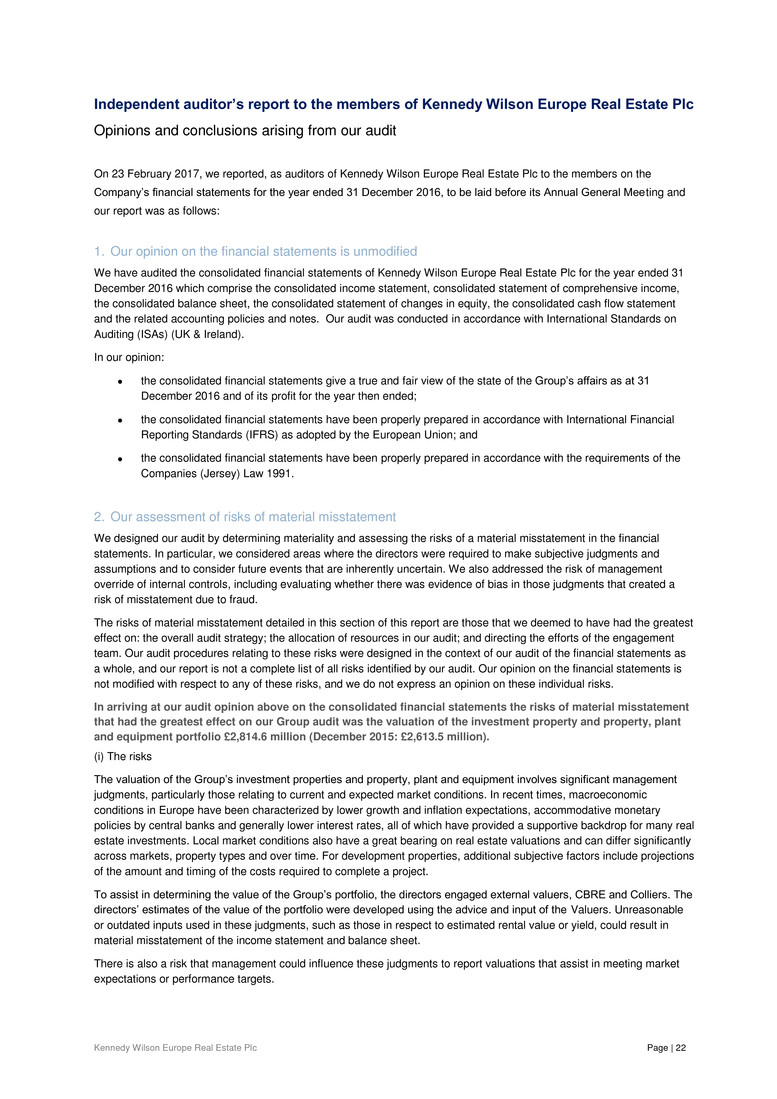
Kennedy Wilson Europe Real Estate Plc Page | 22 Independent auditor’s report to the members of Kennedy Wilson Europe Real Estate Plc Opinions and conclusions arising from our audit On 23 February 2017, we reported, as auditors of Kennedy Wilson Europe Real Estate Plc to the members on the Company’s financial statements for the year ended 31 December 2016, to be laid before its Annual General Meeting and our report was as follows: 1. Our opinion on the financial statements is unmodified We have audited the consolidated financial statements of Kennedy Wilson Europe Real Estate Plc for the year ended 31 December 2016 which comprise the consolidated income statement, consolidated statement of comprehensive income, the consolidated balance sheet, the consolidated statement of changes in equity, the consolidated cash flow statement and the related accounting policies and notes. Our audit was conducted in accordance with International Standards on Auditing (ISAs) (UK & Ireland). In our opinion: the consolidated financial statements give a true and fair view of the state of the Group’s affairs as at 31 December 2016 and of its profit for the year then ended; the consolidated financial statements have been properly prepared in accordance with International Financial Reporting Standards (IFRS) as adopted by the European Union; and the consolidated financial statements have been properly prepared in accordance with the requirements of the Companies (Jersey) Law 1991. 2. Our assessment of risks of material misstatement We designed our audit by determining materiality and assessing the risks of a material misstatement in the financial statements. In particular, we considered areas where the directors were required to make subjective judgments and assumptions and to consider future events that are inherently uncertain. We also addressed the risk of management override of internal controls, including evaluating whether there was evidence of bias in those judgments that created a risk of misstatement due to fraud. The risks of material misstatement detailed in this section of this report are those that we deemed to have had the greatest effect on: the overall audit strategy; the allocation of resources in our audit; and directing the efforts of the engagement team. Our audit procedures relating to these risks were designed in the context of our audit of the financial statements as a whole, and our report is not a complete list of all risks identified by our audit. Our opinion on the financial statements is not modified with respect to any of these risks, and we do not express an opinion on these individual risks. In arriving at our audit opinion above on the consolidated financial statements the risks of material misstatement that had the greatest effect on our Group audit was the valuation of the investment property and property, plant and equipment portfolio £2,814.6 million (December 2015: £2,613.5 million). (i) The risks The valuation of the Group’s investment properties and property, plant and equipment involves significant management judgments, particularly those relating to current and expected market conditions. In recent times, macroeconomic conditions in Europe have been characterized by lower growth and inflation expectations, accommodative monetary policies by central banks and generally lower interest rates, all of which have provided a supportive backdrop for many real estate investments. Local market conditions also have a great bearing on real estate valuations and can differ significantly across markets, property types and over time. For development properties, additional subjective factors include projections of the amount and timing of the costs required to complete a project. To assist in determining the value of the Group’s portfolio, the directors engaged external valuers, CBRE and Colliers. The directors’ estimates of the value of the portfolio were developed using the advice and input of the Valuers. Unreasonable or outdated inputs used in these judgments, such as those in respect to estimated rental value or yield, could result in material misstatement of the income statement and balance sheet. There is also a risk that management could influence these judgments to report valuations that assist in meeting market expectations or performance targets.
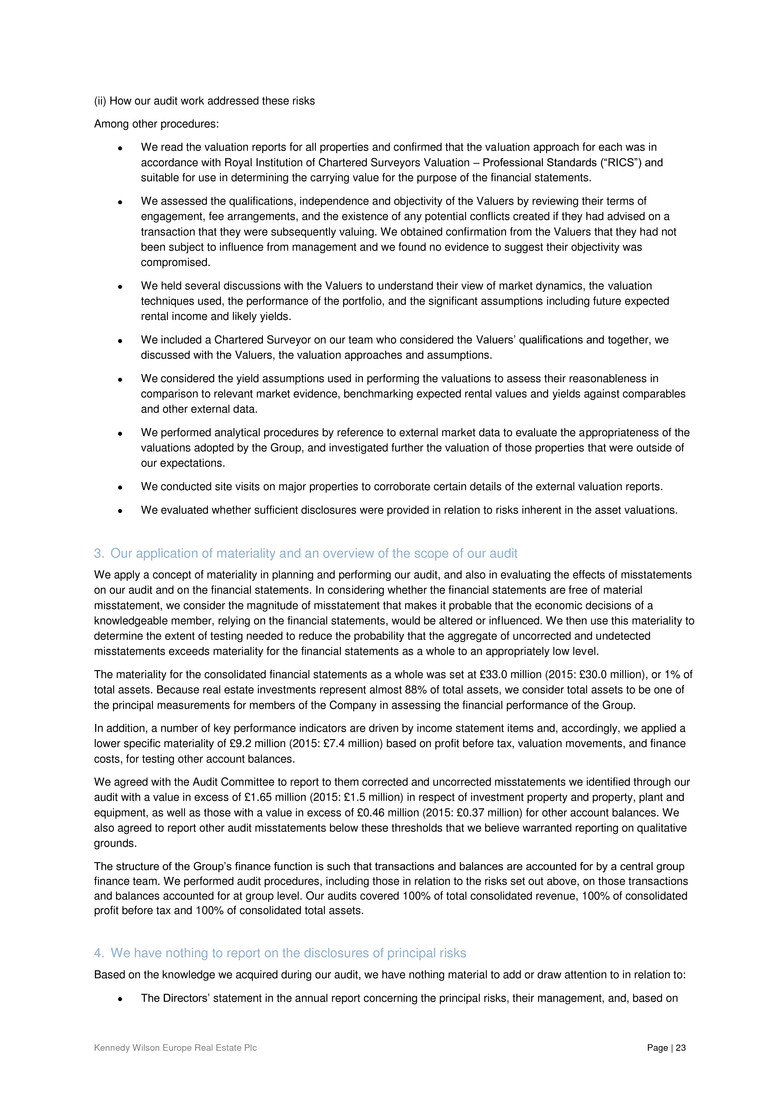
Kennedy Wilson Europe Real Estate Plc Page | 23 (ii) How our audit work addressed these risks Among other procedures: We read the valuation reports for all properties and confirmed that the valuation approach for each was in accordance with Royal Institution of Chartered Surveyors Valuation – Professional Standards (“RICS”) and suitable for use in determining the carrying value for the purpose of the financial statements. We assessed the qualifications, independence and objectivity of the Valuers by reviewing their terms of engagement, fee arrangements, and the existence of any potential conflicts created if they had advised on a transaction that they were subsequently valuing. We obtained confirmation from the Valuers that they had not been subject to influence from management and we found no evidence to suggest their objectivity was compromised. We held several discussions with the Valuers to understand their view of market dynamics, the valuation techniques used, the performance of the portfolio, and the significant assumptions including future expected rental income and likely yields. We included a Chartered Surveyor on our team who considered the Valuers’ qualifications and together, we discussed with the Valuers, the valuation approaches and assumptions. We considered the yield assumptions used in performing the valuations to assess their reasonableness in comparison to relevant market evidence, benchmarking expected rental values and yields against comparables and other external data. We performed analytical procedures by reference to external market data to evaluate the appropriateness of the valuations adopted by the Group, and investigated further the valuation of those properties that were outside of our expectations. We conducted site visits on major properties to corroborate certain details of the external valuation reports. We evaluated whether sufficient disclosures were provided in relation to risks inherent in the asset valuations. 3. Our application of materiality and an overview of the scope of our audit We apply a concept of materiality in planning and performing our audit, and also in evaluating the effects of misstatements on our audit and on the financial statements. In considering whether the financial statements are free of material misstatement, we consider the magnitude of misstatement that makes it probable that the economic decisions of a knowledgeable member, relying on the financial statements, would be altered or influenced. We then use this materiality to determine the extent of testing needed to reduce the probability that the aggregate of uncorrected and undetected misstatements exceeds materiality for the financial statements as a whole to an appropriately low level. The materiality for the consolidated financial statements as a whole was set at £33.0 million (2015: £30.0 million), or 1% of total assets. Because real estate investments represent almost 88% of total assets, we consider total assets to be one of the principal measurements for members of the Company in assessing the financial performance of the Group. In addition, a number of key performance indicators are driven by income statement items and, accordingly, we applied a lower specific materiality of £9.2 million (2015: £7.4 million) based on profit before tax, valuation movements, and finance costs, for testing other account balances. We agreed with the Audit Committee to report to them corrected and uncorrected misstatements we identified through our audit with a value in excess of £1.65 million (2015: £1.5 million) in respect of investment property and property, plant and equipment, as well as those with a value in excess of £0.46 million (2015: £0.37 million) for other account balances. We also agreed to report other audit misstatements below these thresholds that we believe warranted reporting on qualitative grounds. The structure of the Group’s finance function is such that transactions and balances are accounted for by a central group finance team. We performed audit procedures, including those in relation to the risks set out above, on those transactions and balances accounted for at group level. Our audits covered 100% of total consolidated revenue, 100% of consolidated profit before tax and 100% of consolidated total assets. 4. We have nothing to report on the disclosures of principal risks Based on the knowledge we acquired during our audit, we have nothing material to add or draw attention to in relation to: The Directors’ statement in the annual report concerning the principal risks, their management, and, based on
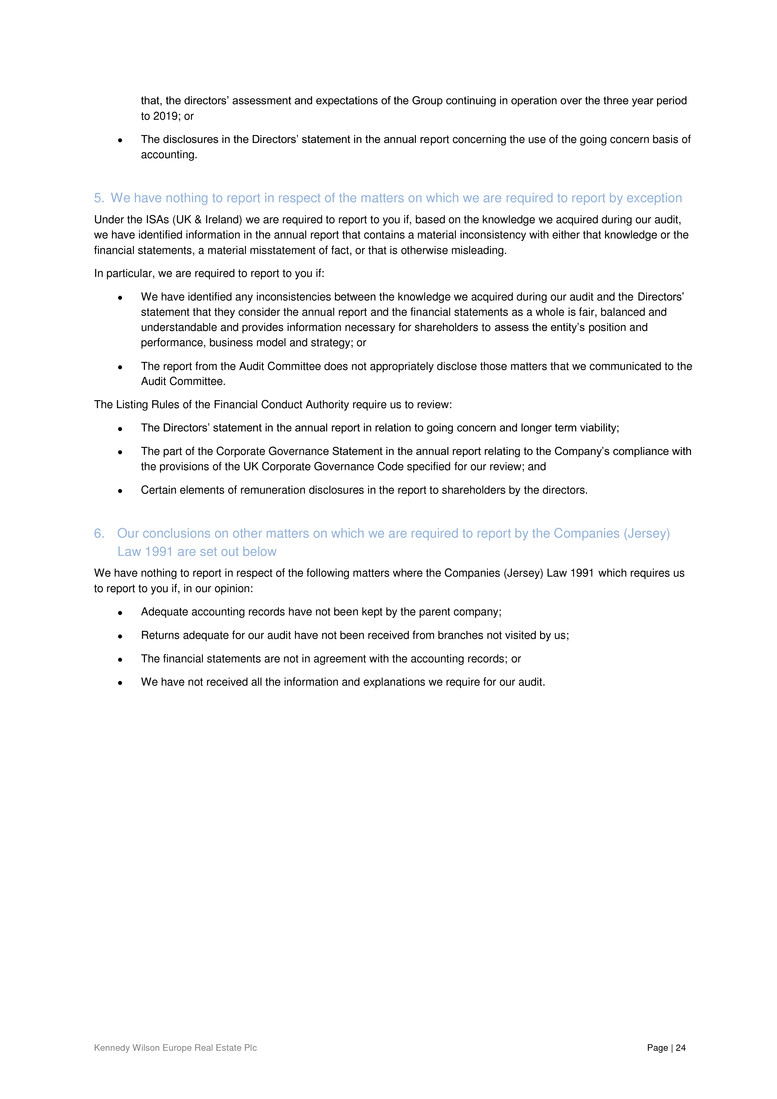
Kennedy Wilson Europe Real Estate Plc Page | 24 that, the directors’ assessment and expectations of the Group continuing in operation over the three year period to 2019; or The disclosures in the Directors’ statement in the annual report concerning the use of the going concern basis of accounting. 5. We have nothing to report in respect of the matters on which we are required to report by exception Under the ISAs (UK & Ireland) we are required to report to you if, based on the knowledge we acquired during our audit, we have identified information in the annual report that contains a material inconsistency with either that knowledge or the financial statements, a material misstatement of fact, or that is otherwise misleading. In particular, we are required to report to you if: We have identified any inconsistencies between the knowledge we acquired during our audit and the Directors’ statement that they consider the annual report and the financial statements as a whole is fair, balanced and understandable and provides information necessary for shareholders to assess the entity’s position and performance, business model and strategy; or The report from the Audit Committee does not appropriately disclose those matters that we communicated to the Audit Committee. The Listing Rules of the Financial Conduct Authority require us to review: The Directors’ statement in the annual report in relation to going concern and longer term viability; The part of the Corporate Governance Statement in the annual report relating to the Company’s compliance with the provisions of the UK Corporate Governance Code specified for our review; and Certain elements of remuneration disclosures in the report to shareholders by the directors. 6. Our conclusions on other matters on which we are required to report by the Companies (Jersey) Law 1991 are set out below We have nothing to report in respect of the following matters where the Companies (Jersey) Law 1991 which requires us to report to you if, in our opinion: Adequate accounting records have not been kept by the parent company; Returns adequate for our audit have not been received from branches not visited by us; The financial statements are not in agreement with the accounting records; or We have not received all the information and explanations we require for our audit.
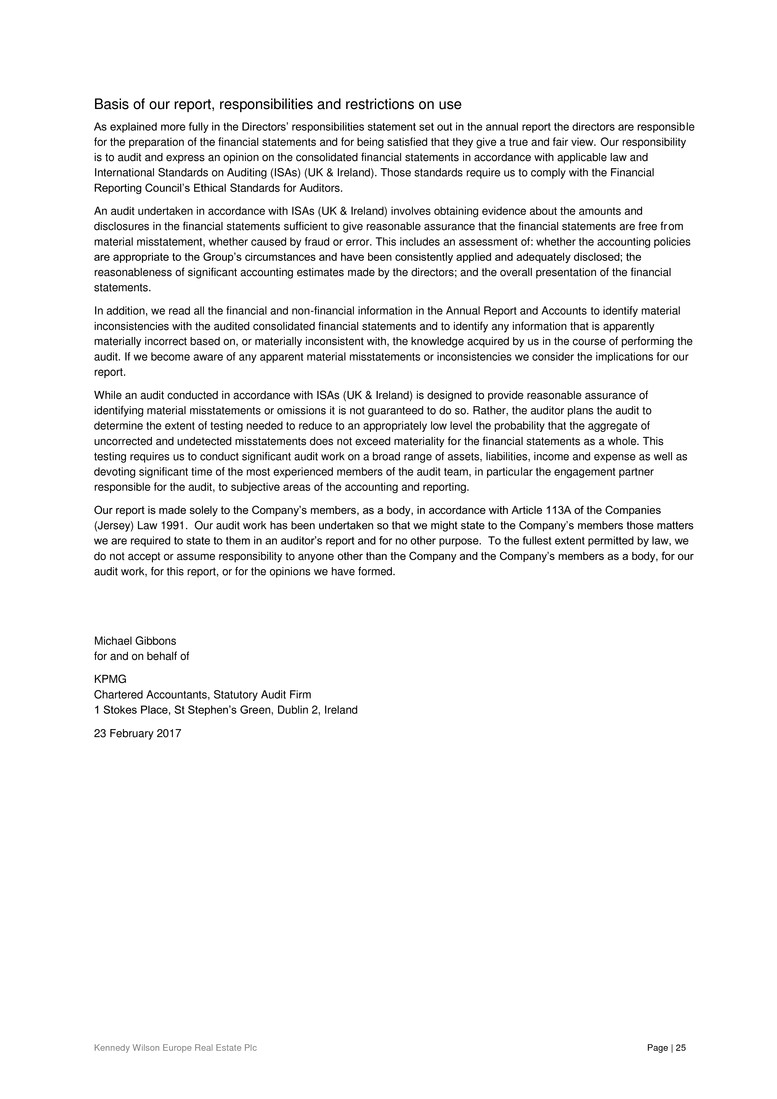
Kennedy Wilson Europe Real Estate Plc Page | 25 Basis of our report, responsibilities and restrictions on use As explained more fully in the Directors’ responsibilities statement set out in the annual report the directors are responsib le for the preparation of the financial statements and for being satisfied that they give a true and fair view. Our responsibility is to audit and express an opinion on the consolidated financial statements in accordance with applicable law and International Standards on Auditing (ISAs) (UK & Ireland). Those standards require us to comply with the Financial Reporting Council’s Ethical Standards for Auditors. An audit undertaken in accordance with ISAs (UK & Ireland) involves obtaining evidence about the amounts and disclosures in the financial statements sufficient to give reasonable assurance that the financial statements are free from material misstatement, whether caused by fraud or error. This includes an assessment of: whether the accounting policies are appropriate to the Group’s circumstances and have been consistently applied and adequately disclosed; the reasonableness of significant accounting estimates made by the directors; and the overall presentation of the financial statements. In addition, we read all the financial and non-financial information in the Annual Report and Accounts to identify material inconsistencies with the audited consolidated financial statements and to identify any information that is apparently materially incorrect based on, or materially inconsistent with, the knowledge acquired by us in the course of performing the audit. If we become aware of any apparent material misstatements or inconsistencies we consider the implications for our report. While an audit conducted in accordance with ISAs (UK & Ireland) is designed to provide reasonable assurance of identifying material misstatements or omissions it is not guaranteed to do so. Rather, the auditor plans the audit to determine the extent of testing needed to reduce to an appropriately low level the probability that the aggregate of uncorrected and undetected misstatements does not exceed materiality for the financial statements as a whole. This testing requires us to conduct significant audit work on a broad range of assets, liabilities, income and expense as well as devoting significant time of the most experienced members of the audit team, in particular the engagement partner responsible for the audit, to subjective areas of the accounting and reporting. Our report is made solely to the Company’s members, as a body, in accordance with Article 113A of the Companies (Jersey) Law 1991. Our audit work has been undertaken so that we might state to the Company’s members those matters we are required to state to them in an auditor’s report and for no other purpose. To the fullest extent permitted by law, we do not accept or assume responsibility to anyone other than the Company and the Company’s members as a body, for our audit work, for this report, or for the opinions we have formed. Michael Gibbons for and on behalf of KPMG Chartered Accountants, Statutory Audit Firm 1 Stokes Place, St Stephen’s Green, Dublin 2, Ireland 23 February 2017

Kennedy Wilson Europe Real Estate Plc Page | 26 Consolidated income statement Year ended 31 December 2016 Year ended 31 December 2015 Notes £m £m Revenue Rental income 7 191.5 138.8 Hotel revenue 10 19.4 20.0 Interest income from loans secured by real estate 13 6.3 13.4 217.2 172.2 Property related expenses 8 (35.8) (22.7) Hotel cost of sales 11 (16.3) (14.4) (52.1) (37.1) Gross profit 165.1 135.1 Gain on sale of investment and development property and loan collateral 9 8.5 14.6 Net change in fair value of investment and development property 17 (10.8) 208.0 Net change in fair value of loans secured by real estate 18 0.3 5.1 Other gains - 0.8 163.1 363.6 Expenses Administrative expenses 12 (16.4) (15.9) Investment management fee 31A(i) (16.3) (15.2) Performance fee 31A(ii) - (29.7) (32.7) (60.8) Results from operating activities before financing income and costs 130.4 302.8 Interest income from cash and cash equivalents 13 0.6 0.6 Finance costs 14 (57.7) (36.8) Net finance expense (57.1) (36.2) Profit before taxation 73.3 266.6 Taxation 15 (7.3) (7.6) Profit for the year after taxation 66.0 259.0 Earnings per share (basic & diluted) 16A 49.1p 191.0p The accompanying notes form an integral part of these consolidated financial statements.
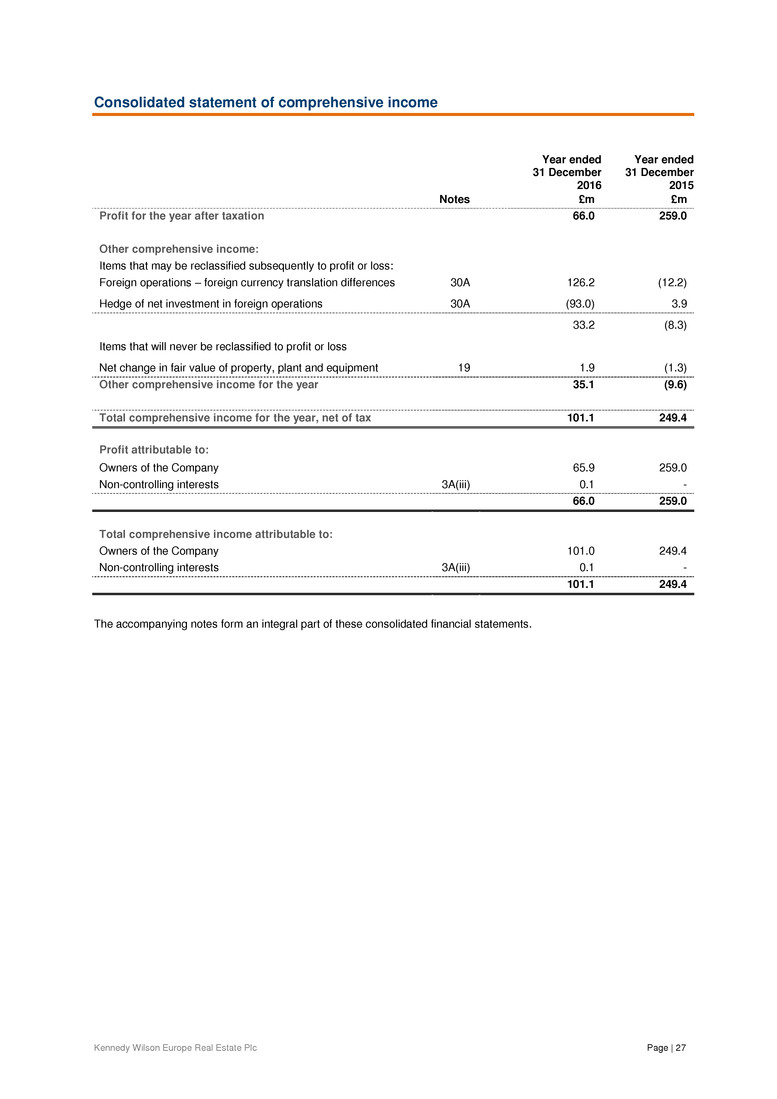
Kennedy Wilson Europe Real Estate Plc Page | 27 Consolidated statement of comprehensive income Year ended 31 December 2016 Year ended 31 December 2015 Notes £m £m Profit for the year after taxation 66.0 259.0 Other comprehensive income: Items that may be reclassified subsequently to profit or loss: Foreign operations – foreign currency translation differences 30A 126.2 (12.2) Hedge of net investment in foreign operations 30A (93.0) 3.9 33.2 (8.3) Items that will never be reclassified to profit or loss Net change in fair value of property, plant and equipment 19 1.9 (1.3) Other comprehensive income for the year 35.1 (9.6) Total comprehensive income for the year, net of tax 101.1 249.4 Profit attributable to: Owners of the Company 65.9 259.0 Non-controlling interests 3A(iii) 0.1 - 66.0 259.0 Total comprehensive income attributable to: Owners of the Company 101.0 249.4 Non-controlling interests 3A(iii) 0.1 - 101.1 249.4 The accompanying notes form an integral part of these consolidated financial statements.
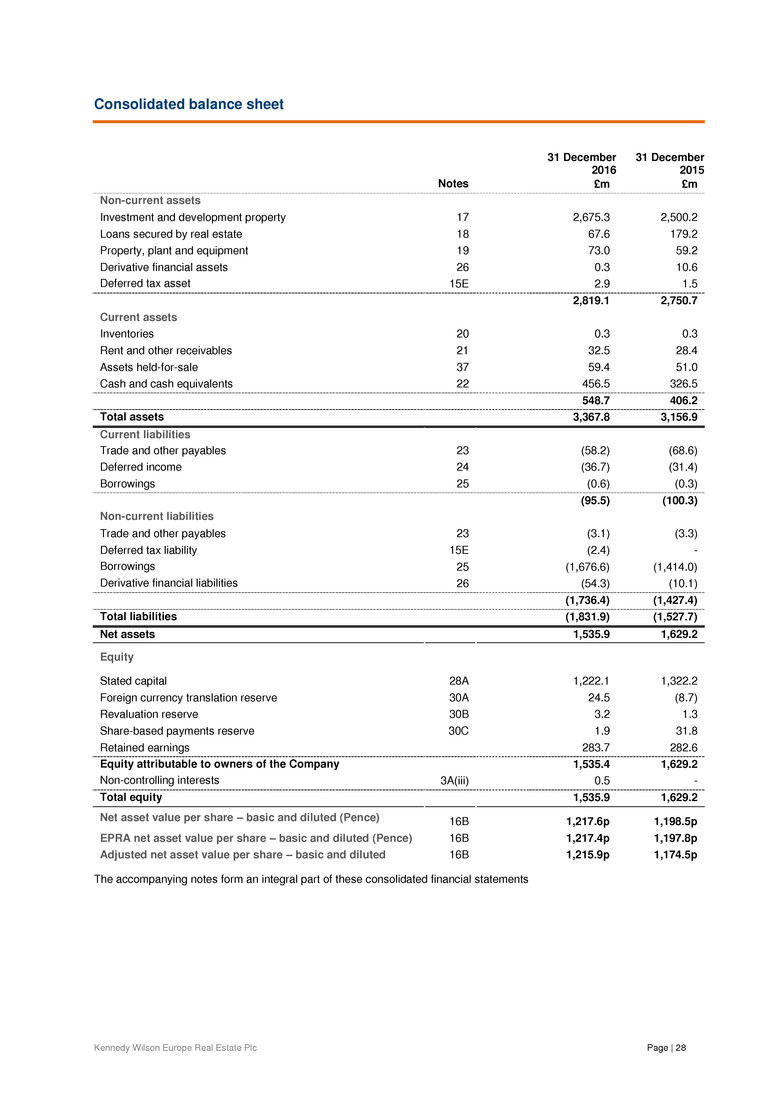
Kennedy Wilson Europe Real Estate Plc Page | 28 Consolidated balance sheet 31 December 2016 31 December 2015 Notes £m £m Non-current assets Investment and development property 17 2,675.3 2,500.2 Loans secured by real estate 18 67.6 179.2 Property, plant and equipment 19 73.0 59.2 Derivative financial assets 26 0.3 10.6 Deferred tax asset 15E 2.9 1.5 2,819.1 2,750.7 Current assets Inventories 20 0.3 0.3 Rent and other receivables 21 32.5 28.4 Assets held-for-sale 37 59.4 51.0 Cash and cash equivalents 22 456.5 326.5 548.7 406.2 Total assets 3,367.8 3,156.9 Current liabilities Trade and other payables 23 (58.2) (68.6) Deferred income 24 (36.7) (31.4) Borrowings 25 (0.6) (0.3) (95.5) (100.3) Non-current liabilities Trade and other payables 23 (3.1) (3.3) Deferred tax liability 15E (2.4) - Borrowings 25 (1,676.6) (1,414.0) Derivative financial liabilities 26 (54.3) (10.1) (1,736.4) (1,427.4) Total liabilities (1,831.9) (1,527.7) Net assets 1,535.9 1,629.2 Equity Stated capital 28A 1,222.1 1,322.2 Foreign currency translation reserve 30A 24.5 (8.7) Revaluation reserve 30B 3.2 1.3 Share-based payments reserve 30C 1.9 31.8 Retained earnings 283.7 282.6 Equity attributable to owners of the Company 1,535.4 1,629.2 Non-controlling interests 3A(iii) 0.5 - Total equity 1,535.9 1,629.2 Net asset value per share – basic and diluted (Pence) 16B 1,217.6p 1,198.5p EPRA net asset value per share – basic and diluted (Pence) 16B 1,217.4p 1,197.8p Adjusted net asset value per share – basic and diluted (Pence) 16B 1,215.9p 1,174.5p The accompanying notes form an integral part of these consolidated financial statements
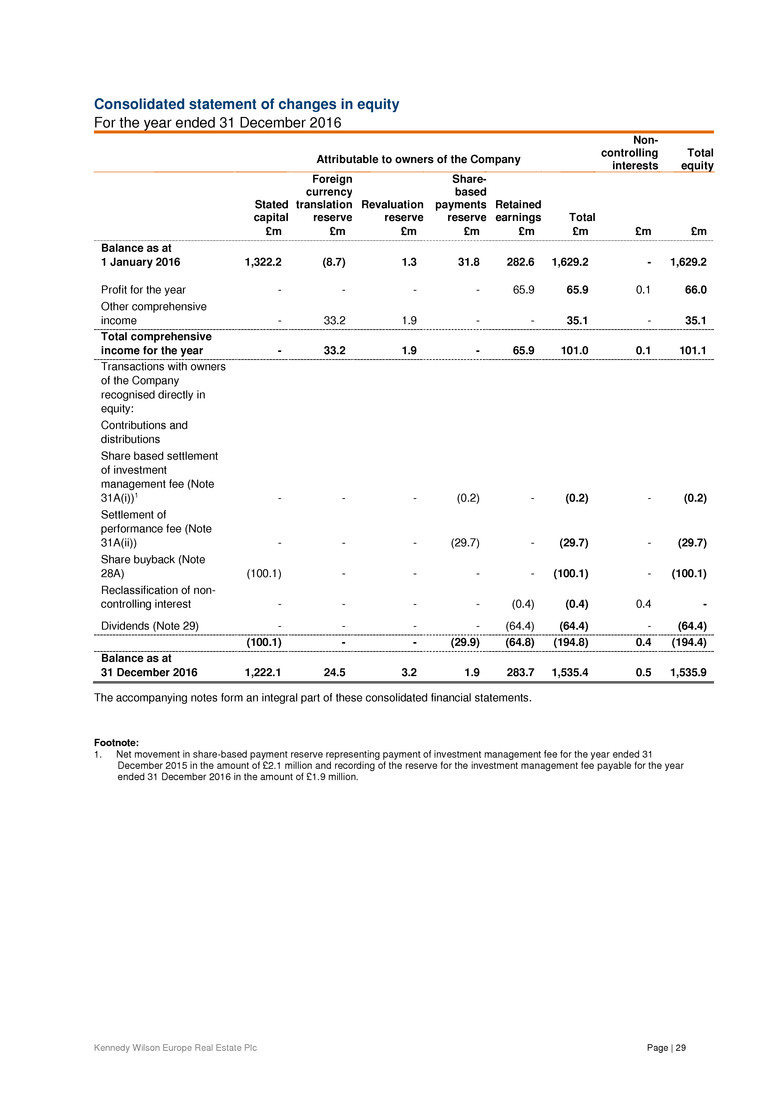
Kennedy Wilson Europe Real Estate Plc Page | 29 Consolidated statement of changes in equity For the year ended 31 December 2016 Attributable to owners of the Company Non- controlling interests Total equity Stated capital Foreign currency translation reserve Revaluation reserve Share- based payments reserve Retained earnings Total £m £m £m £m £m £m £m £m Balance as at 1 January 2016 1,322.2 (8.7) 1.3 31.8 282.6 1,629.2 - 1,629.2 Profit for the year - - - - 65.9 65.9 0.1 66.0 Other comprehensive income - 33.2 1.9 - - 35.1 - 35.1 Total comprehensive income for the year - 33.2 1.9 - 65.9 101.0 0.1 101.1 Transactions with owners of the Company recognised directly in equity: Contributions and distributions Share based settlement of investment management fee (Note 31A(i))1 - - - (0.2) - (0.2) - (0.2) Settlement of performance fee (Note 31A(ii)) - - - (29.7) - (29.7) - (29.7) Share buyback (Note 28A) (100.1) - - - - (100.1) - (100.1) Reclassification of non- controlling interest - - - - (0.4) (0.4) 0.4 - Dividends (Note 29) - - - - (64.4) (64.4) - (64.4) (100.1) - - (29.9) (64.8) (194.8) 0.4 (194.4) Balance as at 31 December 2016 1,222.1 24.5 3.2 1.9 283.7 1,535.4 0.5 1,535.9 The accompanying notes form an integral part of these consolidated financial statements. Footnote: 1. Net movement in share-based payment reserve representing payment of investment management fee for the year ended 31 December 2015 in the amount of £2.1 million and recording of the reserve for the investment management fee payable for the year ended 31 December 2016 in the amount of £1.9 million.
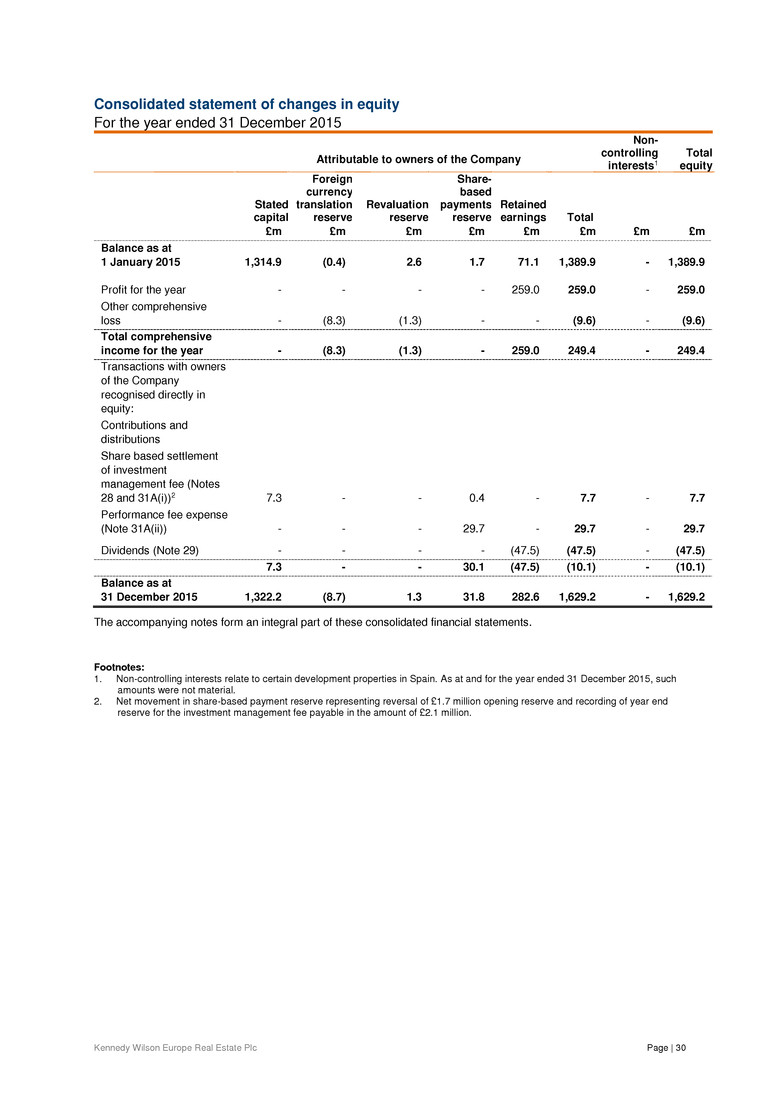
Kennedy Wilson Europe Real Estate Plc Page | 30 Consolidated statement of changes in equity For the year ended 31 December 2015 Attributable to owners of the Company Non- controlling interests1 Total equity Stated capital Foreign currency translation reserve Revaluation reserve Share- based payments reserve Retained earnings Total £m £m £m £m £m £m £m £m Balance as at 1 January 2015 1,314.9 (0.4) 2.6 1.7 71.1 1,389.9 - 1,389.9 Profit for the year - - - - 259.0 259.0 - 259.0 Other comprehensive loss - (8.3) (1.3) - - (9.6) - (9.6) Total comprehensive income for the year - (8.3) (1.3) - 259.0 249.4 - 249.4 Transactions with owners of the Company recognised directly in equity: Contributions and distributions Share based settlement of investment management fee (Notes 28 and 31A(i))2 7.3 - - 0.4 - 7.7 - 7.7 Performance fee expense (Note 31A(ii)) - - - 29.7 - 29.7 - 29.7 Dividends (Note 29) - - - - (47.5) (47.5) - (47.5) 7.3 - - 30.1 (47.5) (10.1) - (10.1) Balance as at 31 December 2015 1,322.2 (8.7) 1.3 31.8 282.6 1,629.2 - 1,629.2 The accompanying notes form an integral part of these consolidated financial statements. Footnotes: 1. Non-controlling interests relate to certain development properties in Spain. As at and for the year ended 31 December 2015, such amounts were not material. 2. Net movement in share-based payment reserve representing reversal of £1.7 million opening reserve and recording of year end reserve for the investment management fee payable in the amount of £2.1 million.
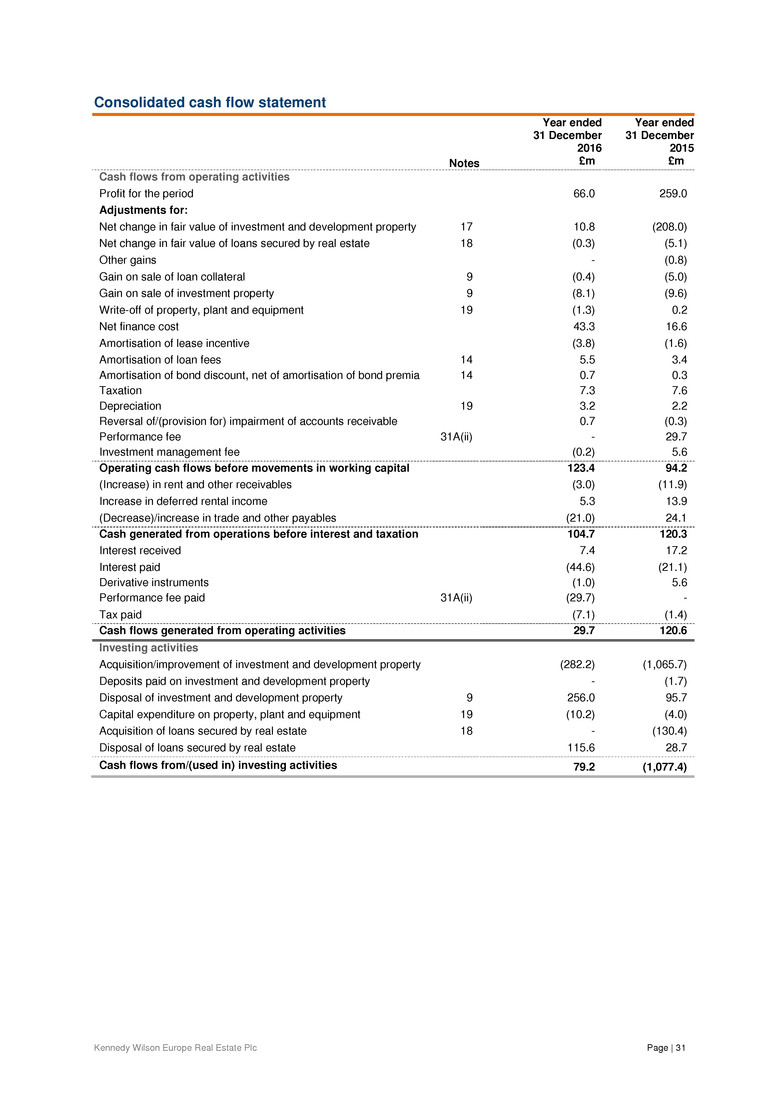
Kennedy Wilson Europe Real Estate Plc Page | 31 Consolidated cash flow statement Year ended 31 December 2016 Year ended 31 December 2015 Notes £m £m Cash flows from operating activities Profit for the period 66.0 259.0 Adjustments for: Net change in fair value of investment and development property 17 10.8 (208.0) Net change in fair value of loans secured by real estate 18 (0.3) (5.1) Other gains - (0.8) Gain on sale of loan collateral 9 (0.4) (5.0) Gain on sale of investment property 9 (8.1) (9.6) Write-off of property, plant and equipment 19 (1.3) 0.2 Net finance cost 43.3 16.6 Amortisation of lease incentive (3.8) (1.6) Amortisation of loan fees 14 5.5 3.4 Amortisation of bond discount, net of amortisation of bond premia 14 0.7 0.3 Taxation 7.3 7.6 Depreciation 19 3.2 2.2 Reversal of/(provision for) impairment of accounts receivable 0.7 (0.3) Performance fee 31A(ii) - 29.7 Investment management fee (0.2) 5.6 Operating cash flows before movements in working capital 123.4 94.2 (Increase) in rent and other receivables (3.0) (11.9) Increase in deferred rental income 5.3 13.9 (Decrease)/increase in trade and other payables (21.0) 24.1 Cash generated from operations before interest and taxation 104.7 120.3 Interest received 7.4 17.2 Interest paid (44.6) (21.1) Derivative instruments (1.0) 5.6 Performance fee paid 31A(ii) (29.7) - Tax paid (7.1) (1.4) Cash flows generated from operating activities 29.7 120.6 Investing activities Acquisition/improvement of investment and development property (282.2) (1,065.7) Deposits paid on investment and development property - (1.7) Disposal of investment and development property 9 256.0 95.7 Capital expenditure on property, plant and equipment 19 (10.2) (4.0) Acquisition of loans secured by real estate 18 - (130.4) Disposal of loans secured by real estate 115.6 28.7 Cash flows from/(used in) investing activities 79.2 (1,077.4)
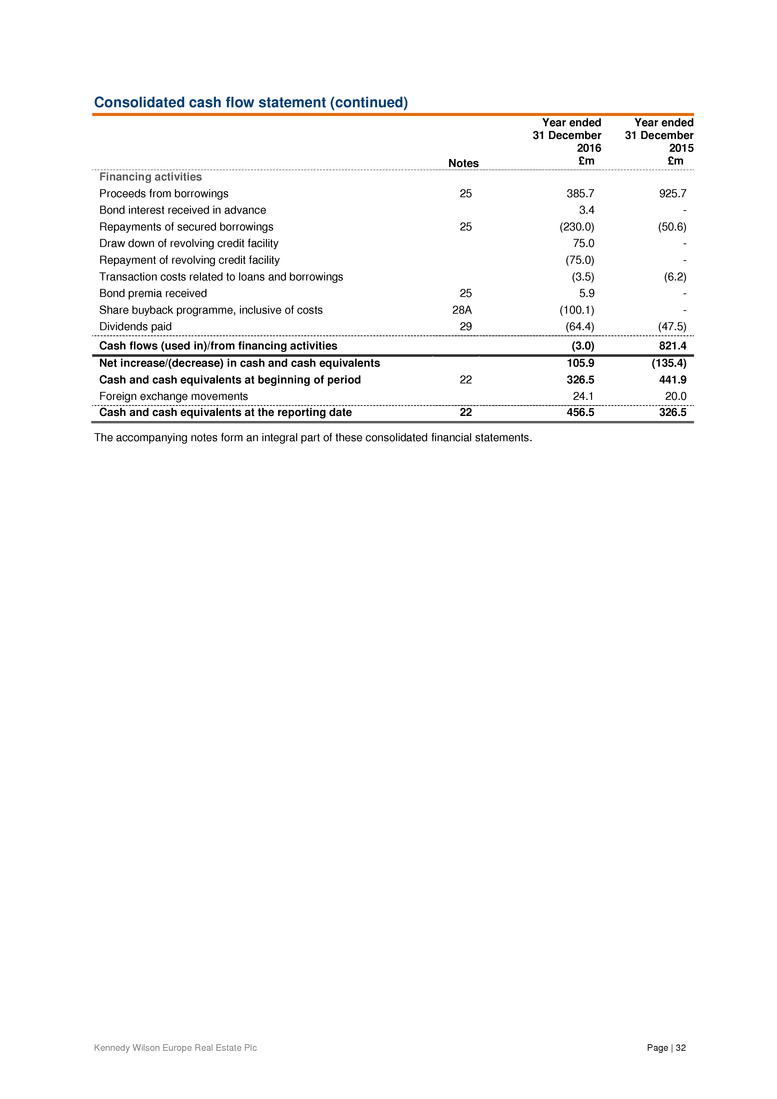
Kennedy Wilson Europe Real Estate Plc Page | 32 Consolidated cash flow statement (continued) Year ended 31 December 2016 Year ended 31 December 2015 Notes £m £m Financing activities Proceeds from borrowings 25 385.7 925.7 Bond interest received in advance 3.4 - Repayments of secured borrowings 25 (230.0) (50.6) Draw down of revolving credit facility 75.0 - Repayment of revolving credit facility (75.0) - Transaction costs related to loans and borrowings (3.5) (6.2) Bond premia received 25 5.9 - Share buyback programme, inclusive of costs 28A (100.1) - Dividends paid 29 (64.4) (47.5) Cash flows (used in)/from financing activities (3.0) 821.4 Net increase/(decrease) in cash and cash equivalents 105.9 (135.4) Cash and cash equivalents at beginning of period 22 326.5 441.9 Foreign exchange movements 24.1 20.0 Cash and cash equivalents at the reporting date 22 456.5 326.5 The accompanying notes form an integral part of these consolidated financial statements.
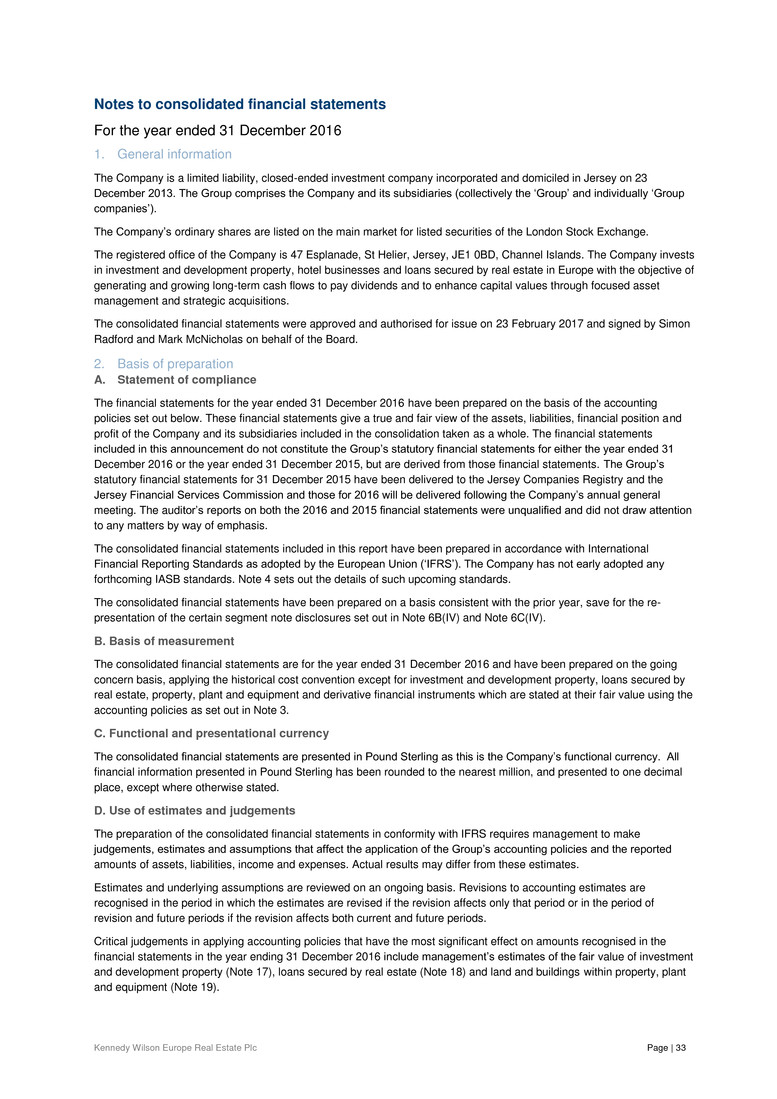
Kennedy Wilson Europe Real Estate Plc Page | 33 Notes to consolidated financial statements For the year ended 31 December 2016 1. General information The Company is a limited liability, closed-ended investment company incorporated and domiciled in Jersey on 23 December 2013. The Group comprises the Company and its subsidiaries (collectively the ‘Group’ and individually ‘Group companies’). The Company’s ordinary shares are listed on the main market for listed securities of the London Stock Exchange. The registered office of the Company is 47 Esplanade, St Helier, Jersey, JE1 0BD, Channel Islands. The Company invests in investment and development property, hotel businesses and loans secured by real estate in Europe with the objective of generating and growing long-term cash flows to pay dividends and to enhance capital values through focused asset management and strategic acquisitions. The consolidated financial statements were approved and authorised for issue on 23 February 2017 and signed by Simon Radford and Mark McNicholas on behalf of the Board. 2. Basis of preparation A. Statement of compliance The financial statements for the year ended 31 December 2016 have been prepared on the basis of the accounting policies set out below. These financial statements give a true and fair view of the assets, liabilities, financial position and profit of the Company and its subsidiaries included in the consolidation taken as a whole. The financial statements included in this announcement do not constitute the Group’s statutory financial statements for either the year ended 31 December 2016 or the year ended 31 December 2015, but are derived from those financial statements. The Group’s statutory financial statements for 31 December 2015 have been delivered to the Jersey Companies Registry and the Jersey Financial Services Commission and those for 2016 will be delivered following the Company’s annual general meeting. The auditor’s reports on both the 2016 and 2015 financial statements were unqualified and did not draw attention to any matters by way of emphasis. The consolidated financial statements included in this report have been prepared in accordance with International Financial Reporting Standards as adopted by the European Union (‘IFRS’). The Company has not early adopted any forthcoming IASB standards. Note 4 sets out the details of such upcoming standards. The consolidated financial statements have been prepared on a basis consistent with the prior year, save for the re- presentation of the certain segment note disclosures set out in Note 6B(IV) and Note 6C(IV). B. Basis of measurement The consolidated financial statements are for the year ended 31 December 2016 and have been prepared on the going concern basis, applying the historical cost convention except for investment and development property, loans secured by real estate, property, plant and equipment and derivative financial instruments which are stated at their fair value using the accounting policies as set out in Note 3. C. Functional and presentational currency The consolidated financial statements are presented in Pound Sterling as this is the Company’s functional currency. All financial information presented in Pound Sterling has been rounded to the nearest million, and presented to one decimal place, except where otherwise stated. D. Use of estimates and judgements The preparation of the consolidated financial statements in conformity with IFRS requires management to make judgements, estimates and assumptions that affect the application of the Group’s accounting policies and the reported amounts of assets, liabilities, income and expenses. Actual results may differ from these estimates. Estimates and underlying assumptions are reviewed on an ongoing basis. Revisions to accounting estimates are recognised in the period in which the estimates are revised if the revision affects only that period or in the period of revision and future periods if the revision affects both current and future periods. Critical judgements in applying accounting policies that have the most significant effect on amounts recognised in the financial statements in the year ending 31 December 2016 include management’s estimates of the fair value of investment and development property (Note 17), loans secured by real estate (Note 18) and land and buildings within property, plant and equipment (Note 19).
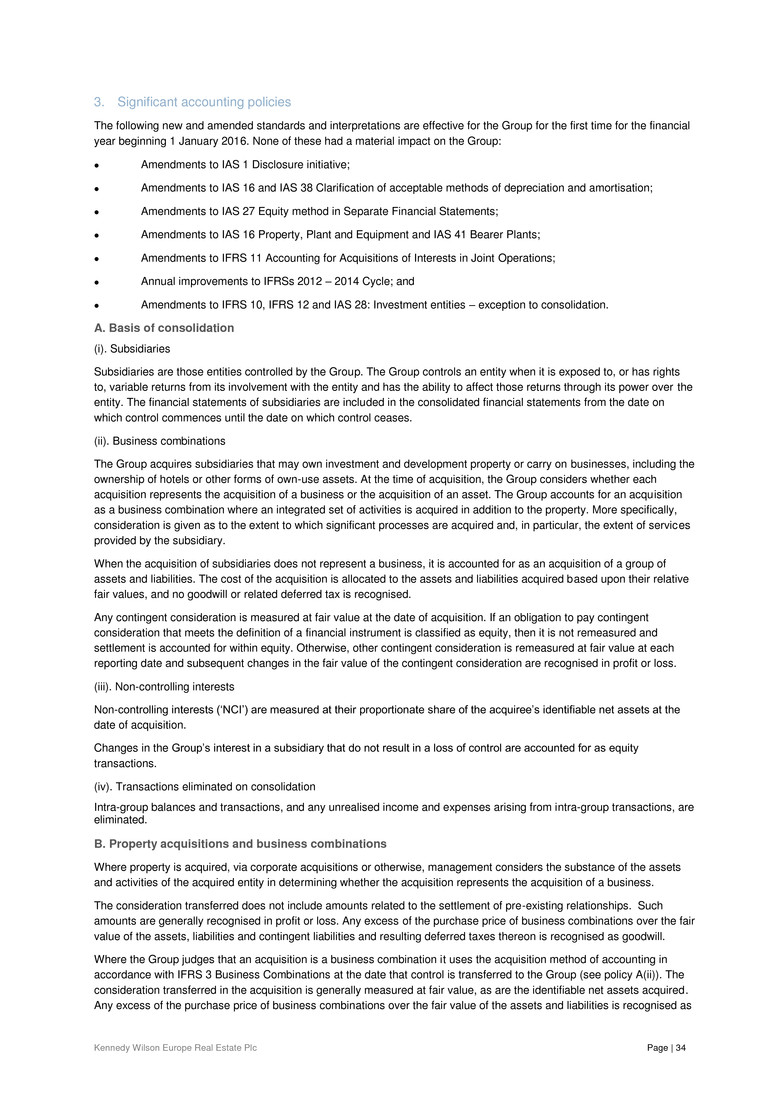
Kennedy Wilson Europe Real Estate Plc Page | 34 3. Significant accounting policies The following new and amended standards and interpretations are effective for the Group for the first time for the financial year beginning 1 January 2016. None of these had a material impact on the Group: Amendments to IAS 1 Disclosure initiative; Amendments to IAS 16 and IAS 38 Clarification of acceptable methods of depreciation and amortisation; Amendments to IAS 27 Equity method in Separate Financial Statements; Amendments to IAS 16 Property, Plant and Equipment and IAS 41 Bearer Plants; Amendments to IFRS 11 Accounting for Acquisitions of Interests in Joint Operations; Annual improvements to IFRSs 2012 – 2014 Cycle; and Amendments to IFRS 10, IFRS 12 and IAS 28: Investment entities – exception to consolidation. A. Basis of consolidation (i). Subsidiaries Subsidiaries are those entities controlled by the Group. The Group controls an entity when it is exposed to, or has rights to, variable returns from its involvement with the entity and has the ability to affect those returns through its power over the entity. The financial statements of subsidiaries are included in the consolidated financial statements from the date on which control commences until the date on which control ceases. (ii). Business combinations The Group acquires subsidiaries that may own investment and development property or carry on businesses, including the ownership of hotels or other forms of own-use assets. At the time of acquisition, the Group considers whether each acquisition represents the acquisition of a business or the acquisition of an asset. The Group accounts for an acquisition as a business combination where an integrated set of activities is acquired in addition to the property. More specifically, consideration is given as to the extent to which significant processes are acquired and, in particular, the extent of services provided by the subsidiary. When the acquisition of subsidiaries does not represent a business, it is accounted for as an acquisition of a group of assets and liabilities. The cost of the acquisition is allocated to the assets and liabilities acquired based upon their relative fair values, and no goodwill or related deferred tax is recognised. Any contingent consideration is measured at fair value at the date of acquisition. If an obligation to pay contingent consideration that meets the definition of a financial instrument is classified as equity, then it is not remeasured and settlement is accounted for within equity. Otherwise, other contingent consideration is remeasured at fair value at each reporting date and subsequent changes in the fair value of the contingent consideration are recognised in profit or loss. (iii). Non-controlling interests Non-controlling interests (‘NCI’) are measured at their proportionate share of the acquiree’s identifiable net assets at the date of acquisition. Changes in the Group’s interest in a subsidiary that do not result in a loss of control are accounted for as equity transactions. (iv). Transactions eliminated on consolidation Intra-group balances and transactions, and any unrealised income and expenses arising from intra-group transactions, are eliminated. B. Property acquisitions and business combinations Where property is acquired, via corporate acquisitions or otherwise, management considers the substance of the assets and activities of the acquired entity in determining whether the acquisition represents the acquisition of a business. The consideration transferred does not include amounts related to the settlement of pre-existing relationships. Such amounts are generally recognised in profit or loss. Any excess of the purchase price of business combinations over the fair value of the assets, liabilities and contingent liabilities and resulting deferred taxes thereon is recognised as goodwill. Where the Group judges that an acquisition is a business combination it uses the acquisition method of accounting in accordance with IFRS 3 Business Combinations at the date that control is transferred to the Group (see policy A(ii)). The consideration transferred in the acquisition is generally measured at fair value, as are the identifiable net assets acquired. Any excess of the purchase price of business combinations over the fair value of the assets and liabilities is recognised as
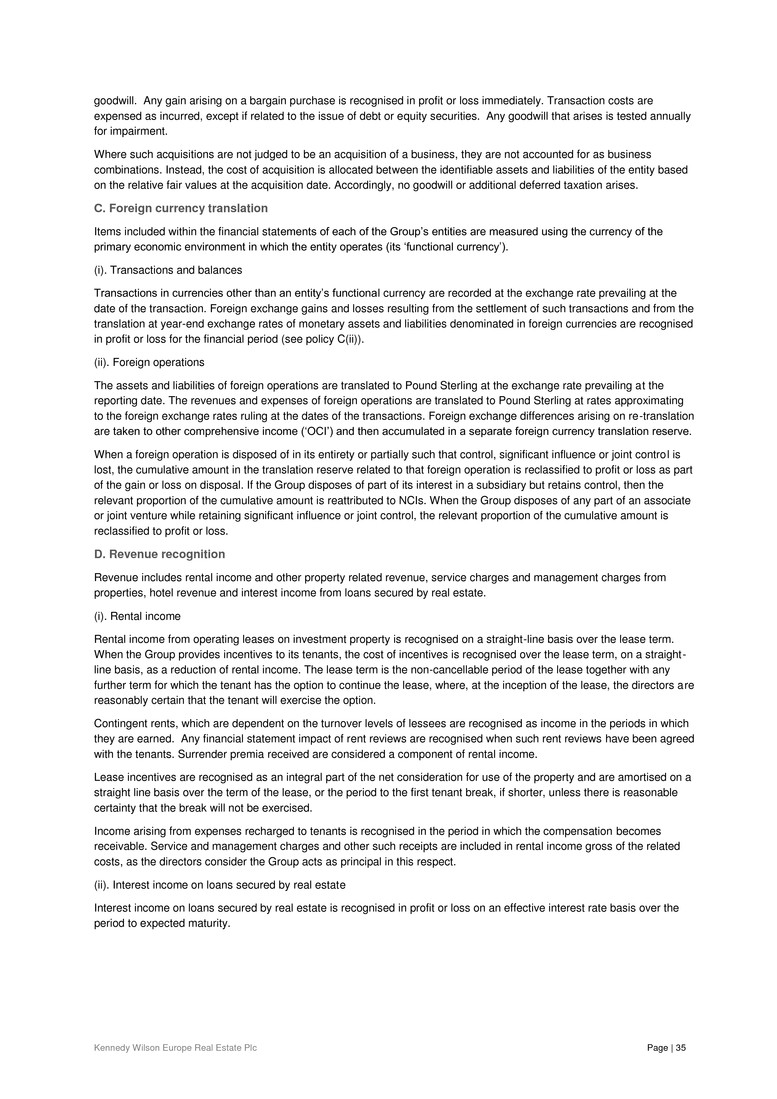
Kennedy Wilson Europe Real Estate Plc Page | 35 goodwill. Any gain arising on a bargain purchase is recognised in profit or loss immediately. Transaction costs are expensed as incurred, except if related to the issue of debt or equity securities. Any goodwill that arises is tested annually for impairment. Where such acquisitions are not judged to be an acquisition of a business, they are not accounted for as business combinations. Instead, the cost of acquisition is allocated between the identifiable assets and liabilities of the entity based on the relative fair values at the acquisition date. Accordingly, no goodwill or additional deferred taxation arises. C. Foreign currency translation Items included within the financial statements of each of the Group’s entities are measured using the currency of the primary economic environment in which the entity operates (its ‘functional currency’). (i). Transactions and balances Transactions in currencies other than an entity’s functional currency are recorded at the exchange rate prevailing at the date of the transaction. Foreign exchange gains and losses resulting from the settlement of such transactions and from the translation at year-end exchange rates of monetary assets and liabilities denominated in foreign currencies are recognised in profit or loss for the financial period (see policy C(ii)). (ii). Foreign operations The assets and liabilities of foreign operations are translated to Pound Sterling at the exchange rate prevailing at the reporting date. The revenues and expenses of foreign operations are translated to Pound Sterling at rates approximating to the foreign exchange rates ruling at the dates of the transactions. Foreign exchange differences arising on re-translation are taken to other comprehensive income (‘OCI’) and then accumulated in a separate foreign currency translation reserve. When a foreign operation is disposed of in its entirety or partially such that control, significant influence or joint control is lost, the cumulative amount in the translation reserve related to that foreign operation is reclassified to profit or loss as part of the gain or loss on disposal. If the Group disposes of part of its interest in a subsidiary but retains control, then the relevant proportion of the cumulative amount is reattributed to NCIs. When the Group disposes of any part of an associate or joint venture while retaining significant influence or joint control, the relevant proportion of the cumulative amount is reclassified to profit or loss. D. Revenue recognition Revenue includes rental income and other property related revenue, service charges and management charges from properties, hotel revenue and interest income from loans secured by real estate. (i). Rental income Rental income from operating leases on investment property is recognised on a straight-line basis over the lease term. When the Group provides incentives to its tenants, the cost of incentives is recognised over the lease term, on a straight- line basis, as a reduction of rental income. The lease term is the non-cancellable period of the lease together with any further term for which the tenant has the option to continue the lease, where, at the inception of the lease, the directors are reasonably certain that the tenant will exercise the option. Contingent rents, which are dependent on the turnover levels of lessees are recognised as income in the periods in which they are earned. Any financial statement impact of rent reviews are recognised when such rent reviews have been agreed with the tenants. Surrender premia received are considered a component of rental income. Lease incentives are recognised as an integral part of the net consideration for use of the property and are amortised on a straight line basis over the term of the lease, or the period to the first tenant break, if shorter, unless there is reasonable certainty that the break will not be exercised. Income arising from expenses recharged to tenants is recognised in the period in which the compensation becomes receivable. Service and management charges and other such receipts are included in rental income gross of the related costs, as the directors consider the Group acts as principal in this respect. (ii). Interest income on loans secured by real estate Interest income on loans secured by real estate is recognised in profit or loss on an effective interest rate basis over the period to expected maturity.
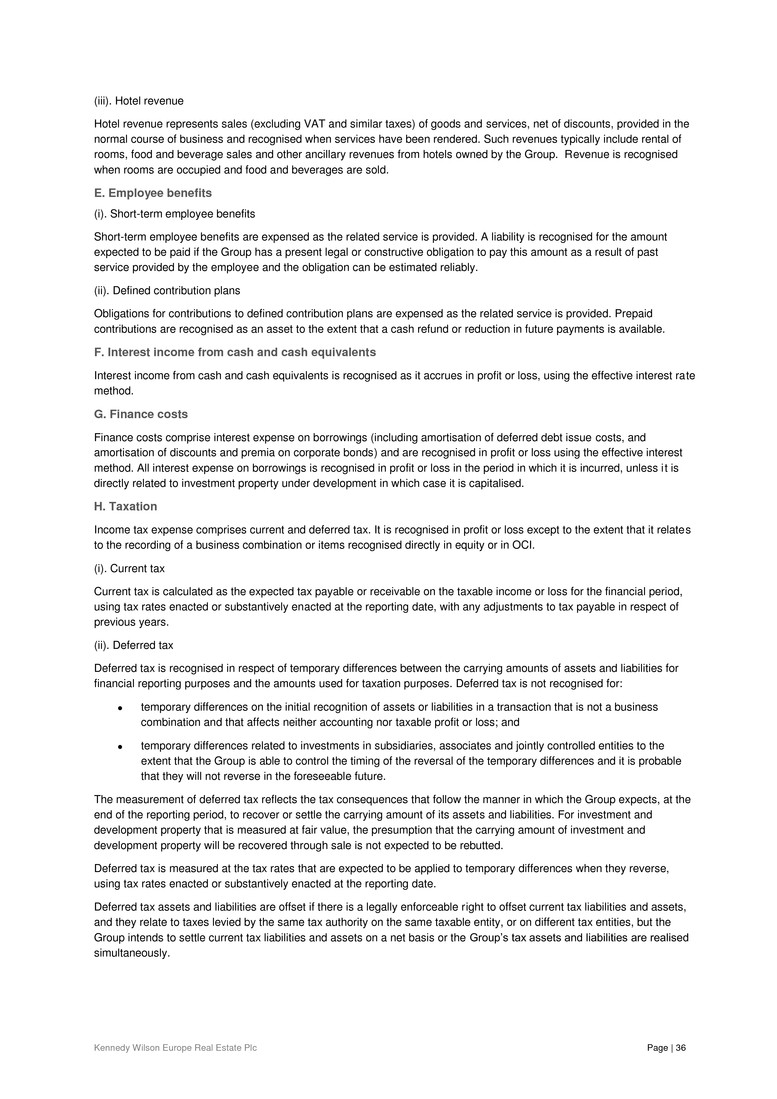
Kennedy Wilson Europe Real Estate Plc Page | 36 (iii). Hotel revenue Hotel revenue represents sales (excluding VAT and similar taxes) of goods and services, net of discounts, provided in the normal course of business and recognised when services have been rendered. Such revenues typically include rental of rooms, food and beverage sales and other ancillary revenues from hotels owned by the Group. Revenue is recognised when rooms are occupied and food and beverages are sold. E. Employee benefits (i). Short-term employee benefits Short-term employee benefits are expensed as the related service is provided. A liability is recognised for the amount expected to be paid if the Group has a present legal or constructive obligation to pay this amount as a result of past service provided by the employee and the obligation can be estimated reliably. (ii). Defined contribution plans Obligations for contributions to defined contribution plans are expensed as the related service is provided. Prepaid contributions are recognised as an asset to the extent that a cash refund or reduction in future payments is available. F. Interest income from cash and cash equivalents Interest income from cash and cash equivalents is recognised as it accrues in profit or loss, using the effective interest rate method. G. Finance costs Finance costs comprise interest expense on borrowings (including amortisation of deferred debt issue costs, and amortisation of discounts and premia on corporate bonds) and are recognised in profit or loss using the effective interest method. All interest expense on borrowings is recognised in profit or loss in the period in which it is incurred, unless i t is directly related to investment property under development in which case it is capitalised. H. Taxation Income tax expense comprises current and deferred tax. It is recognised in profit or loss except to the extent that it relates to the recording of a business combination or items recognised directly in equity or in OCI. (i). Current tax Current tax is calculated as the expected tax payable or receivable on the taxable income or loss for the financial period, using tax rates enacted or substantively enacted at the reporting date, with any adjustments to tax payable in respect of previous years. (ii). Deferred tax Deferred tax is recognised in respect of temporary differences between the carrying amounts of assets and liabilities for financial reporting purposes and the amounts used for taxation purposes. Deferred tax is not recognised for: temporary differences on the initial recognition of assets or liabilities in a transaction that is not a business combination and that affects neither accounting nor taxable profit or loss; and temporary differences related to investments in subsidiaries, associates and jointly controlled entities to the extent that the Group is able to control the timing of the reversal of the temporary differences and it is probable that they will not reverse in the foreseeable future. The measurement of deferred tax reflects the tax consequences that follow the manner in which the Group expects, at the end of the reporting period, to recover or settle the carrying amount of its assets and liabilities. For investment and development property that is measured at fair value, the presumption that the carrying amount of investment and development property will be recovered through sale is not expected to be rebutted. Deferred tax is measured at the tax rates that are expected to be applied to temporary differences when they reverse, using tax rates enacted or substantively enacted at the reporting date. Deferred tax assets and liabilities are offset if there is a legally enforceable right to offset current tax liabilities and assets, and they relate to taxes levied by the same tax authority on the same taxable entity, or on different tax entities, but the Group intends to settle current tax liabilities and assets on a net basis or the Group’s tax assets and liabilities are realised simultaneously.
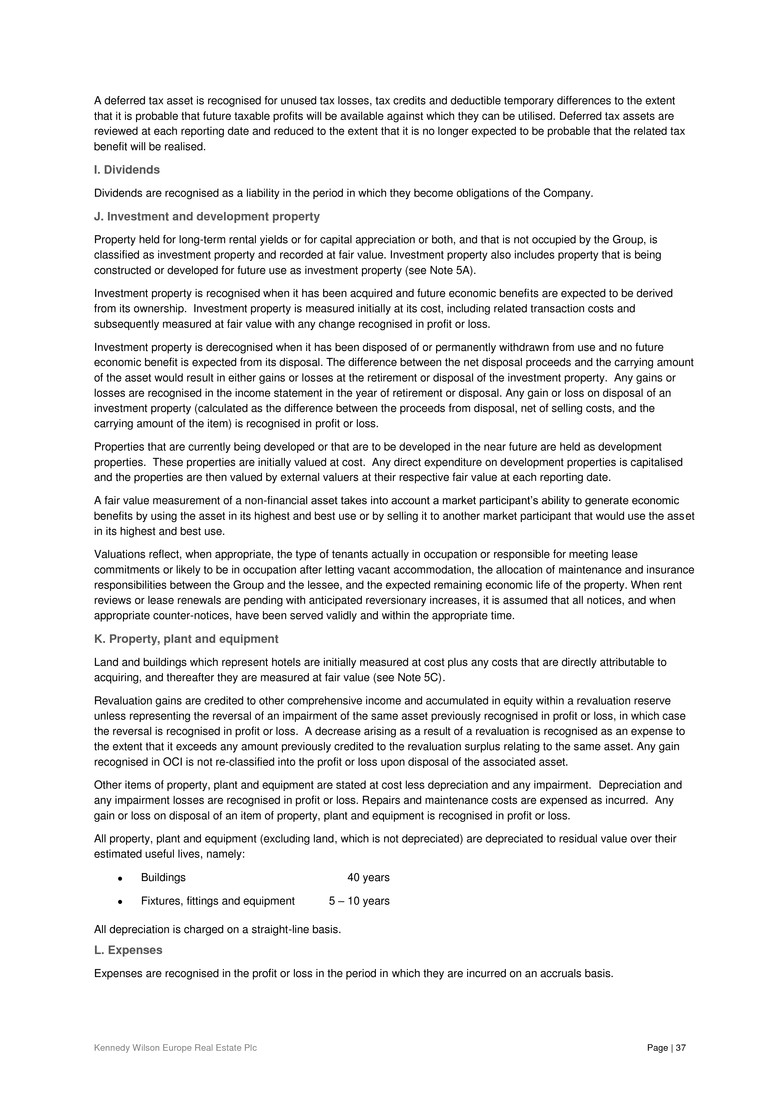
Kennedy Wilson Europe Real Estate Plc Page | 37 A deferred tax asset is recognised for unused tax losses, tax credits and deductible temporary differences to the extent that it is probable that future taxable profits will be available against which they can be utilised. Deferred tax assets are reviewed at each reporting date and reduced to the extent that it is no longer expected to be probable that the related tax benefit will be realised. I. Dividends Dividends are recognised as a liability in the period in which they become obligations of the Company. J. Investment and development property Property held for long-term rental yields or for capital appreciation or both, and that is not occupied by the Group, is classified as investment property and recorded at fair value. Investment property also includes property that is being constructed or developed for future use as investment property (see Note 5A). Investment property is recognised when it has been acquired and future economic benefits are expected to be derived from its ownership. Investment property is measured initially at its cost, including related transaction costs and subsequently measured at fair value with any change recognised in profit or loss. Investment property is derecognised when it has been disposed of or permanently withdrawn from use and no future economic benefit is expected from its disposal. The difference between the net disposal proceeds and the carrying amount of the asset would result in either gains or losses at the retirement or disposal of the investment property. Any gains or losses are recognised in the income statement in the year of retirement or disposal. Any gain or loss on disposal of an investment property (calculated as the difference between the proceeds from disposal, net of selling costs, and the carrying amount of the item) is recognised in profit or loss. Properties that are currently being developed or that are to be developed in the near future are held as development properties. These properties are initially valued at cost. Any direct expenditure on development properties is capitalised and the properties are then valued by external valuers at their respective fair value at each reporting date. A fair value measurement of a non-financial asset takes into account a market participant’s ability to generate economic benefits by using the asset in its highest and best use or by selling it to another market participant that would use the asset in its highest and best use. Valuations reflect, when appropriate, the type of tenants actually in occupation or responsible for meeting lease commitments or likely to be in occupation after letting vacant accommodation, the allocation of maintenance and insurance responsibilities between the Group and the lessee, and the expected remaining economic life of the property. When rent reviews or lease renewals are pending with anticipated reversionary increases, it is assumed that all notices, and when appropriate counter-notices, have been served validly and within the appropriate time. K. Property, plant and equipment Land and buildings which represent hotels are initially measured at cost plus any costs that are directly attributable to acquiring, and thereafter they are measured at fair value (see Note 5C). Revaluation gains are credited to other comprehensive income and accumulated in equity within a revaluation reserve unless representing the reversal of an impairment of the same asset previously recognised in profit or loss, in which case the reversal is recognised in profit or loss. A decrease arising as a result of a revaluation is recognised as an expense to the extent that it exceeds any amount previously credited to the revaluation surplus relating to the same asset. Any gain recognised in OCI is not re-classified into the profit or loss upon disposal of the associated asset. Other items of property, plant and equipment are stated at cost less depreciation and any impairment. Depreciation and any impairment losses are recognised in profit or loss. Repairs and maintenance costs are expensed as incurred. Any gain or loss on disposal of an item of property, plant and equipment is recognised in profit or loss. All property, plant and equipment (excluding land, which is not depreciated) are depreciated to residual value over their estimated useful lives, namely: Buildings 40 years Fixtures, fittings and equipment 5 – 10 years All depreciation is charged on a straight-line basis. L. Expenses Expenses are recognised in the profit or loss in the period in which they are incurred on an accruals basis.
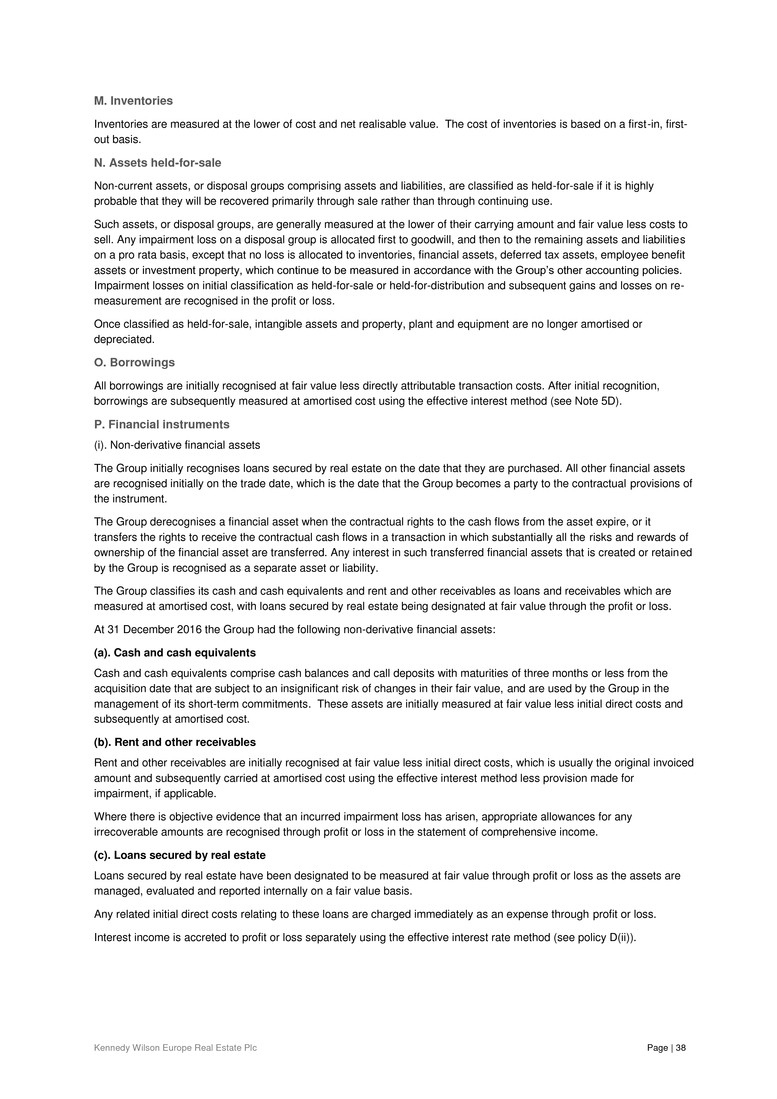
Kennedy Wilson Europe Real Estate Plc Page | 38 M. Inventories Inventories are measured at the lower of cost and net realisable value. The cost of inventories is based on a first-in, first- out basis. N. Assets held-for-sale Non-current assets, or disposal groups comprising assets and liabilities, are classified as held-for-sale if it is highly probable that they will be recovered primarily through sale rather than through continuing use. Such assets, or disposal groups, are generally measured at the lower of their carrying amount and fair value less costs to sell. Any impairment loss on a disposal group is allocated first to goodwill, and then to the remaining assets and liabilities on a pro rata basis, except that no loss is allocated to inventories, financial assets, deferred tax assets, employee benefit assets or investment property, which continue to be measured in accordance with the Group’s other accounting policies. Impairment losses on initial classification as held-for-sale or held-for-distribution and subsequent gains and losses on re- measurement are recognised in the profit or loss. Once classified as held-for-sale, intangible assets and property, plant and equipment are no longer amortised or depreciated. O. Borrowings All borrowings are initially recognised at fair value less directly attributable transaction costs. After initial recognition, borrowings are subsequently measured at amortised cost using the effective interest method (see Note 5D). P. Financial instruments (i). Non-derivative financial assets The Group initially recognises loans secured by real estate on the date that they are purchased. All other financial assets are recognised initially on the trade date, which is the date that the Group becomes a party to the contractual provisions of the instrument. The Group derecognises a financial asset when the contractual rights to the cash flows from the asset expire, or it transfers the rights to receive the contractual cash flows in a transaction in which substantially all the risks and rewards of ownership of the financial asset are transferred. Any interest in such transferred financial assets that is created or retained by the Group is recognised as a separate asset or liability. The Group classifies its cash and cash equivalents and rent and other receivables as loans and receivables which are measured at amortised cost, with loans secured by real estate being designated at fair value through the profit or loss. At 31 December 2016 the Group had the following non-derivative financial assets: (a). Cash and cash equivalents Cash and cash equivalents comprise cash balances and call deposits with maturities of three months or less from the acquisition date that are subject to an insignificant risk of changes in their fair value, and are used by the Group in the management of its short-term commitments. These assets are initially measured at fair value less initial direct costs and subsequently at amortised cost. (b). Rent and other receivables Rent and other receivables are initially recognised at fair value less initial direct costs, which is usually the original invoiced amount and subsequently carried at amortised cost using the effective interest method less provision made for impairment, if applicable. Where there is objective evidence that an incurred impairment loss has arisen, appropriate allowances for any irrecoverable amounts are recognised through profit or loss in the statement of comprehensive income. (c). Loans secured by real estate Loans secured by real estate have been designated to be measured at fair value through profit or loss as the assets are managed, evaluated and reported internally on a fair value basis. Any related initial direct costs relating to these loans are charged immediately as an expense through profit or loss. Interest income is accreted to profit or loss separately using the effective interest rate method (see policy D(ii)).

Kennedy Wilson Europe Real Estate Plc Page | 39 (ii). Non-derivative financial liabilities All non-derivative financial liabilities are recognised initially at the date that the Group becomes a party to the contractual provisions of the instrument and are measured initially at fair value less initial direct costs and subsequently measured at amortised cost. The Group derecognises a financial liability when its contractual obligations are discharged, cancelled or expire. (iii). Derivative financial instruments and net investment hedge accounting The Group uses a variety of derivative instruments to mitigate certain interest rate and foreign currency financial risks including interest rate caps, cross-currency swaps and foreign currency forward contracts and foreign currency zero premium options. The Group does not enter into derivative contracts for speculative purposes. Derivative instruments are used for hedging purposes to alter the risk profile of an existing underlying exposure of the Group in line with its risk management policies. All derivatives are recognised at fair value. The treatment of the change in fair value depends on whether the derivative is designated as a hedging instrument, the nature of the item being hedged and the effectiveness of the hedge (see Note 5E). Derivative financial instruments are initially recognised at fair value on the date on which a derivative contract is entered into and are subsequently re-measured at fair value. Derivatives are carried as assets when the fair value is positive and as liabilities when the fair value is negative. (a). Net investment hedges The Group designates foreign currency forward contracts, zero-cost foreign currency options, interest rate cross-currency swaps and certain foreign currency denominated corporate debt as hedges of its net investment in foreign operations. At inception, the Group documents the relationship between the hedging instrument and the hedged items, its risk management objectives and the strategy for undertaking the transaction. The Group also documents its assessment of whether the hedging instrument is highly effective in offsetting changes in fair value or cash flows of hedged items, both at inception and future periods. Any gain or loss on the hedging instrument relating to the effective portion of the hedge is recognised in OCI. The gain or loss relating to the ineffective portion is recognised immediately in profit or loss within finance income or costs as appropriate. If the hedging instrument no longer meets the criteria for hedge accounting, expires or is sold, terminated or exercised, or if the foreign operation is sold then hedge accounting is discontinued prospectively and gains or losses accumulated in OCI are reclassified to profit or loss. (b). Derivatives not designated as hedges Interest rate caps are used to economically hedge the Group’s exposure to certain borrowing related interest rate risks and are not formally designated as hedges for hedge accounting purposes. Changes in the fair value of these derivatives are recognised in profit or loss within finance income or finance cost as appropriate. The fair values of derivative instruments used for hedging purposes are disclosed in Note 26. The full fair value of a derivative is classified as a non-current asset or liability when its remaining maturity is more than one year; it is classified as a current asset or liability when its remaining maturity is less than one year. (c). Master netting or similar agreements The derivatives do not meet the criteria for offsetting in the balance sheet. This is because the Group does not have any currently legally enforceable right to offset recognised amounts, because the right to offset is enforceable only on the occurrence of future events such as credit events. Q. Share-based payments The Group enters into equity-settled share-based payment arrangements in respect of services provided to it by KW Investment Management Ltd (the ‘Investment Manager’). The Company recognised an obligation where the method of settlement of the award is dependent on the achievement of a market-based performance condition which is outside of the control of the Company, and the award may be settled either through market purchase of shares or the issue of shares. (i). Investment management fee In relation to the Investment Manager’s management fee at grant date, the monetary value of the award it will receive is dependent on a non-market performance condition, being the EPRA NAV at each quarter end. The award is accounted for as an equity settled share based payment arrangement. The cost of the services received in respect of the shares is recognised in the profit or loss over the vesting period, with a corresponding credit to equity.
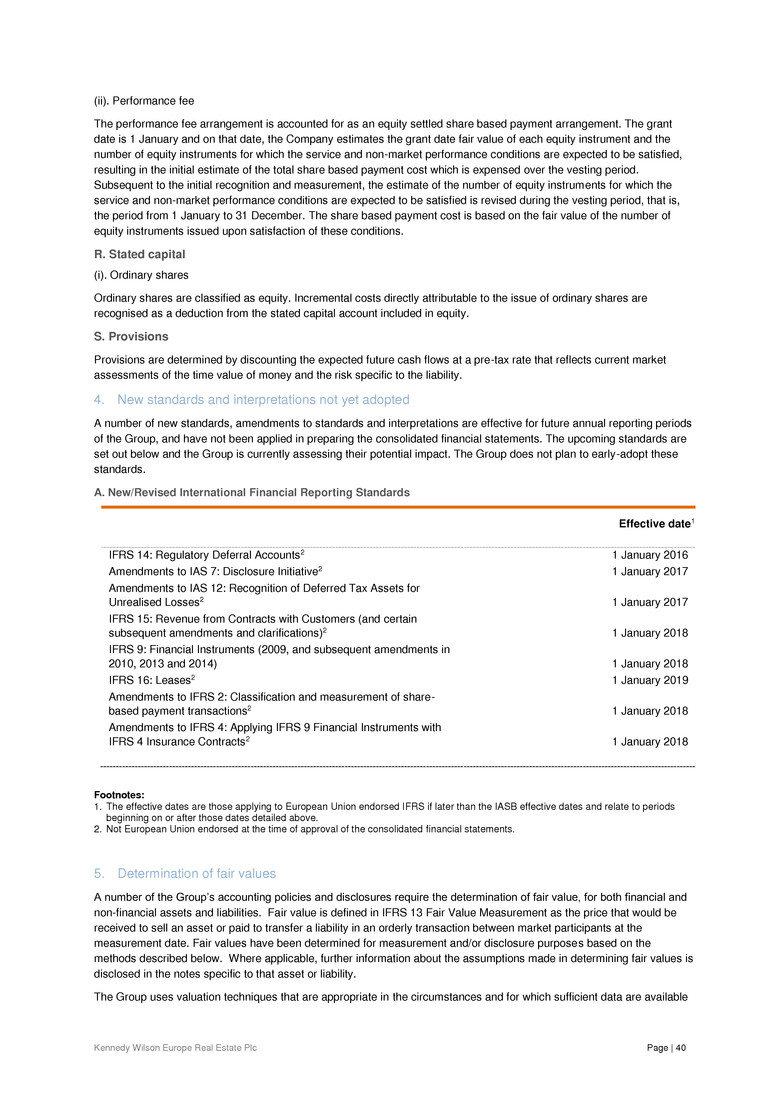
Kennedy Wilson Europe Real Estate Plc Page | 40 (ii). Performance fee The performance fee arrangement is accounted for as an equity settled share based payment arrangement. The grant date is 1 January and on that date, the Company estimates the grant date fair value of each equity instrument and the number of equity instruments for which the service and non-market performance conditions are expected to be satisfied, resulting in the initial estimate of the total share based payment cost which is expensed over the vesting period. Subsequent to the initial recognition and measurement, the estimate of the number of equity instruments for which the service and non-market performance conditions are expected to be satisfied is revised during the vesting period, that is, the period from 1 January to 31 December. The share based payment cost is based on the fair value of the number of equity instruments issued upon satisfaction of these conditions. R. Stated capital (i). Ordinary shares Ordinary shares are classified as equity. Incremental costs directly attributable to the issue of ordinary shares are recognised as a deduction from the stated capital account included in equity. S. Provisions Provisions are determined by discounting the expected future cash flows at a pre-tax rate that reflects current market assessments of the time value of money and the risk specific to the liability. 4. New standards and interpretations not yet adopted A number of new standards, amendments to standards and interpretations are effective for future annual reporting periods of the Group, and have not been applied in preparing the consolidated financial statements. The upcoming standards are set out below and the Group is currently assessing their potential impact. The Group does not plan to early-adopt these standards. A. New/Revised International Financial Reporting Standards Effective date1 IFRS 14: Regulatory Deferral Accounts2 1 January 2016 Amendments to IAS 7: Disclosure Initiative2 1 January 2017 Amendments to IAS 12: Recognition of Deferred Tax Assets for Unrealised Losses2 1 January 2017 IFRS 15: Revenue from Contracts with Customers (and certain subsequent amendments and clarifications)2 1 January 2018 IFRS 9: Financial Instruments (2009, and subsequent amendments in 2010, 2013 and 2014) 1 January 2018 IFRS 16: Leases2 1 January 2019 Amendments to IFRS 2: Classification and measurement of share- based payment transactions2 1 January 2018 Amendments to IFRS 4: Applying IFRS 9 Financial Instruments with IFRS 4 Insurance Contracts2 1 January 2018 Footnotes: 1. The effective dates are those applying to European Union endorsed IFRS if later than the IASB effective dates and relate to periods beginning on or after those dates detailed above. 2. Not European Union endorsed at the time of approval of the consolidated financial statements. 5. Determination of fair values A number of the Group’s accounting policies and disclosures require the determination of fair value, for both financial and non-financial assets and liabilities. Fair value is defined in IFRS 13 Fair Value Measurement as the price that would be received to sell an asset or paid to transfer a liability in an orderly transaction between market participants at the measurement date. Fair values have been determined for measurement and/or disclosure purposes based on the methods described below. Where applicable, further information about the assumptions made in determining fair values is disclosed in the notes specific to that asset or liability. The Group uses valuation techniques that are appropriate in the circumstances and for which sufficient data are available
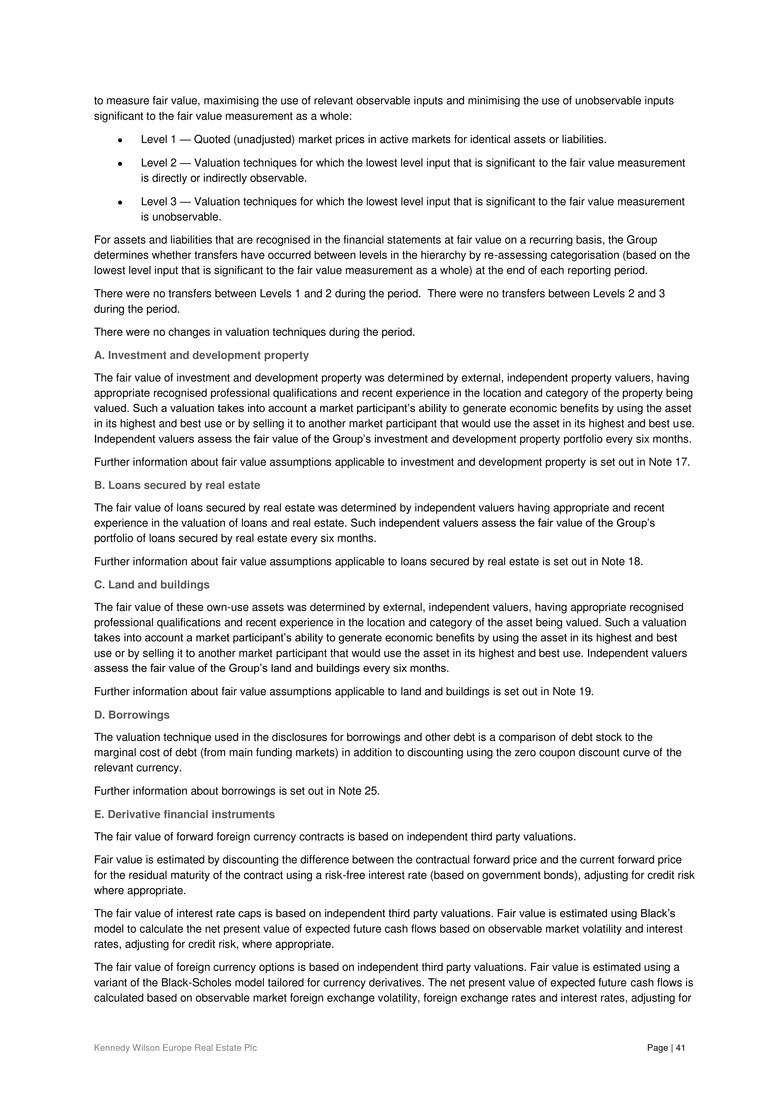
Kennedy Wilson Europe Real Estate Plc Page | 41 to measure fair value, maximising the use of relevant observable inputs and minimising the use of unobservable inputs significant to the fair value measurement as a whole: Level 1 — Quoted (unadjusted) market prices in active markets for identical assets or liabilities. Level 2 — Valuation techniques for which the lowest level input that is significant to the fair value measurement is directly or indirectly observable. Level 3 — Valuation techniques for which the lowest level input that is significant to the fair value measurement is unobservable. For assets and liabilities that are recognised in the financial statements at fair value on a recurring basis, the Group determines whether transfers have occurred between levels in the hierarchy by re-assessing categorisation (based on the lowest level input that is significant to the fair value measurement as a whole) at the end of each reporting period. There were no transfers between Levels 1 and 2 during the period. There were no transfers between Levels 2 and 3 during the period. There were no changes in valuation techniques during the period. A. Investment and development property The fair value of investment and development property was determined by external, independent property valuers, having appropriate recognised professional qualifications and recent experience in the location and category of the property being valued. Such a valuation takes into account a market participant’s ability to generate economic benefits by using the asset in its highest and best use or by selling it to another market participant that would use the asset in its highest and best use. Independent valuers assess the fair value of the Group’s investment and development property portfolio every six months. Further information about fair value assumptions applicable to investment and development property is set out in Note 17. B. Loans secured by real estate The fair value of loans secured by real estate was determined by independent valuers having appropriate and recent experience in the valuation of loans and real estate. Such independent valuers assess the fair value of the Group’s portfolio of loans secured by real estate every six months. Further information about fair value assumptions applicable to loans secured by real estate is set out in Note 18. C. Land and buildings The fair value of these own-use assets was determined by external, independent valuers, having appropriate recognised professional qualifications and recent experience in the location and category of the asset being valued. Such a valuation takes into account a market participant’s ability to generate economic benefits by using the asset in its highest and best use or by selling it to another market participant that would use the asset in its highest and best use. Independent valuers assess the fair value of the Group’s land and buildings every six months. Further information about fair value assumptions applicable to land and buildings is set out in Note 19. D. Borrowings The valuation technique used in the disclosures for borrowings and other debt is a comparison of debt stock to the marginal cost of debt (from main funding markets) in addition to discounting using the zero coupon discount curve of the relevant currency. Further information about borrowings is set out in Note 25. E. Derivative financial instruments The fair value of forward foreign currency contracts is based on independent third party valuations. Fair value is estimated by discounting the difference between the contractual forward price and the current forward price for the residual maturity of the contract using a risk-free interest rate (based on government bonds), adjusting for credit risk where appropriate. The fair value of interest rate caps is based on independent third party valuations. Fair value is estimated using Black’s model to calculate the net present value of expected future cash flows based on observable market volatility and interest rates, adjusting for credit risk, where appropriate. The fair value of foreign currency options is based on independent third party valuations. Fair value is estimated using a variant of the Black-Scholes model tailored for currency derivatives. The net present value of expected future cash flows is calculated based on observable market foreign exchange volatility, foreign exchange rates and interest rates, adjusting for
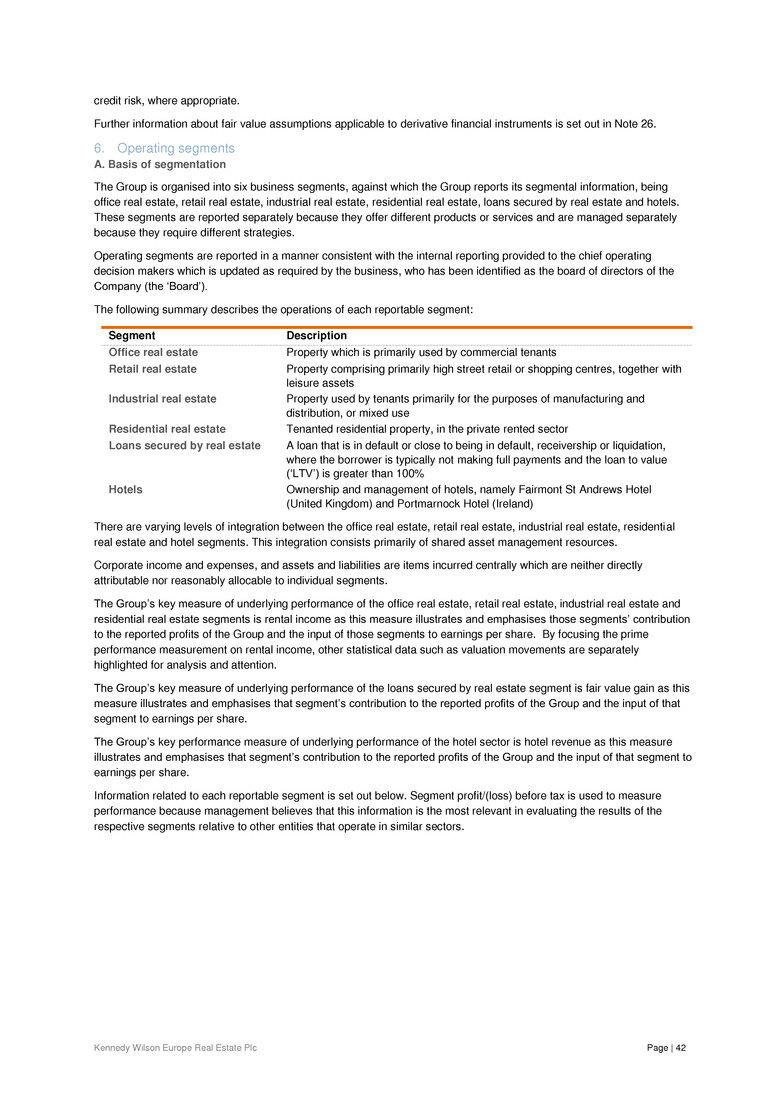
Kennedy Wilson Europe Real Estate Plc Page | 42 credit risk, where appropriate. Further information about fair value assumptions applicable to derivative financial instruments is set out in Note 26. 6. Operating segments A. Basis of segmentation The Group is organised into six business segments, against which the Group reports its segmental information, being office real estate, retail real estate, industrial real estate, residential real estate, loans secured by real estate and hotels. These segments are reported separately because they offer different products or services and are managed separately because they require different strategies. Operating segments are reported in a manner consistent with the internal reporting provided to the chief operating decision makers which is updated as required by the business, who has been identified as the board of directors of the Company (the ‘Board’). The following summary describes the operations of each reportable segment: Segment Description Office real estate Property which is primarily used by commercial tenants Retail real estate Property comprising primarily high street retail or shopping centres, together with leisure assets Industrial real estate Property used by tenants primarily for the purposes of manufacturing and distribution, or mixed use Residential real estate Tenanted residential property, in the private rented sector Loans secured by real estate A loan that is in default or close to being in default, receivership or liquidation, where the borrower is typically not making full payments and the loan to value (‘LTV’) is greater than 100% Hotels Ownership and management of hotels, namely Fairmont St Andrews Hotel (United Kingdom) and Portmarnock Hotel (Ireland) There are varying levels of integration between the office real estate, retail real estate, industrial real estate, residential real estate and hotel segments. This integration consists primarily of shared asset management resources. Corporate income and expenses, and assets and liabilities are items incurred centrally which are neither directly attributable nor reasonably allocable to individual segments. The Group’s key measure of underlying performance of the office real estate, retail real estate, industrial real estate and residential real estate segments is rental income as this measure illustrates and emphasises those segments’ contribution to the reported profits of the Group and the input of those segments to earnings per share. By focusing the prime performance measurement on rental income, other statistical data such as valuation movements are separately highlighted for analysis and attention. The Group’s key measure of underlying performance of the loans secured by real estate segment is fair value gain as this measure illustrates and emphasises that segment’s contribution to the reported profits of the Group and the input of that segment to earnings per share. The Group’s key performance measure of underlying performance of the hotel sector is hotel revenue as this measure illustrates and emphasises that segment’s contribution to the reported profits of the Group and the input of that segment to earnings per share. Information related to each reportable segment is set out below. Segment profit/(loss) before tax is used to measure performance because management believes that this information is the most relevant in evaluating the results of the respective segments relative to other entities that operate in similar sectors.

Kennedy Wilson Europe Real Estate Plc Page | 43 B. Information about reportable segments I. Profit before tax for the year ended 31 December 2016 Office real estate1 Retail real estate1 Industrial real estate1 Residential real estate1 Loans secured by real estate Hotels Segment total Corporate Total £m £m £m £m £m £m £m £m £m Revenue Rental income 103.6 64.9 13.9 9.1 - - 191.5 - 191.5 Hotel revenue - - - - - 19.4 19.4 - 19.4 Interest income from loans secured by real estate - - - - 6.3 - 6.3 - 6.3 103.6 64.9 13.9 9.1 6.3 19.4 217.2 - 217.2 Property related expenses (18.9) (11.5) (1.0) (4.1) (0.3) - (35.8) - (35.8) Hotel cost of sales - - - - - (16.3) (16.3) - (16.3) Administrative costs - - - - - (4.8) (4.8) - (4.8) Net operating income 84.7 53.4 12.9 5.0 6.0 (1.7) 160.3 - 160.3 Net change in the fair value of investment and development property (29.6) 7.4 (5.0) 16.4 - - (10.8) - (10.8) Net change in the fair value of loans secured by real estate - - - - 0.3 - 0.3 - 0.3 Gain/(loss) on sale and other gains 1.8 6.6 (0.3) - 0.4 - 8.5 - 8.5 56.9 67.4 7.6 21.4 6.7 (1.7) 158.3 - 158.3 Overhead costs Administrative expenses (2.5) (1.4) (0.3) (0.6) (0.3) - (5.1) (6.5) (11.6) Investment management fee - - - - - - - (16.3) (16.3) (2.5) (1.4) (0.3) (0.6) (0.3) - (5.1) (22.8) (27.9) Results from operating activities before financing income and costs 54.4 66.0 7.3 20.8 6.4 (1.7) 153.2 (22.8) 130.4 Interest income from cash and cash equivalents - - - - - - - 0.6 0.6 Finance costs (9.7) (11.8) (2.7) (1.8) - - (26.0) (31.7) (57.7) (9.7) (11.8) (2.7) (1.8) - - (26.0) (31.1) (57.1) Segment profit/(loss) before tax 44.7 54.2 4.6 19.0 6.4 (1.7) 127.2 (53.9) 73.3 Footnote: 1. Investment property under development, as identified in Note 17A(ii) is allocated into a segment based on the current expected future use.
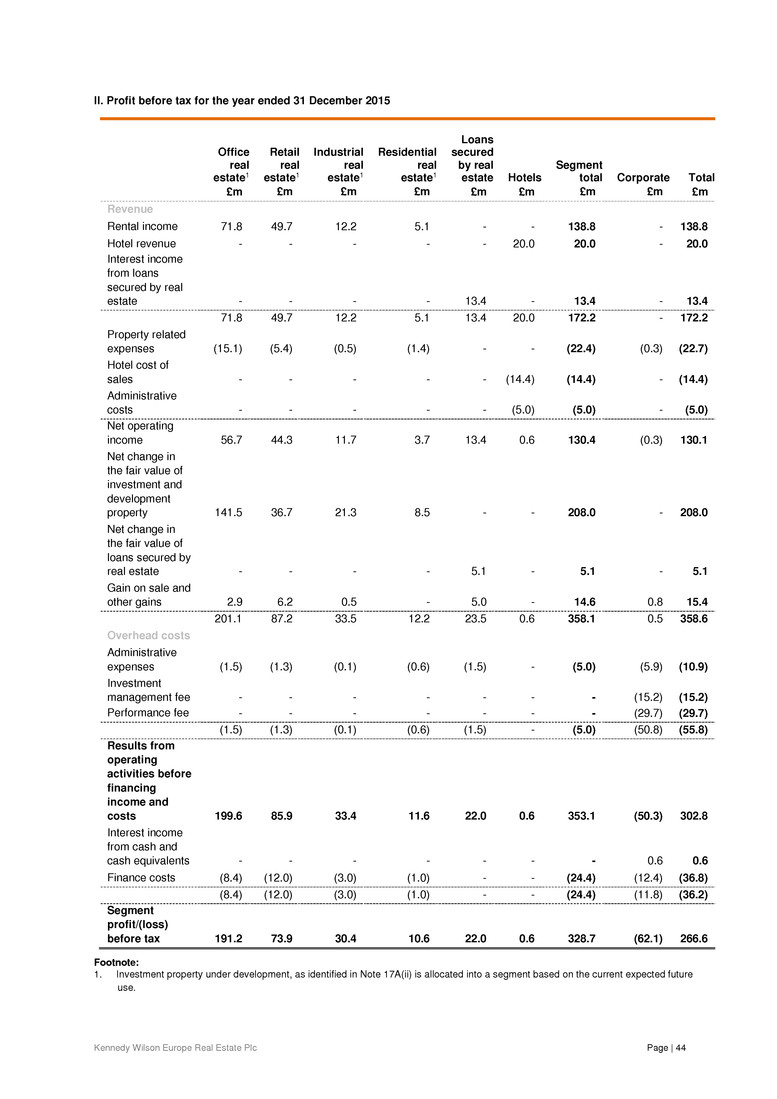
Kennedy Wilson Europe Real Estate Plc Page | 44 II. Profit before tax for the year ended 31 December 2015 Office real estate1 Retail real estate1 Industrial real estate1 Residential real estate1 Loans secured by real estate Hotels Segment total Corporate Total £m £m £m £m £m £m £m £m £m Revenue Rental income 71.8 49.7 12.2 5.1 - - 138.8 - 138.8 Hotel revenue - - - - - 20.0 20.0 - 20.0 Interest income from loans secured by real estate - - - - 13.4 - 13.4 - 13.4 71.8 49.7 12.2 5.1 13.4 20.0 172.2 - 172.2 Property related expenses (15.1) (5.4) (0.5) (1.4) - - (22.4) (0.3) (22.7) Hotel cost of sales - - - - - (14.4) (14.4) - (14.4) Administrative costs - - - - - (5.0) (5.0) - (5.0) Net operating income 56.7 44.3 11.7 3.7 13.4 0.6 130.4 (0.3) 130.1 Net change in the fair value of investment and development property 141.5 36.7 21.3 8.5 - - 208.0 - 208.0 Net change in the fair value of loans secured by real estate - - - - 5.1 - 5.1 - 5.1 Gain on sale and other gains 2.9 6.2 0.5 - 5.0 - 14.6 0.8 15.4 201.1 87.2 33.5 12.2 23.5 0.6 358.1 0.5 358.6 Overhead costs Administrative expenses (1.5) (1.3) (0.1) (0.6) (1.5) - (5.0) (5.9) (10.9) Investment management fee - - - - - - - (15.2) (15.2) Performance fee - - - - - - - (29.7) (29.7) (1.5) (1.3) (0.1) (0.6) (1.5) - (5.0) (50.8) (55.8) Results from operating activities before financing income and costs 199.6 85.9 33.4 11.6 22.0 0.6 353.1 (50.3) 302.8 Interest income from cash and cash equivalents - - - - - - - 0.6 0.6 Finance costs (8.4) (12.0) (3.0) (1.0) - - (24.4) (12.4) (36.8) (8.4) (12.0) (3.0) (1.0) - - (24.4) (11.8) (36.2) Segment profit/(loss) before tax 191.2 73.9 30.4 10.6 22.0 0.6 328.7 (62.1) 266.6 Footnote: 1. Investment property under development, as identified in Note 17A(ii) is allocated into a segment based on the current expected future use.
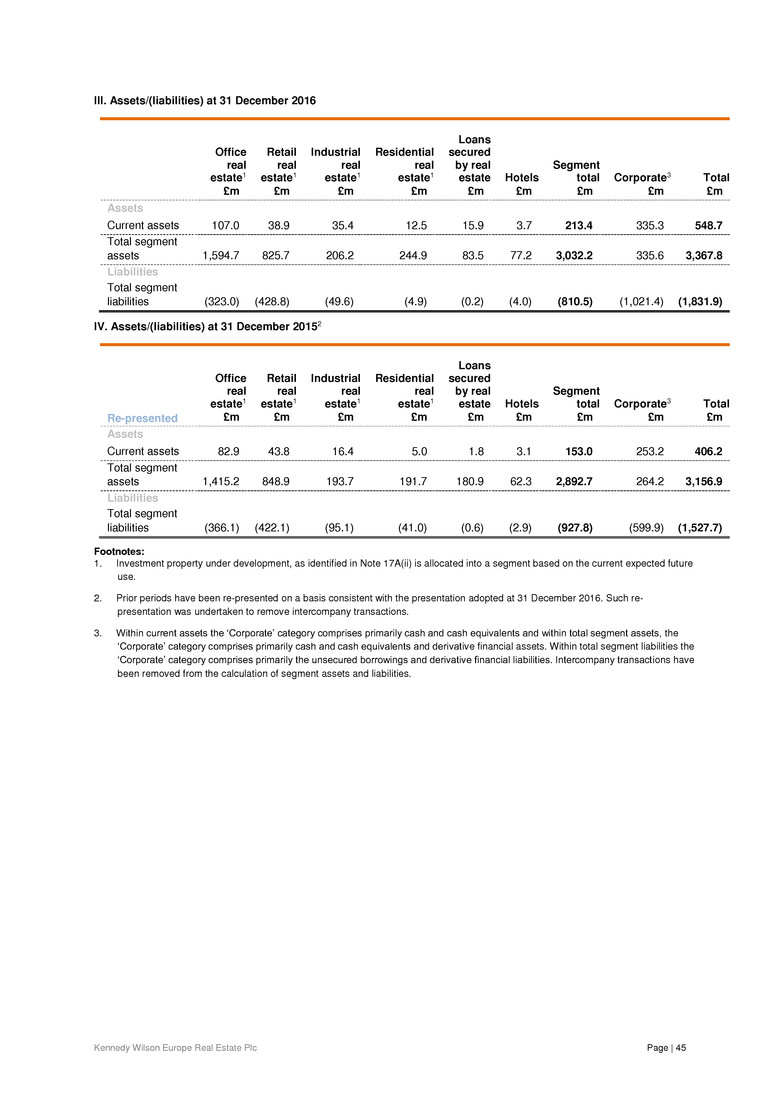
Kennedy Wilson Europe Real Estate Plc Page | 45 III. Assets/(liabilities) at 31 December 2016 Office real estate1 Retail real estate1 Industrial real estate1 Residential real estate1 Loans secured by real estate Hotels Segment total Corporate3 Total £m £m £m £m £m £m £m £m £m Assets Current assets 107.0 38.9 35.4 12.5 15.9 3.7 213.4 335.3 548.7 Total segment assets 1,594.7 825.7 206.2 244.9 83.5 77.2 3,032.2 335.6 3,367.8 Liabilities Total segment liabilities (323.0) (428.8) (49.6) (4.9) (0.2) (4.0) (810.5) (1,021.4) (1,831.9) IV. Assets/(liabilities) at 31 December 20152 Office real estate1 Retail real estate1 Industrial real estate1 Residential real estate1 Loans secured by real estate Hotels Segment total Corporate3 Total Re-presented £m £m £m £m £m £m £m £m £m Assets Current assets 82.9 43.8 16.4 5.0 1.8 3.1 153.0 253.2 406.2 Total segment assets 1,415.2 848.9 193.7 191.7 180.9 62.3 2,892.7 264.2 3,156.9 Liabilities Total segment liabilities (366.1) (422.1) (95.1) (41.0) (0.6) (2.9) (927.8) (599.9) (1,527.7) Footnotes: 1. Investment property under development, as identified in Note 17A(ii) is allocated into a segment based on the current expected future use. 2. Prior periods have been re-presented on a basis consistent with the presentation adopted at 31 December 2016. Such re- presentation was undertaken to remove intercompany transactions. 3. Within current assets the ‘Corporate’ category comprises primarily cash and cash equivalents and within total segment assets, the ‘Corporate’ category comprises primarily cash and cash equivalents and derivative financial assets. Within total segment liabilities the ‘Corporate’ category comprises primarily the unsecured borrowings and derivative financial liabilities. Intercompany transactions have been removed from the calculation of segment assets and liabilities.

Kennedy Wilson Europe Real Estate Plc Page | 46 C. Geographic information The office real estate, retail real estate, industrial real estate and residential real estate segments are primarily in the United Kingdom, the Republic of Ireland, Italy and Spain. Italy and Spain are grouped together and reported as “Rest of Europe”. The geographic information below analyses the Group’s segment revenues, current assets and non-current assets, and total liabilities, by geography. In presenting the following information, segment revenue, current assets and non-current assets, and total liabilities were based on the geographic location of the relevant asset. I. Revenue Year ended 31 December 2016 Year ended 31 December 2015 £m £m United Kingdom Rental income 124.0 107.9 Hotel revenue 13.0 14.2 Interest income on loans secured by real estate 6.0 13.0 Gain on sale of investment property and loan collateral 4.1 10.5 Net change in fair value of investment and development property (77.5) 113.8 Net change in fair value of loans secured by real estate - 3.6 69.6 263.0 Ireland Rental income 42.7 29.0 Hotel revenue 6.4 5.8 Interest income on loans secured by real estate 0.3 0.4 Gain on sale of investment property and loan collateral 2.0 4.1 Net change in fair value of investment and development property 50.7 88.1 Net change in fair value of loans secured by real estate 0.3 1.5 102.4 128.9 Rest of Europe Rental income 24.8 1.9 Hotel revenue - - Interest income on loans secured by real estate - - Gain on sale of investment property and loan collateral 2.4 - Net change in fair value of investment and development property 16.0 6.1 Net change in fair value of loans secured by real estate - - Other gains - 0.8 43.2 8.8 Total Rental income 191.5 138.8 Hotel revenue 19.4 20.0 Interest income from loans secured by real estate 6.3 13.4 Gain on sale of investment property and loan collateral 8.5 14.6 Net change in fair value of investment and development property (10.8) 208.0 Net change in fair value of loans secured by real estate 0.3 5.1 Other gains - 0.8 215.2 400.7
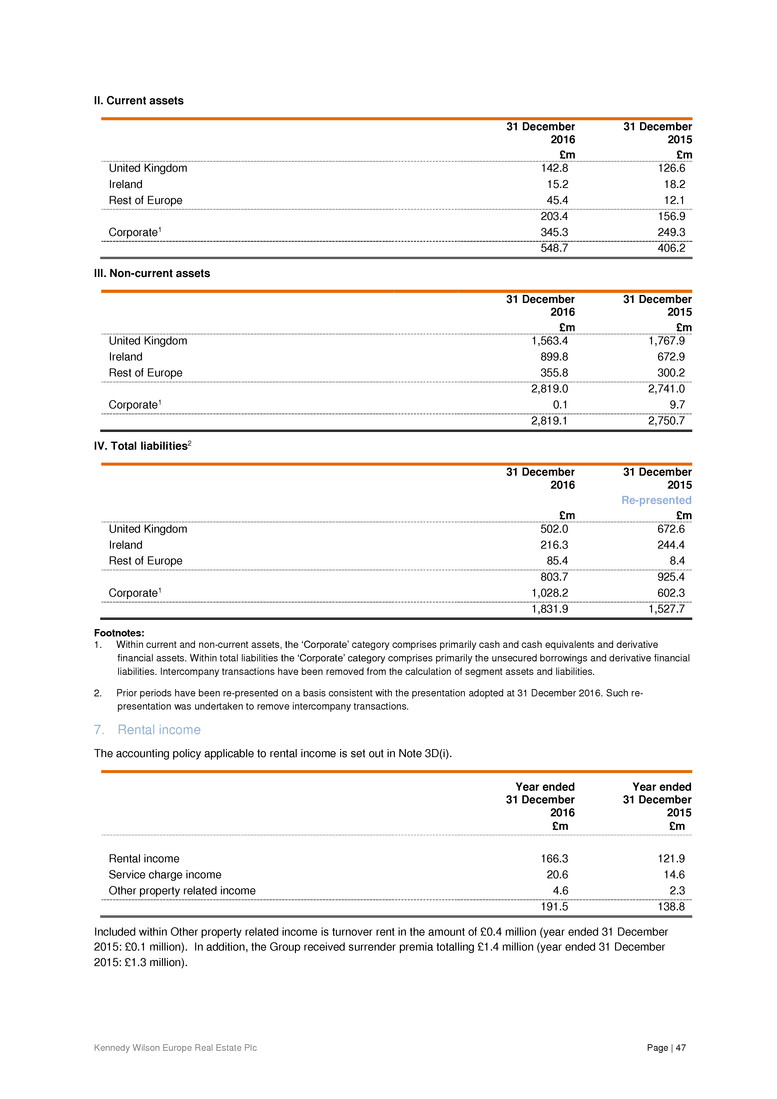
Kennedy Wilson Europe Real Estate Plc Page | 47 II. Current assets 31 December 2016 31 December 2015 £m £m United Kingdom 142.8 126.6 Ireland 15.2 18.2 Rest of Europe 45.4 12.1 203.4 156.9 Corporate1 345.3 249.3 548.7 406.2 III. Non-current assets 31 December 2016 31 December 2015 £m £m United Kingdom 1,563.4 1,767.9 Ireland 899.8 672.9 Rest of Europe 355.8 300.2 2,819.0 2,741.0 Corporate1 0.1 9.7 2,819.1 2,750.7 IV. Total liabilities2 31 December 2016 31 December 2015 Re-presented £m £m United Kingdom 502.0 672.6 Ireland 216.3 244.4 Rest of Europe 85.4 8.4 803.7 925.4 Corporate1 1,028.2 602.3 1,831.9 1,527.7 Footnotes: 1. Within current and non-current assets, the ‘Corporate’ category comprises primarily cash and cash equivalents and derivative financial assets. Within total liabilities the ‘Corporate’ category comprises primarily the unsecured borrowings and derivative financial liabilities. Intercompany transactions have been removed from the calculation of segment assets and liabilities. 2. Prior periods have been re-presented on a basis consistent with the presentation adopted at 31 December 2016. Such re- presentation was undertaken to remove intercompany transactions. 7. Rental income The accounting policy applicable to rental income is set out in Note 3D(i). Year ended 31 December 2016 Year ended 31 December 2015 £m £m Rental income 166.3 121.9 Service charge income 20.6 14.6 Other property related income 4.6 2.3 191.5 138.8 Included within Other property related income is turnover rent in the amount of £0.4 million (year ended 31 December 2015: £0.1 million). In addition, the Group received surrender premia totalling £1.4 million (year ended 31 December 2015: £1.3 million).
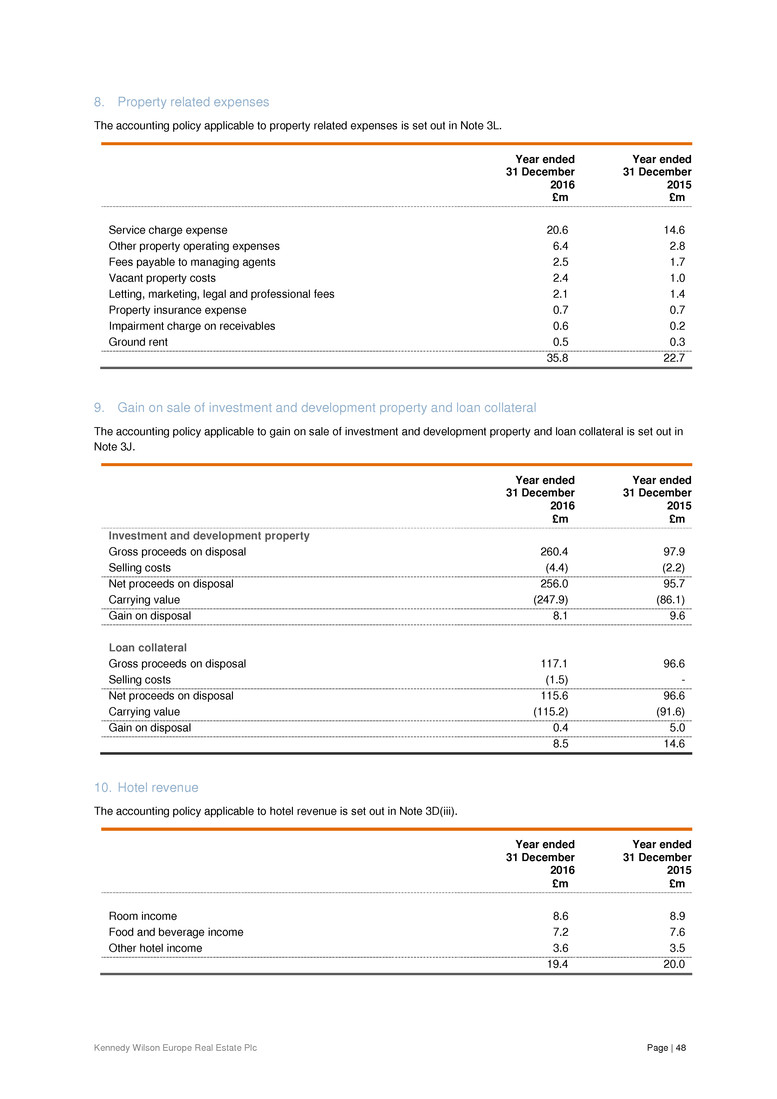
Kennedy Wilson Europe Real Estate Plc Page | 48 8. Property related expenses The accounting policy applicable to property related expenses is set out in Note 3L. Year ended 31 December 2016 Year ended 31 December 2015 £m £m Service charge expense 20.6 14.6 Other property operating expenses 6.4 2.8 Fees payable to managing agents 2.5 1.7 Vacant property costs 2.4 1.0 Letting, marketing, legal and professional fees 2.1 1.4 Property insurance expense 0.7 0.7 Impairment charge on receivables 0.6 0.2 Ground rent 0.5 0.3 35.8 22.7 9. Gain on sale of investment and development property and loan collateral The accounting policy applicable to gain on sale of investment and development property and loan collateral is set out in Note 3J. Year ended 31 December 2016 Year ended 31 December 2015 £m £m Investment and development property Gross proceeds on disposal 260.4 97.9 Selling costs (4.4) (2.2) Net proceeds on disposal 256.0 95.7 Carrying value (247.9) (86.1) Gain on disposal 8.1 9.6 Loan collateral Gross proceeds on disposal 117.1 96.6 Selling costs (1.5) - Net proceeds on disposal 115.6 96.6 Carrying value (115.2) (91.6) Gain on disposal 0.4 5.0 8.5 14.6 10. Hotel revenue The accounting policy applicable to hotel revenue is set out in Note 3D(iii). Year ended 31 December 2016 Year ended 31 December 2015 £m £m Room income 8.6 8.9 Food and beverage income 7.2 7.6 Other hotel income 3.6 3.5 19.4 20.0

Kennedy Wilson Europe Real Estate Plc Page | 49 11. Hotel cost of sales The accounting policy applicable to hotel cost of sales is set out in Note 3L. Year ended 31 December 2016 Year ended 31 December 2015 £m £m Wages and salaries 7.0 6.2 Consumables (Note 20) 2.4 2.4 Depreciation (Note 19) 3.2 2.2 Other costs 3.7 3.6 16.3 14.4 12. Administrative expenses The accounting policy applicable to administrative expenses is set out in Note 3L. Year ended 31 December 2016 Year ended 31 December 2015 £m £m Consultancy and other advisory fees 8.2 6.9 General expenses 4.4 5.1 Employee benefits 1.6 0.6 Legal fees 1.1 0.8 Audit and related fees (Note 39) 0.7 0.5 Directors’ fees (Note 31B(i)(a)) 0.3 0.3 Acquisition related expenditure 0.1 1.7 16.4 15.9 Included in the above table are costs associated with the hotel segment as follows: Year ended 31 December 2016 Year ended 31 December 2015 £m £m Hotel administrative costs General expenses 1.7 2.6 Employee benefit 1.6 0.6 Consultancy and other advisory fees 1.5 1.8 4.8 5.0 13. Finance income The accounting policies applicable to finance income are set out in Note 3D(ii) and Note 3F. Year ended 31 December 2016 Year ended 31 December 2015 £m £m Interest income from loans secured by real estate 6.3 13.4 Interest income from cash and cash equivalents 0.6 0.6 6.9 14.0
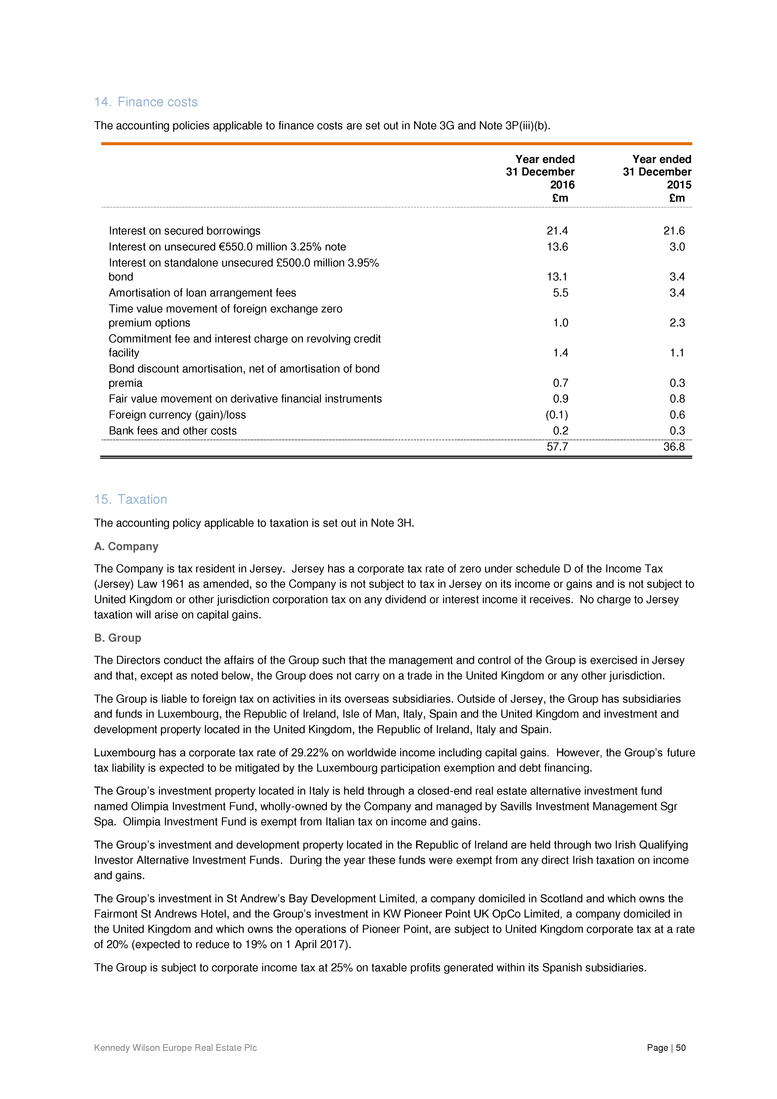
Kennedy Wilson Europe Real Estate Plc Page | 50 14. Finance costs The accounting policies applicable to finance costs are set out in Note 3G and Note 3P(iii)(b). Year ended 31 December 2016 Year ended 31 December 2015 £m £m Interest on secured borrowings 21.4 21.6 Interest on unsecured €550.0 million 3.25% note 13.6 3.0 Interest on standalone unsecured £500.0 million 3.95% bond 13.1 3.4 Amortisation of loan arrangement fees 5.5 3.4 Time value movement of foreign exchange zero premium options 1.0 2.3 Commitment fee and interest charge on revolving credit facility 1.4 1.1 Bond discount amortisation, net of amortisation of bond premia 0.7 0.3 Fair value movement on derivative financial instruments 0.9 0.8 Foreign currency (gain)/loss (0.1) 0.6 Bank fees and other costs 0.2 0.3 57.7 36.8 15. Taxation The accounting policy applicable to taxation is set out in Note 3H. A. Company The Company is tax resident in Jersey. Jersey has a corporate tax rate of zero under schedule D of the Income Tax (Jersey) Law 1961 as amended, so the Company is not subject to tax in Jersey on its income or gains and is not subject to United Kingdom or other jurisdiction corporation tax on any dividend or interest income it receives. No charge to Jersey taxation will arise on capital gains. B. Group The Directors conduct the affairs of the Group such that the management and control of the Group is exercised in Jersey and that, except as noted below, the Group does not carry on a trade in the United Kingdom or any other jurisdiction. The Group is liable to foreign tax on activities in its overseas subsidiaries. Outside of Jersey, the Group has subsidiaries and funds in Luxembourg, the Republic of Ireland, Isle of Man, Italy, Spain and the United Kingdom and investment and development property located in the United Kingdom, the Republic of Ireland, Italy and Spain. Luxembourg has a corporate tax rate of 29.22% on worldwide income including capital gains. However, the Group’s future tax liability is expected to be mitigated by the Luxembourg participation exemption and debt financing. The Group’s investment property located in Italy is held through a closed-end real estate alternative investment fund named Olimpia Investment Fund, wholly-owned by the Company and managed by Savills Investment Management Sgr Spa. Olimpia Investment Fund is exempt from Italian tax on income and gains. The Group’s investment and development property located in the Republic of Ireland are held through two Irish Qualifying Investor Alternative Investment Funds. During the year these funds were exempt from any direct Irish taxation on income and gains. The Group’s investment in St Andrew’s Bay Development Limited, a company domiciled in Scotland and which owns the Fairmont St Andrews Hotel, and the Group’s investment in KW Pioneer Point UK OpCo Limited, a company domiciled in the United Kingdom and which owns the operations of Pioneer Point, are subject to United Kingdom corporate tax at a rate of 20% (expected to reduce to 19% on 1 April 2017). The Group is subject to corporate income tax at 25% on taxable profits generated within its Spanish subsidiaries.
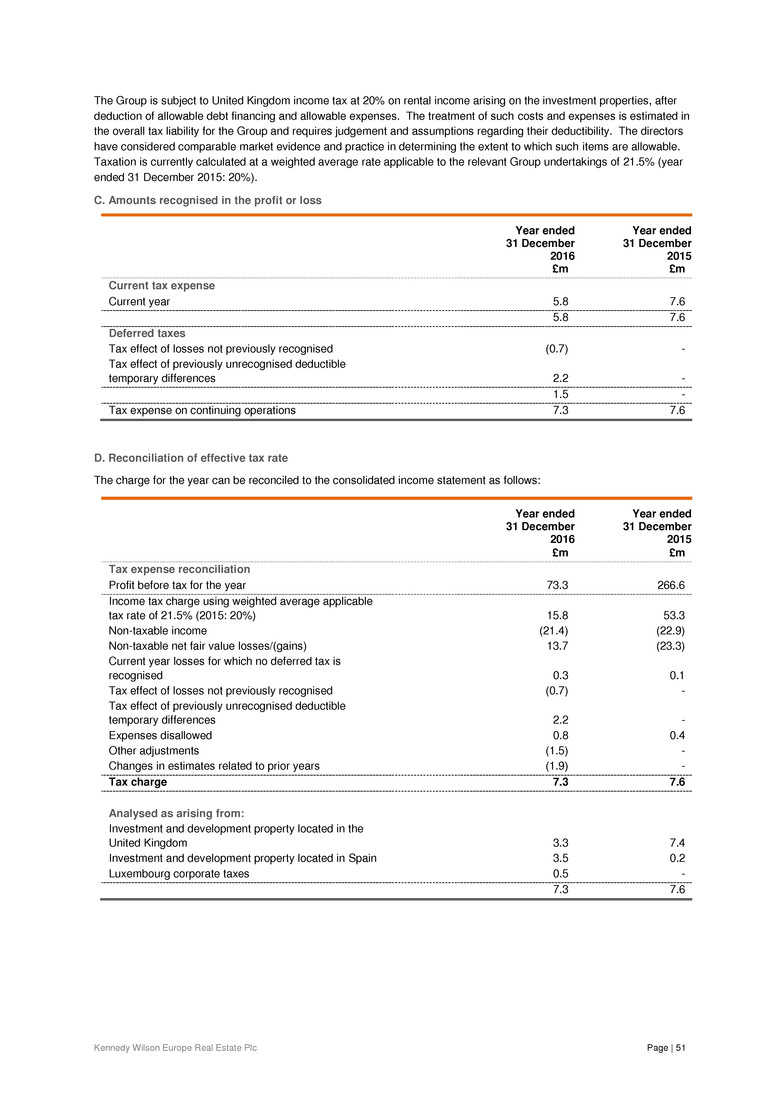
Kennedy Wilson Europe Real Estate Plc Page | 51 The Group is subject to United Kingdom income tax at 20% on rental income arising on the investment properties, after deduction of allowable debt financing and allowable expenses. The treatment of such costs and expenses is estimated in the overall tax liability for the Group and requires judgement and assumptions regarding their deductibility. The directors have considered comparable market evidence and practice in determining the extent to which such items are allowable. Taxation is currently calculated at a weighted average rate applicable to the relevant Group undertakings of 21.5% (year ended 31 December 2015: 20%). C. Amounts recognised in the profit or loss Year ended 31 December 2016 Year ended 31 December 2015 £m £m Current tax expense Current year 5.8 7.6 5.8 7.6 Deferred taxes Tax effect of losses not previously recognised (0.7) - Tax effect of previously unrecognised deductible temporary differences 2.2 - 1.5 - Tax expense on continuing operations 7.3 7.6 D. Reconciliation of effective tax rate The charge for the year can be reconciled to the consolidated income statement as follows: Year ended 31 December 2016 Year ended 31 December 2015 £m £m Tax expense reconciliation Profit before tax for the year 73.3 266.6 Income tax charge using weighted average applicable tax rate of 21.5% (2015: 20%) 15.8 53.3 Non-taxable income (21.4) (22.9) Non-taxable net fair value losses/(gains) 13.7 (23.3) Current year losses for which no deferred tax is recognised 0.3 0.1 Tax effect of losses not previously recognised (0.7) - Tax effect of previously unrecognised deductible temporary differences 2.2 - Expenses disallowed 0.8 0.4 Other adjustments (1.5) - Changes in estimates related to prior years (1.9) - Tax charge 7.3 7.6 Analysed as arising from: Investment and development property located in the United Kingdom 3.3 7.4 Investment and development property located in Spain 3.5 0.2 Luxembourg corporate taxes 0.5 - 7.3 7.6

Kennedy Wilson Europe Real Estate Plc Page | 52 E. Movement in deferred tax balances Year ended 31 December 2016 Year ended 31 December 2015 £m £m Deferred tax asset 2.9 1.5 Deferred tax liability (2.4) - 0.5 1.5 Analysed as arising from: Investment property Opening balance - - Origination and reversal of temporary differences (2.2) - Closing balance (2.2) - Tax losses Opening balance 1.5 - Origination and reversal of temporary differences 0.7 1.5 Effects of translation to presentation currency 0.5 - Closing balance 2.7 1.5 0.5 1.5 F. Unrecognised deferred tax asset Deferred tax assets have not been recognised in respect of the following items, because it is not probable that future taxable profits will be available against which the Group can use the benefits therefrom. The Group is only able to utilise the losses to offset taxable profits in certain discrete business streams. Year ended 31 December 2016 Year ended 31 December 2015 £m £m Tax losses brought forward 10.5 10.0 Deductible temporary differences 4.7 4.6 15.2 14.6 Brought forward tax losses total £46.8 million (December 2015: £44.6 million) and brought forward deductible temporary differences total £23.6 million (December 2015: £22.7 million). The directors have established that it is uncertain whether future taxable profits would be available against which these amounts can be utilised, and therefore these amounts have been included in the balance of unrecognised deferred tax assets above.
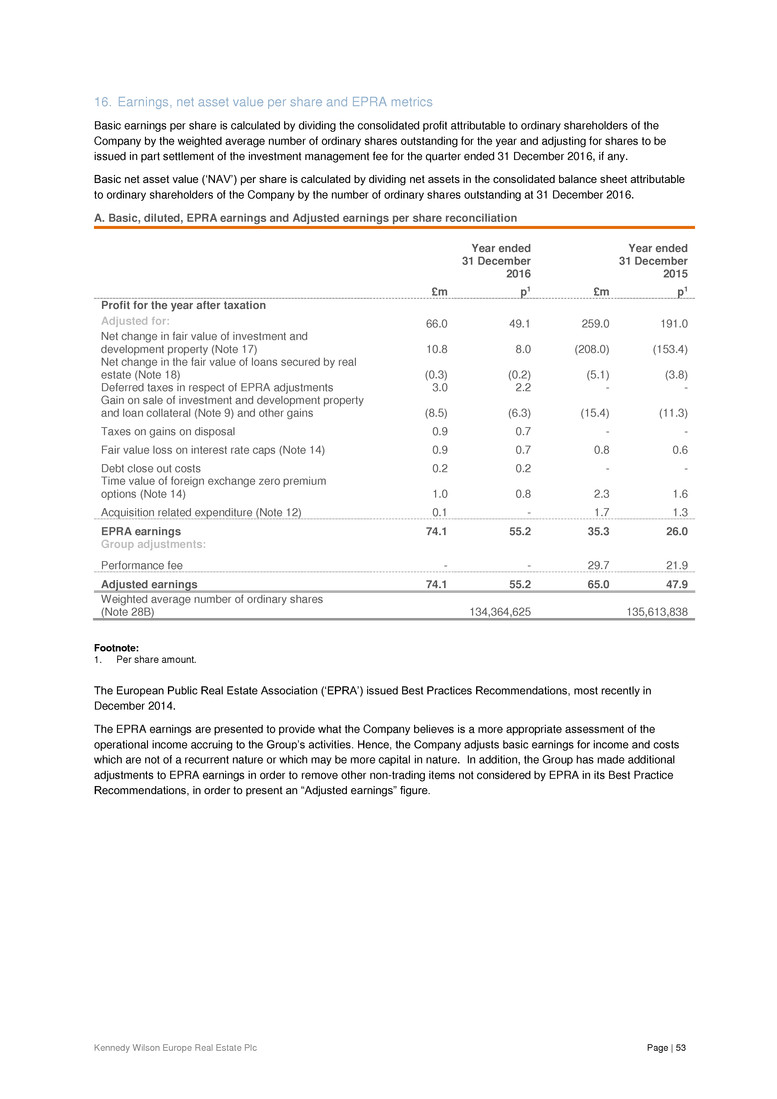
Kennedy Wilson Europe Real Estate Plc Page | 53 16. Earnings, net asset value per share and EPRA metrics Basic earnings per share is calculated by dividing the consolidated profit attributable to ordinary shareholders of the Company by the weighted average number of ordinary shares outstanding for the year and adjusting for shares to be issued in part settlement of the investment management fee for the quarter ended 31 December 2016, if any. Basic net asset value (‘NAV’) per share is calculated by dividing net assets in the consolidated balance sheet attributable to ordinary shareholders of the Company by the number of ordinary shares outstanding at 31 December 2016. A. Basic, diluted, EPRA earnings and Adjusted earnings per share reconciliation Year ended 31 December 2016 Year ended 31 December 2015 £m p1 £m p1 Profit for the year after taxation Adjusted for: 66.0 49.1 259.0 191.0 Net change in fair value of investment and development property (Note 17) 10.8 8.0 (208.0) (153.4) Net change in the fair value of loans secured by real estate (Note 18) (0.3) (0.2) (5.1) (3.8) Deferred taxes in respect of EPRA adjustments 3.0 2.2 - - Gain on sale of investment and development property and loan collateral (Note 9) and other gains (8.5) (6.3) (15.4) (11.3) Taxes on gains on disposal 0.9 0.7 - - Fair value loss on interest rate caps (Note 14) 0.9 0.7 0.8 0.6 Debt close out costs 0.2 0.2 - - Time value of foreign exchange zero premium options (Note 14) 1.0 0.8 2.3 1.6 Acquisition related expenditure (Note 12) 0.1 - 1.7 1.3 EPRA earnings 74.1 55.2 35.3 26.0 Group adjustments: Performance fee - - 29.7 21.9 Adjusted earnings 74.1 55.2 65.0 47.9 Weighted average number of ordinary shares (Note 28B) 134,364,625 135,613,838 Footnote: 1. Per share amount. The European Public Real Estate Association (‘EPRA’) issued Best Practices Recommendations, most recently in December 2014. The EPRA earnings are presented to provide what the Company believes is a more appropriate assessment of the operational income accruing to the Group’s activities. Hence, the Company adjusts basic earnings for income and costs which are not of a recurrent nature or which may be more capital in nature. In addition, the Group has made additional adjustments to EPRA earnings in order to remove other non-trading items not considered by EPRA in its Best Practice Recommendations, in order to present an “Adjusted earnings” figure.

Kennedy Wilson Europe Real Estate Plc Page | 54 B. Basic, EPRA NAV, Adjusted NAV and EPRA NNNAV per share reconciliation 31 December 2016 31 December 2015 £m p1 £m p1 Basic NAV 1,535.9 1,217.6 1,629.2 1,198.5 Adjusted for: Mark-to-market of derivative financial assets (Note 26) (0.3) (0.2) (0.9) (0.7) EPRA NAV 1,535.6 1,217.4 1,628.3 1,197.8 Group adjustments: Performance fee (Note 31A(ii)) - - (29.7) (21.8) Investment management fee (Note 31A(i)) (1.9) (1.5) (2.1) (1.5) Adjusted NAV 1,533.7 1,215.9 1,596.5 1,174.5 EPRA NNNAV EPRA NAV 1,535.6 1,217.4 1,628.3 1,197.8 Fair value of derivative financial assets (Note 26) 0.3 0.2 0.9 0.7 Fair value of borrowings2 (Note 25) (35.1) (27.8) (6.0) (4.2) EPRA NNNAV 1,500.8 1,189.8 1,623.2 1,194.3 Number of shares Ordinary shares in issue (Note 28A) 126,133,407 135,933,938 Footnotes: 1. Per share amount. 2. Represents the difference between the book value of borrowings and the fair value of borrowings. EPRA has issued guidelines aimed at providing a measure of NAV on the basis of the long term fair values. At each of 31 December 2016 and 31 December 2015, there was no material deferred tax applicable to the business and there are no dilutive or potentially dilutive equity arrangements in existence. In addition, the Group reports an Adjusted NAV to illustrate EPRA NAV after the impact of fees recognised in the share- based payment reserve. EPRA NNNAV is a measure to report the net asset value including fair value adjustments in respect of all material balance sheet items which are not reported at their fair value as part of EPRA NAV.

Kennedy Wilson Europe Real Estate Plc Page | 55 17. Investment and development property The accounting policies applicable to investment and development property are set out in Note 3J and the fair value disclosures contained in Note 5A, and the accounting policies applicable to assets held-for-sale are set out in Note 3N. 31 December 2016 31 December 2015 £m £m Investment property Opening balance 2,367.0 1,182.5 Acquisition of investment property 169.1 1,011.7 Acquisition of collateral from loans secured by real estate - 139.9 Disposal of investment property (187.7) (86.1) Improvements to investment property 47.0 22.4 Transfer from/(to) investment property under development 148.5 (3.2) Transfer to assets held-for-sale (Note 37) (48.3) (51.0) Net change in fair value (35.0) 173.0 Effects of translation to presentation currency 134.3 (22.2) Closing balance 2,594.9 2,367.0 31 December 2016 31 December 2015 £m £m Investment property under development Opening balance 133.2 35.8 Acquisition of investment property under development 20.1 28.8 Disposal of investment property under development (9.0) - Development expenditure 47.6 31.8 Transfer from/(to) investment property (148.5) 3.2 Transfer to assets held-for-sale (Note 37) (11.1) - Net change in fair value 24.2 35.0 Effects of translation to presentation currency 23.9 (1.4) Closing balance 80.4 133.2 Disclosed as: Carrying value of investment and development property 2,675.3 2,500.2 Assets held-for-sale (Note 37) 59.4 51.0 Adjustment in respect of straight line rent (Note 21)1 6.9 3.1 Fair value of investment and development property 2,741.6 2,554.3 Footnote: 1. Included as a component of the “Rent and other receivables” balance in the consolidated balance sheet. The historical cost of investment properties acquired during the year, inclusive of acquisition costs, is £169.1 million (year ended 31 December 2015: £1,011.7 million). The total expenditure incurred to acquire investment properties under development during the year is £20.1 million (year ended 31 December 2015: £28.8 million). Acquisition costs which comprise primarily stamp duty, legal services and other directly attributable costs arising from the transactions, amounted to £4.8 million (year ended 31 December 2015: £34.5 million). The net fair value loss of £10.8 million (December 2015: net fair value gain £208.0 million) recognised in respect of investment and development property has been recognised in the consolidated income statement.

Kennedy Wilson Europe Real Estate Plc Page | 56 Long term leasehold values included within investment properties amount to £355.8 million (December 2015: £401.7 million). The leasehold investment properties have lease terms ranging between 125 and 999 years (December 2015: 125 to 999 years). All other properties are freehold. At 31 December 2016, the Group was contractually committed to £8.8 million (December 2015: £66.1 million) of future expenditure for the purchase, construction, development and enhancement of investment and development property. See further details in Note 35A. The Group complies with IAS 40 Investment Properties. A. Valuation process The Group utilises the staff of the Investment Manager and certain of its affiliates (the ‘Investment Manager Group’) who hold relevant internationally recognised professional qualifications and are experienced in valuing the types of properties in the applicable locations. The valuations are based on: Information provided by the Investment Manager Group including rents, lease terms, revenue and capital expenditure. Such information is derived from the Investment Manager Group’s financial and property systems and is subject to the Group’s overall control environment. Valuation models used by the external valuers, including market related assumptions based on their professional judgement and market observation. The Investment Manager reviews the valuations arrived at by the external valuers. This review includes a discussion with the Board and separately with the external valuers on the assumptions used, the process and methodology undertaken and a review of the data considered by the external valuers. The Board determines the Group’s valuation policies and procedures for property valuation. The Board decides which external valuer to appoint to be responsible for the external valuations of the Group’s properties. Selection criteria include market knowledge, reputation, independence and whether professional standards are maintained. The Board decides after discussions with the Group’s external valuers and the Investment Manager: Whether a property’s fair value can be reliably determined; Which valuation method should be applied for each property; The assumptions made for unobservable inputs used in the valuation method for investment property (the major unobservable inputs are estimated rent per square foot/square metre/unit, estimated rental value and equivalent yield); and The assumptions made for unobservable inputs used in the valuation method for investment property under development (the major unobservable inputs are, as appropriate to each development asset, build cost per square foot/square metre, net initial yield, sales value per square foot/square metre and price per acre). The fair value of the Group’s investment and development property at 31 December 2016 has been arrived at on the basis of a valuation carried out at that date by our external valuers. CBRE valued all investment and development properties, except for the Italian portfolio which was valued by Colliers Real Estate Services Italia S.r.l. con socio unico (together, the ‘Valuers’). The valuations performed by the Valuers, conform to IFRS 13 Fair Value Measurement, the Valuation Standards of the Royal Institution of Chartered Surveyors Professional Standards 2014 (the ‘RICS Red Book’) and with the International Valuation Board’s International Valuation Standards, and were arrived at by reference to market comparables for similar properties. The Valuers submit and present summary reports to the Group’s Audit Committee. The Valuers are independent and external to the Group and the Investment Manager. Valuations are performed bi-annually and are performed consistently across all properties in the Group’s portfolio. The valuation dates are 30 June and 31 December, and a valuation is normally conducted regardless of the date of acquisition. This includes a physical inspection of all properties, at least once a year. In line with IFRS 13 all investment properties are valued on the basis of their highest and best use. When considering the highest and best use a valuer will consider, on a property by property basis, its actual and potential uses which are physically, legally and financially viable. Where the highest and best use differs from the existing use, the valuer will consider the cost and likelihood of achieving and implementing this change in arriving at its valuation. Annual valuation fees are calculated as a fixed percentage of the value of the investment and development property, as agreed between the Group and the Valuers. The Valuers have advised us that the fees earned by each of them from the Group are less than 5% of their total revenue in any year. In addition to the valuation work, CBRE has carried out agency and professional services on behalf of the Group since inception.

Kennedy Wilson Europe Real Estate Plc Page | 57 The Group, consistent with EPRA’s guidance, consider that all of its investment and development property falls within Level 3 of the fair value hierarchy, as defined by IFRS 13 (as discussed in Note 5A). The valuations have been prepared on the basis of Market Value which is defined in the RICS Valuation Standards as: “The estimated amount for which a property should exchange on the date of valuation between a willing buyer and a willing seller in an arm’s length transaction after proper marketing wherein the parties had acted knowledgeably, prudent ly and without compulsion.” Market Value as defined in the RICS Valuation Standards is the equivalent of fair value under IFRS. (i). Investment property To determine the value of investment property, the income approach is used. This involves applying market derived capitalisation yields to current and market derived future income streams with appropriate adjustments for income voids arising from vacancies, or rent-free periods. These capitalisation yields and future income streams are derived from comparable property and leasing transactions and are considered to be key inputs in the valuation. Other factors that are taken into account include the tenure of the property, tenancy details, planning, building and environmental factors that might affect the property. The comparison methodology is used for residential properties whereby the fair value is calculated using data from recent market transactions. The following tables set out the valuation techniques and the key unobservable inputs used in the valuation of the Group’s investment property.
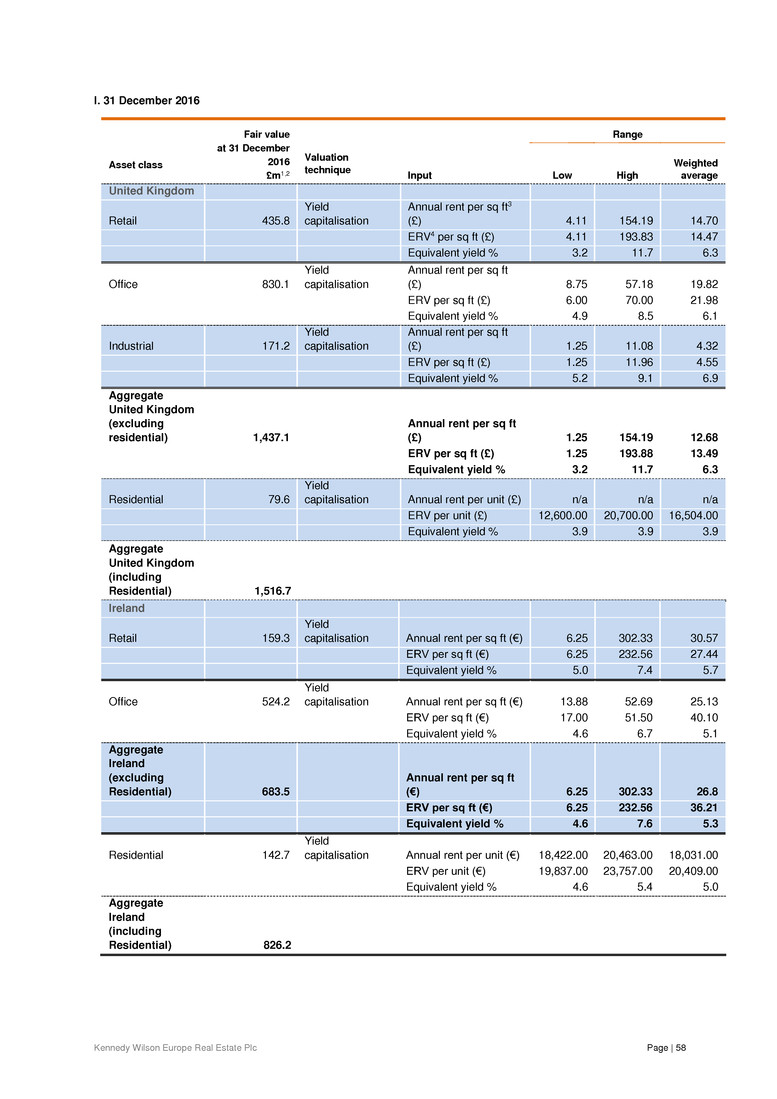
Kennedy Wilson Europe Real Estate Plc Page | 58 I. 31 December 2016 Asset class Fair value at 31 December 2016 £m1,2 Range Valuation technique Input Low High Weighted average United Kingdom Retail 435.8 Yield capitalisation Annual rent per sq ft3 (£) 4.11 154.19 14.70 ERV4 per sq ft (£) 4.11 193.83 14.47 Equivalent yield % 3.2 11.7 6.3 Office 830.1 Yield capitalisation Annual rent per sq ft (£) 8.75 57.18 19.82 ERV per sq ft (£) 6.00 70.00 21.98 Equivalent yield % 4.9 8.5 6.1 Industrial 171.2 Yield capitalisation Annual rent per sq ft (£) 1.25 11.08 4.32 ERV per sq ft (£) 1.25 11.96 4.55 Equivalent yield % 5.2 9.1 6.9 Aggregate United Kingdom (excluding residential) 1,437.1 Annual rent per sq ft (£) 1.25 154.19 12.68 ERV per sq ft (£) 1.25 193.88 13.49 Equivalent yield % 3.2 11.7 6.3 Residential 79.6 Yield capitalisation Annual rent per unit (£) n/a n/a n/a ERV per unit (£) 12,600.00 20,700.00 16,504.00 Equivalent yield % 3.9 3.9 3.9 Aggregate United Kingdom (including Residential) 1,516.7 Ireland Retail 159.3 Yield capitalisation Annual rent per sq ft (€) 6.25 302.33 30.57 ERV per sq ft (€) 6.25 232.56 27.44 Equivalent yield % 5.0 7.4 5.7 Office 524.2 Yield capitalisation Annual rent per sq ft (€) 13.88 52.69 25.13 ERV per sq ft (€) 17.00 51.50 40.10 Equivalent yield % 4.6 6.7 5.1 Aggregate Ireland (excluding Residential) 683.5 Annual rent per sq ft (€) 6.25 302.33 26.8 ERV per sq ft (€) 6.25 232.56 36.21 Equivalent yield % 4.6 7.6 5.3 Residential 142.7 Yield capitalisation Annual rent per unit (€) 18,422.00 20,463.00 18,031.00 ERV per unit (€) 19,837.00 23,757.00 20,409.00 Equivalent yield % 4.6 5.4 5.0 Aggregate Ireland (including Residential) 826.2
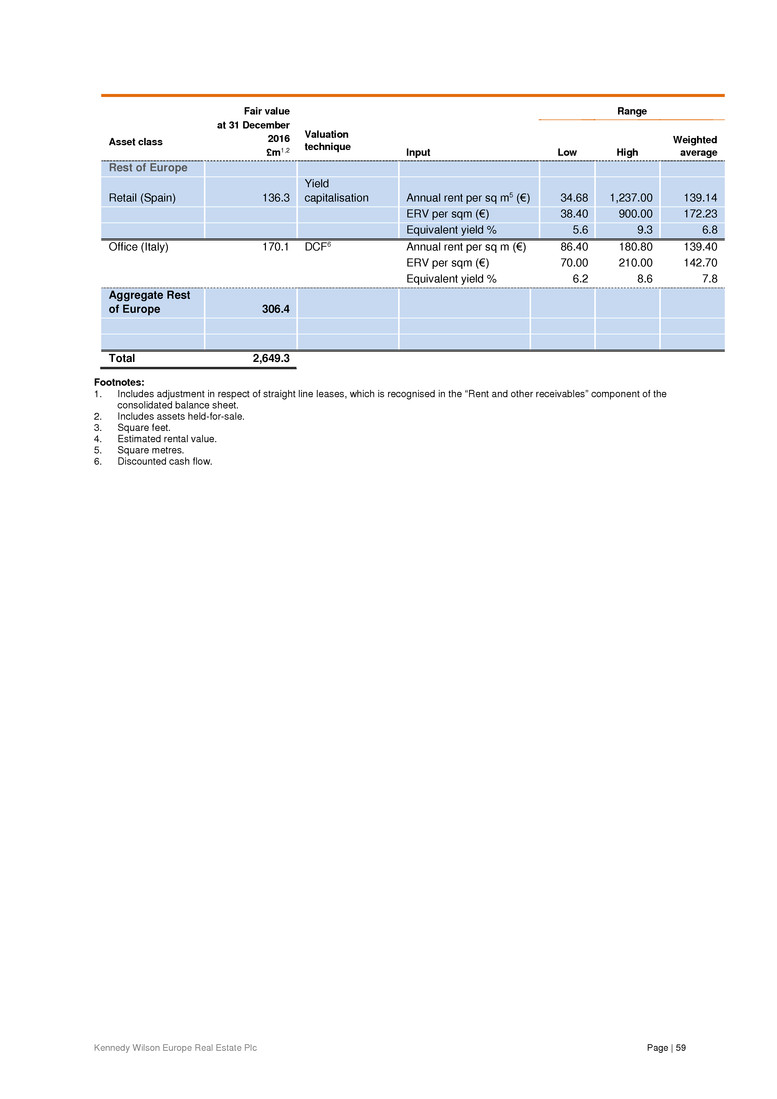
Kennedy Wilson Europe Real Estate Plc Page | 59 Asset class Fair value at 31 December 2016 £m1,2 Range Valuation technique Input Low High Weighted average Rest of Europe Retail (Spain) 136.3 Yield capitalisation Annual rent per sq m5 (€) 34.68 1,237.00 139.14 ERV per sqm (€) 38.40 900.00 172.23 Equivalent yield % 5.6 9.3 6.8 Office (Italy) 170.1 DCF6 Annual rent per sq m (€) 86.40 180.80 139.40 ERV per sqm (€) 70.00 210.00 142.70 Equivalent yield % 6.2 8.6 7.8 Aggregate Rest of Europe 306.4 Total 2,649.3 Footnotes: 1. Includes adjustment in respect of straight line leases, which is recognised in the “Rent and other receivables” component of the consolidated balance sheet. 2. Includes assets held-for-sale. 3. Square feet. 4. Estimated rental value. 5. Square metres. 6. Discounted cash flow.
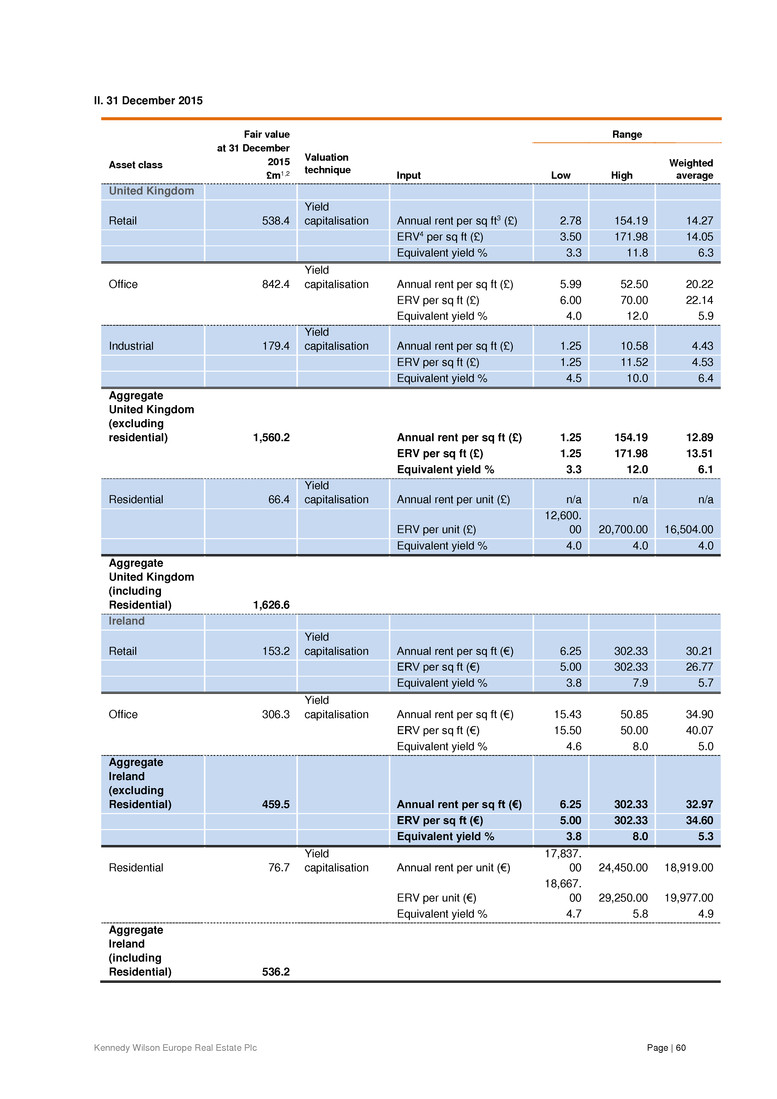
Kennedy Wilson Europe Real Estate Plc Page | 60 II. 31 December 2015 Asset class Fair value at 31 December 2015 £m1,2 Range Valuation technique Input Low High Weighted average United Kingdom Retail 538.4 Yield capitalisation Annual rent per sq ft3 (£) 2.78 154.19 14.27 ERV4 per sq ft (£) 3.50 171.98 14.05 Equivalent yield % 3.3 11.8 6.3 Office 842.4 Yield capitalisation Annual rent per sq ft (£) 5.99 52.50 20.22 ERV per sq ft (£) 6.00 70.00 22.14 Equivalent yield % 4.0 12.0 5.9 Industrial 179.4 Yield capitalisation Annual rent per sq ft (£) 1.25 10.58 4.43 ERV per sq ft (£) 1.25 11.52 4.53 Equivalent yield % 4.5 10.0 6.4 Aggregate United Kingdom (excluding residential) 1,560.2 Annual rent per sq ft (£) 1.25 154.19 12.89 ERV per sq ft (£) 1.25 171.98 13.51 Equivalent yield % 3.3 12.0 6.1 Residential 66.4 Yield capitalisation Annual rent per unit (£) n/a n/a n/a ERV per unit (£) 12,600. 00 20,700.00 16,504.00 Equivalent yield % 4.0 4.0 4.0 Aggregate United Kingdom (including Residential) 1,626.6 Ireland Retail 153.2 Yield capitalisation Annual rent per sq ft (€) 6.25 302.33 30.21 ERV per sq ft (€) 5.00 302.33 26.77 Equivalent yield % 3.8 7.9 5.7 Office 306.3 Yield capitalisation Annual rent per sq ft (€) 15.43 50.85 34.90 ERV per sq ft (€) 15.50 50.00 40.07 Equivalent yield % 4.6 8.0 5.0 Aggregate Ireland (excluding Residential) 459.5 Annual rent per sq ft (€) 6.25 302.33 32.97 ERV per sq ft (€) 5.00 302.33 34.60 Equivalent yield % 3.8 8.0 5.3 Residential 76.7 Yield capitalisation Annual rent per unit (€) 17,837. 00 24,450.00 18,919.00 ERV per unit (€) 18,667. 00 29,250.00 19,977.00 Equivalent yield % 4.7 5.8 4.9 Aggregate Ireland (including Residential) 536.2

Kennedy Wilson Europe Real Estate Plc Page | 61 Asset class Fair value at 31 December 2015 £m1,2 Range Valuation technique Input Low High Weighted average Rest of Europe Retail (Spain) 116.7 Yield capitalisation Annual rent per sq m5 (€) 30.95 1,237.00 140.32 ERV per sqm (€) 39.00 660.03 166.97 Equivalent yield % 5.4 9.5 7.0 Office (Italy) 141.6 DCF6 Annual rent per sq m (€) 86.40 180.80 139.40 ERV per sqm (€) 60.00 200.00 130.60 Equivalent yield % 6.2 9.1 7.6 Aggregate Rest of Europe 258.3 Total 2,421.1 Footnotes: 1. Includes adjustment in respect of straight line leases, which is recognised in the “Rent and other receivables” component of the consolidated balance sheet. 2. Includes assets held-for-sale. 3. Square feet. 4. Estimated rental value. 5. Square metres. 6. Discounted cash flow. (ii). Investment property under development At 31 December 2016, Investment property under development includes: A retail property at Puerta del Sol 9 in Madrid, Spain; Residential real estate at Postigo de San Martín 3 in Madrid, Spain for conversion into a hotel; An office building at Santisima Trinidad 5 in Madrid, Spain for conversion to residential real estate; A second generation office building in Dublin, Ireland (‘Schoolhouse Lane’); and A site in suburban County Dublin, Ireland (the ‘Stillorgan Leisureplex’). At 31 December 2015 this caption also included the following assets, all of which achieved practical completion during the year ended 31 December 2016: A second generation office building in Dublin, Ireland (‘Baggot Plaza’); and A partially built development site in the Central Park portfolio in Dublin, Ireland (‘Block K’). Investment property under development in Ireland is valued using the Investment method, with deduction for costs necessary to complete the development. Investment property under development in the Rest of Europe is valued using the “residual method” which is the investment method, with a deduction for costs necessary to complete the development together with an allowance for the remaining risk. Development land has been valued using the comparison method, arriving at a price per acre.
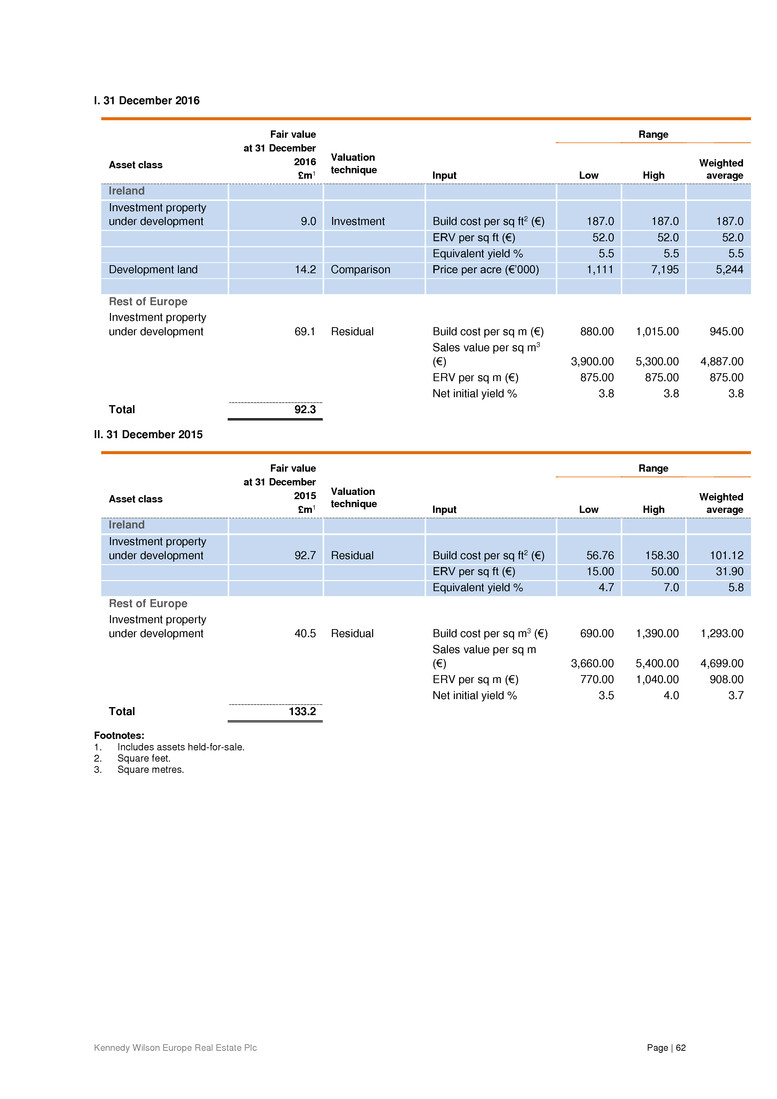
Kennedy Wilson Europe Real Estate Plc Page | 62 I. 31 December 2016 Asset class Fair value at 31 December 2016 £m1 Range Valuation technique Input Low High Weighted average Ireland Investment property under development 9.0 Investment Build cost per sq ft2 (€) 187.0 187.0 187.0 ERV per sq ft (€) 52.0 52.0 52.0 Equivalent yield % 5.5 5.5 5.5 Development land 14.2 Comparison Price per acre (€’000) 1,111 7,195 5,244 Rest of Europe Investment property under development 69.1 Residual Build cost per sq m (€) 880.00 1,015.00 945.00 Sales value per sq m3 (€) 3,900.00 5,300.00 4,887.00 ERV per sq m (€) 875.00 875.00 875.00 Net initial yield % 3.8 3.8 3.8 Total 92.3 II. 31 December 2015 Asset class Fair value at 31 December 2015 £m1 Range Valuation technique Input Low High Weighted average Ireland Investment property under development 92.7 Residual Build cost per sq ft2 (€) 56.76 158.30 101.12 ERV per sq ft (€) 15.00 50.00 31.90 Equivalent yield % 4.7 7.0 5.8 Rest of Europe Investment property under development 40.5 Residual Build cost per sq m3 (€) 690.00 1,390.00 1,293.00 Sales value per sq m (€) 3,660.00 5,400.00 4,699.00 ERV per sq m (€) 770.00 1,040.00 908.00 Net initial yield % 3.5 4.0 3.7 Total 133.2 Footnotes: 1. Includes assets held-for-sale. 2. Square feet. 3. Square metres.

Kennedy Wilson Europe Real Estate Plc Page | 63 B. Sensitivity of measurement to variance of significant unobservable inputs There are inter-relationships between all these unobservable inputs as they are determined by market conditions. The existence of an increase in more than one unobservable input would be to magnify the impact on the valuation. The impact on the valuation will be mitigated by the inter-relationship of two unobservable inputs moving in directions which have an opposite impact on value for example an increase in rent may be offset by an increase in yield, resulting in no net impact on the valuation. However if the inputs move in opposite directions (for example ERV increases and equivalent yield decreases), valuation movements can be amplified whereas if they move in the same direction, they may offset reducing the overall net valuation movement. (i). Investment property Rents and ERVs have a direct relationship to fair value, while equivalent yield has an inverse relationship. The following table shows the impact on the fair value of investment property by applying a sensitivity to significant unobservable inputs. I. 31 December 2016 Fair value at 31 December 20161,2 Impact on valuations of a 5% change in ERV Impact on valuations of a 25 bps change in equivalent yield Increase Decrease Increase Decrease £m £m £m £m £m United Kingdom Retail 435.8 12.0 (11.5) (17.3) 18.9 Office 830.1 34.1 (34.0) (37.2) 40.5 Industrial 171.2 5.2 (5.0) (6.5) 7.0 Residential 79.6 4.2 (4.0) (5.1) 5.8 1,516.7 55.5 (54.5) (66.1) 72.2 Ireland Retail 159.3 5.7 (5.1) (4.9) 5.5 Office 524.2 22.5 (21.7) (25.4) 28.0 Residential 142.7 7.3 (7.3) (6.5) 7.0 826.2 35.5 (34.1) (36.8) 40.5 Rest of Europe Retail 136.3 5.2 (5.2) (5.5) 6.0 Office 170.1 7.0 (7.0) (5.8) 6.2 306.4 12.2 (12.2) (11.3) 12.2 2,649.3 103.2 (100.8) (114.2) 124.9 Footnotes: 1. Includes adjustment in respect of straight line leases, which is recognised in the “Rent and other receivables” component of the consolidated balance sheet. 2. Includes assets held-for-sale.
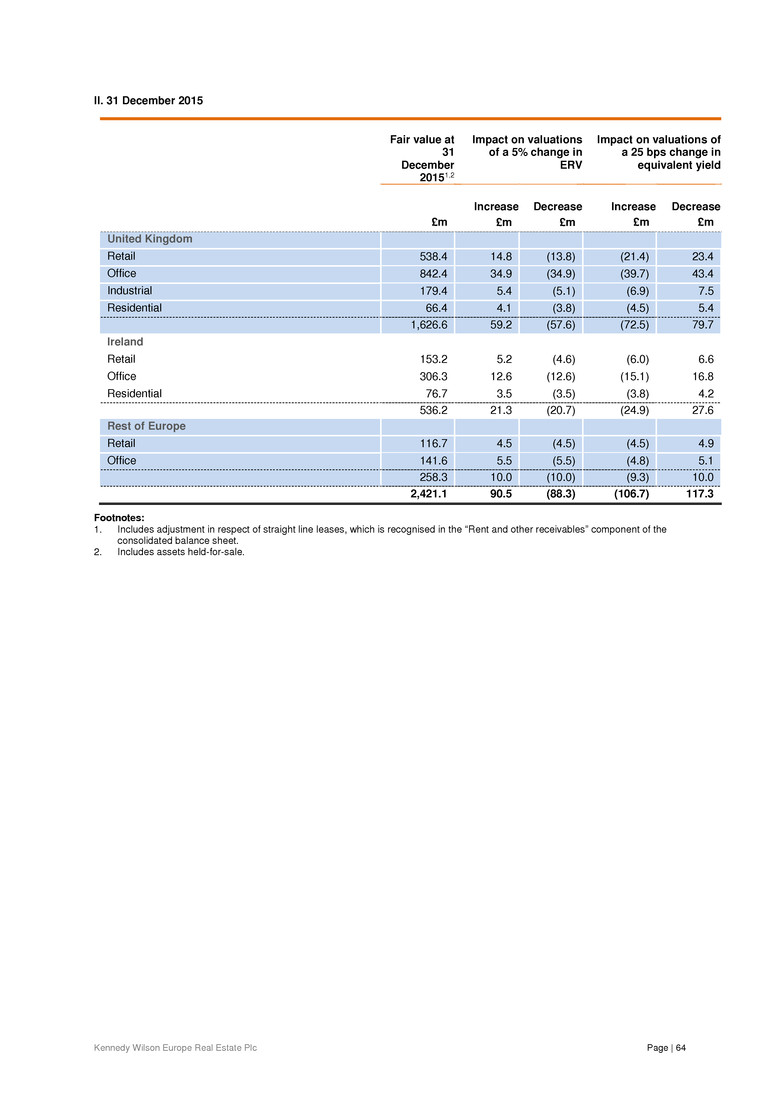
Kennedy Wilson Europe Real Estate Plc Page | 64 II. 31 December 2015 Fair value at 31 December 20151,2 Impact on valuations of a 5% change in ERV Impact on valuations of a 25 bps change in equivalent yield Increase Decrease Increase Decrease £m £m £m £m £m United Kingdom Retail 538.4 14.8 (13.8) (21.4) 23.4 Office 842.4 34.9 (34.9) (39.7) 43.4 Industrial 179.4 5.4 (5.1) (6.9) 7.5 Residential 66.4 4.1 (3.8) (4.5) 5.4 1,626.6 59.2 (57.6) (72.5) 79.7 Ireland Retail 153.2 5.2 (4.6) (6.0) 6.6 Office 306.3 12.6 (12.6) (15.1) 16.8 Residential 76.7 3.5 (3.5) (3.8) 4.2 536.2 21.3 (20.7) (24.9) 27.6 Rest of Europe Retail 116.7 4.5 (4.5) (4.5) 4.9 Office 141.6 5.5 (5.5) (4.8) 5.1 258.3 10.0 (10.0) (9.3) 10.0 2,421.1 90.5 (88.3) (106.7) 117.3 Footnotes: 1. Includes adjustment in respect of straight line leases, which is recognised in the “Rent and other receivables” component of the consolidated balance sheet. 2. Includes assets held-for-sale.

Kennedy Wilson Europe Real Estate Plc Page | 65 (ii). Investment property under development An increase/decrease in costs to complete and the discount factor will decrease/increase valuations respectively. The following table shows the impact on the fair value of investment property under development by applying a sensitivity to significant unobservable inputs used. I. 31 December 2016 Fair value at 31 December 20161 Impact on valuation of a 5% change in build costs Impact on valuations of a 5% change on ERV/sales value Impact on valuations of a 25 bps change in net initial yield Increase Decrease Increase Decrease Increase Decrease £m £m £m £m £m £m £m Ireland Investment property under development 9.0 (0.1) 0.1 0.6 (0.6) (0.5) 0.6 Development land 14.2 - - - - - - Rest of Europe Investment property under development 69.1 (0.3) 0.3 3.7 (3.7) (3.8) 4.3 92.3 (0.4) 0.4 4.3 (4.3) (4.3) 4.9 II. 31 December 2015 Fair value at 31 December 20151 Impact on valuation of a 5% change in build costs Impact on valuations of a 5% change on ERV/sales value Impact on valuations of a 25 bps change in net initial yield Increase Decrease Increase Decrease Increase Decrease £m £m £m £m £m £m £m Ireland Investment property under development 92.7 (1.1) 1.1 5.6 (5.6) (6.4) 7.2 Rest of Europe Investment property under development 40.5 (0.4) 0.3 2.7 (2.8) (2.3) 2.6 133.2 (1.5) 1.4 8.3 (8.4) (8.7) 9.8 Footnote: 1. Includes assets held-for-sale. C. Fair value of collateral At 31 December 2016 the Group had pledged investment properties with a fair value of £1,250.1 million (December 2015: £1,567.8 million). See further details in Note 25F.
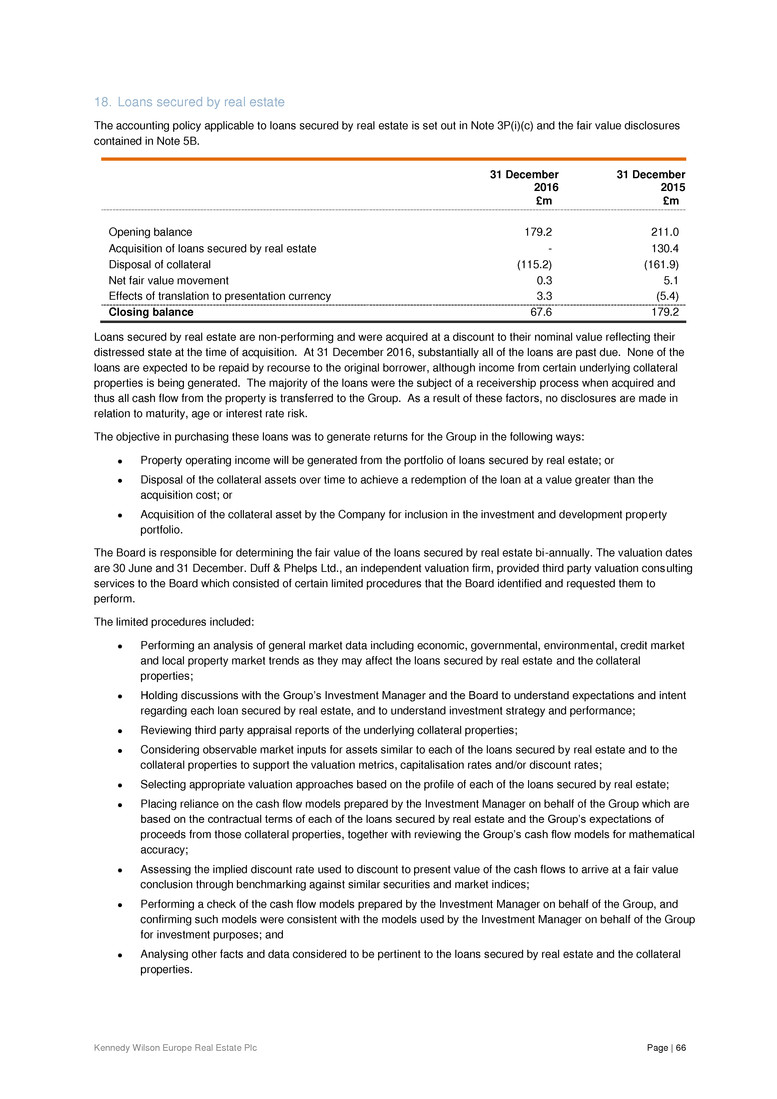
Kennedy Wilson Europe Real Estate Plc Page | 66 18. Loans secured by real estate The accounting policy applicable to loans secured by real estate is set out in Note 3P(i)(c) and the fair value disclosures contained in Note 5B. 31 December 2016 31 December 2015 £m £m Opening balance 179.2 211.0 Acquisition of loans secured by real estate - 130.4 Disposal of collateral (115.2) (161.9) Net fair value movement 0.3 5.1 Effects of translation to presentation currency 3.3 (5.4) Closing balance 67.6 179.2 Loans secured by real estate are non-performing and were acquired at a discount to their nominal value reflecting their distressed state at the time of acquisition. At 31 December 2016, substantially all of the loans are past due. None of the loans are expected to be repaid by recourse to the original borrower, although income from certain underlying collateral properties is being generated. The majority of the loans were the subject of a receivership process when acquired and thus all cash flow from the property is transferred to the Group. As a result of these factors, no disclosures are made in relation to maturity, age or interest rate risk. The objective in purchasing these loans was to generate returns for the Group in the following ways: Property operating income will be generated from the portfolio of loans secured by real estate; or Disposal of the collateral assets over time to achieve a redemption of the loan at a value greater than the acquisition cost; or Acquisition of the collateral asset by the Company for inclusion in the investment and development property portfolio. The Board is responsible for determining the fair value of the loans secured by real estate bi-annually. The valuation dates are 30 June and 31 December. Duff & Phelps Ltd., an independent valuation firm, provided third party valuation consulting services to the Board which consisted of certain limited procedures that the Board identified and requested them to perform. The limited procedures included: Performing an analysis of general market data including economic, governmental, environmental, credit market and local property market trends as they may affect the loans secured by real estate and the collateral properties; Holding discussions with the Group’s Investment Manager and the Board to understand expectations and intent regarding each loan secured by real estate, and to understand investment strategy and performance; Reviewing third party appraisal reports of the underlying collateral properties; Considering observable market inputs for assets similar to each of the loans secured by real estate and to the collateral properties to support the valuation metrics, capitalisation rates and/or discount rates; Selecting appropriate valuation approaches based on the profile of each of the loans secured by real estate; Placing reliance on the cash flow models prepared by the Investment Manager on behalf of the Group which are based on the contractual terms of each of the loans secured by real estate and the Group’s expectations of proceeds from those collateral properties, together with reviewing the Group’s cash flow models for mathematical accuracy; Assessing the implied discount rate used to discount to present value of the cash flows to arrive at a fair value conclusion through benchmarking against similar securities and market indices; Performing a check of the cash flow models prepared by the Investment Manager on behalf of the Group, and confirming such models were consistent with the models used by the Investment Manager on behalf of the Group for investment purposes; and Analysing other facts and data considered to be pertinent to the loans secured by real estate and the collateral properties.
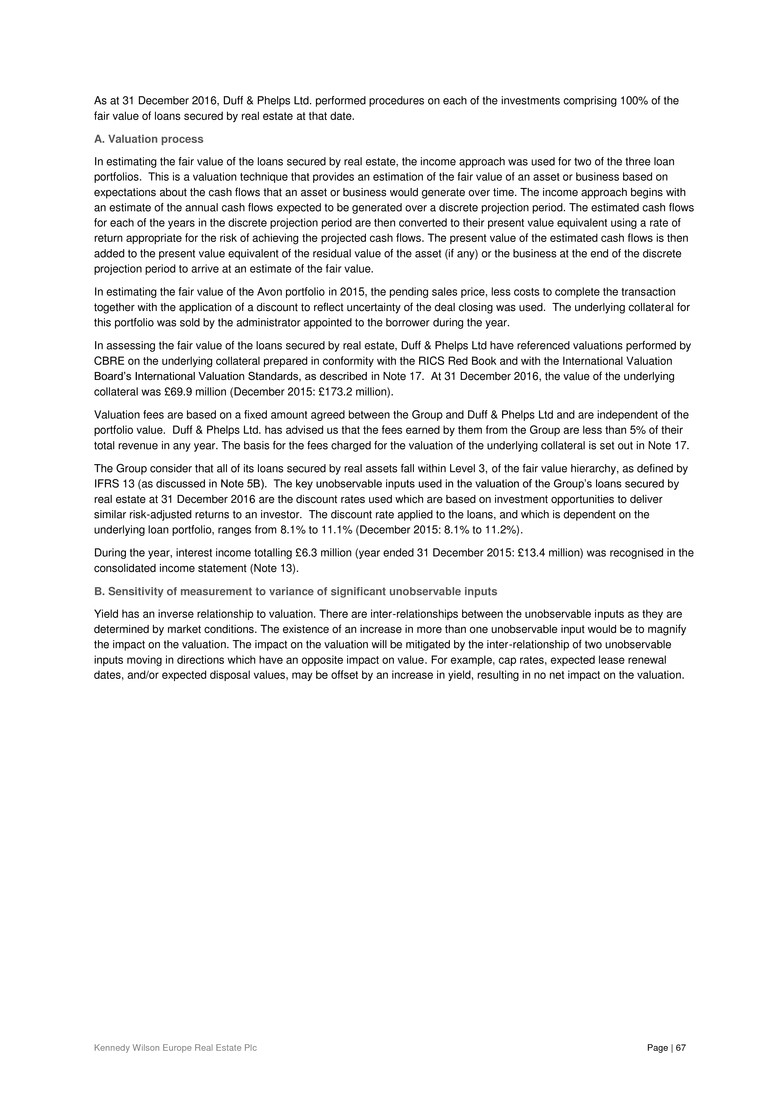
Kennedy Wilson Europe Real Estate Plc Page | 67 As at 31 December 2016, Duff & Phelps Ltd. performed procedures on each of the investments comprising 100% of the fair value of loans secured by real estate at that date. A. Valuation process In estimating the fair value of the loans secured by real estate, the income approach was used for two of the three loan portfolios. This is a valuation technique that provides an estimation of the fair value of an asset or business based on expectations about the cash flows that an asset or business would generate over time. The income approach begins with an estimate of the annual cash flows expected to be generated over a discrete projection period. The estimated cash flows for each of the years in the discrete projection period are then converted to their present value equivalent using a rate of return appropriate for the risk of achieving the projected cash flows. The present value of the estimated cash flows is then added to the present value equivalent of the residual value of the asset (if any) or the business at the end of the discrete projection period to arrive at an estimate of the fair value. In estimating the fair value of the Avon portfolio in 2015, the pending sales price, less costs to complete the transaction together with the application of a discount to reflect uncertainty of the deal closing was used. The underlying collateral for this portfolio was sold by the administrator appointed to the borrower during the year. In assessing the fair value of the loans secured by real estate, Duff & Phelps Ltd have referenced valuations performed by CBRE on the underlying collateral prepared in conformity with the RICS Red Book and with the International Valuation Board’s International Valuation Standards, as described in Note 17. At 31 December 2016, the value of the underlying collateral was £69.9 million (December 2015: £173.2 million). Valuation fees are based on a fixed amount agreed between the Group and Duff & Phelps Ltd and are independent of the portfolio value. Duff & Phelps Ltd. has advised us that the fees earned by them from the Group are less than 5% of their total revenue in any year. The basis for the fees charged for the valuation of the underlying collateral is set out in Note 17. The Group consider that all of its loans secured by real assets fall within Level 3, of the fair value hierarchy, as defined by IFRS 13 (as discussed in Note 5B). The key unobservable inputs used in the valuation of the Group’s loans secured by real estate at 31 December 2016 are the discount rates used which are based on investment opportunities to deliver similar risk-adjusted returns to an investor. The discount rate applied to the loans, and which is dependent on the underlying loan portfolio, ranges from 8.1% to 11.1% (December 2015: 8.1% to 11.2%). During the year, interest income totalling £6.3 million (year ended 31 December 2015: £13.4 million) was recognised in the consolidated income statement (Note 13). B. Sensitivity of measurement to variance of significant unobservable inputs Yield has an inverse relationship to valuation. There are inter-relationships between the unobservable inputs as they are determined by market conditions. The existence of an increase in more than one unobservable input would be to magnify the impact on the valuation. The impact on the valuation will be mitigated by the inter-relationship of two unobservable inputs moving in directions which have an opposite impact on value. For example, cap rates, expected lease renewal dates, and/or expected disposal values, may be offset by an increase in yield, resulting in no net impact on the valuation.

Kennedy Wilson Europe Real Estate Plc Page | 68 I. 31 December 2016 Fair value 31 December 2016 Impact on valuations of 100 bps change in discount rate Increase Decrease £m £m £m United Kingdom 44.4 (0.3) 0.3 Ireland 23.2 (1.1) 1.1 67.6 (1.4) 1.4 II. 31 December 2015 Fair value 31 December 2015 Impact on valuations of 100 bps change in discount rate Increase Decrease £m £m £m United Kingdom 157.3 (0.3) 0.3 Ireland 21.9 (1.0) 1.1 179.2 (1.3) 1.4
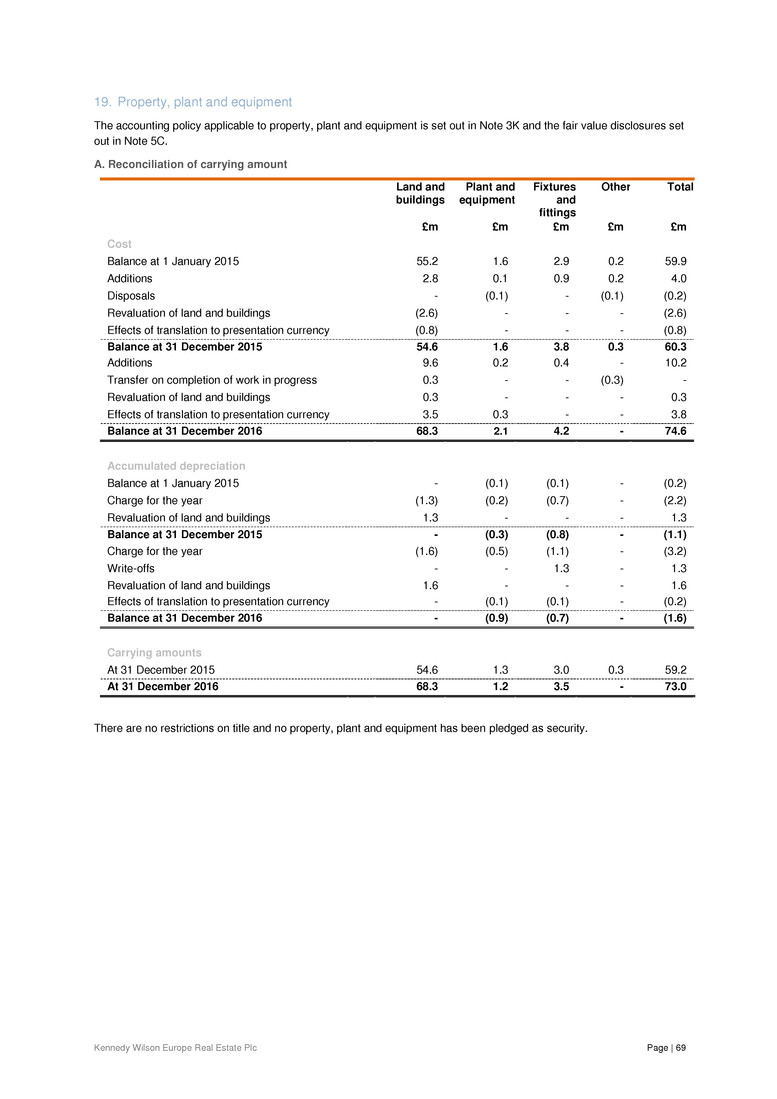
Kennedy Wilson Europe Real Estate Plc Page | 69 19. Property, plant and equipment The accounting policy applicable to property, plant and equipment is set out in Note 3K and the fair value disclosures set out in Note 5C. A. Reconciliation of carrying amount Land and buildings Plant and equipment Fixtures and fittings Other Total £m £m £m £m £m Cost Balance at 1 January 2015 55.2 1.6 2.9 0.2 59.9 Additions 2.8 0.1 0.9 0.2 4.0 Disposals - (0.1) - (0.1) (0.2) Revaluation of land and buildings (2.6) - - - (2.6) Effects of translation to presentation currency (0.8) - - - (0.8) Balance at 31 December 2015 54.6 1.6 3.8 0.3 60.3 Additions 9.6 0.2 0.4 - 10.2 Transfer on completion of work in progress 0.3 - - (0.3) - Revaluation of land and buildings 0.3 - - - 0.3 Effects of translation to presentation currency 3.5 0.3 - - 3.8 Balance at 31 December 2016 68.3 2.1 4.2 - 74.6 Accumulated depreciation Balance at 1 January 2015 - (0.1) (0.1) - (0.2) Charge for the year (1.3) (0.2) (0.7) - (2.2) Revaluation of land and buildings 1.3 - - - 1.3 Balance at 31 December 2015 - (0.3) (0.8) - (1.1) Charge for the year (1.6) (0.5) (1.1) - (3.2) Write-offs - - 1.3 - 1.3 Revaluation of land and buildings 1.6 - - - 1.6 Effects of translation to presentation currency - (0.1) (0.1) - (0.2) Balance at 31 December 2016 - (0.9) (0.7) - (1.6) Carrying amounts At 31 December 2015 54.6 1.3 3.0 0.3 59.2 At 31 December 2016 68.3 1.2 3.5 - 73.0 There are no restrictions on title and no property, plant and equipment has been pledged as security.
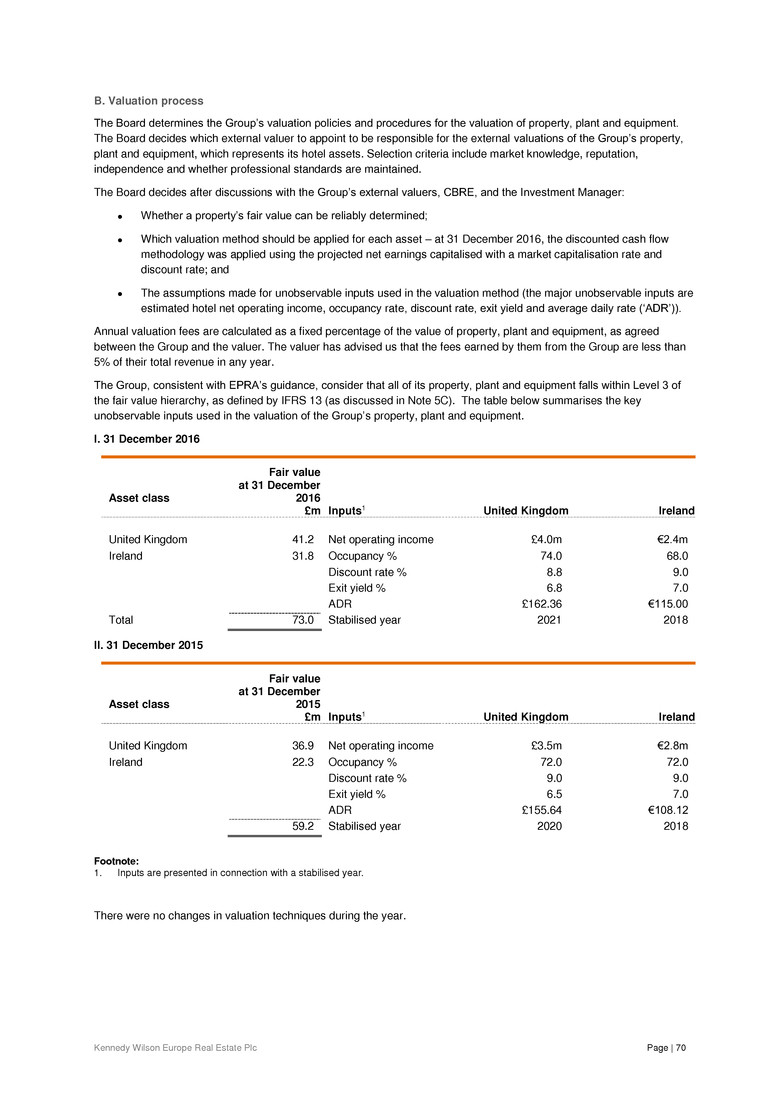
Kennedy Wilson Europe Real Estate Plc Page | 70 B. Valuation process The Board determines the Group’s valuation policies and procedures for the valuation of property, plant and equipment. The Board decides which external valuer to appoint to be responsible for the external valuations of the Group’s property, plant and equipment, which represents its hotel assets. Selection criteria include market knowledge, reputation, independence and whether professional standards are maintained. The Board decides after discussions with the Group’s external valuers, CBRE, and the Investment Manager: Whether a property’s fair value can be reliably determined; Which valuation method should be applied for each asset – at 31 December 2016, the discounted cash flow methodology was applied using the projected net earnings capitalised with a market capitalisation rate and discount rate; and The assumptions made for unobservable inputs used in the valuation method (the major unobservable inputs are estimated hotel net operating income, occupancy rate, discount rate, exit yield and average daily rate (‘ADR’)). Annual valuation fees are calculated as a fixed percentage of the value of property, plant and equipment, as agreed between the Group and the valuer. The valuer has advised us that the fees earned by them from the Group are less than 5% of their total revenue in any year. The Group, consistent with EPRA’s guidance, consider that all of its property, plant and equipment falls within Level 3 of the fair value hierarchy, as defined by IFRS 13 (as discussed in Note 5C). The table below summarises the key unobservable inputs used in the valuation of the Group’s property, plant and equipment. I. 31 December 2016 Asset class Fair value at 31 December 2016 £m Inputs1 United Kingdom Ireland United Kingdom 41.2 Net operating income £4.0m €2.4m Ireland 31.8 Occupancy % 74.0 68.0 Discount rate % 8.8 9.0 Exit yield % 6.8 7.0 ADR £162.36 €115.00 Total 73.0 Stabilised year 2021 2018 II. 31 December 2015 Asset class Fair value at 31 December 2015 £m Inputs1 United Kingdom Ireland United Kingdom 36.9 Net operating income £3.5m €2.8m Ireland 22.3 Occupancy % 72.0 72.0 Discount rate % 9.0 9.0 Exit yield % 6.5 7.0 ADR £155.64 €108.12 59.2 Stabilised year 2020 2018 Footnote: 1. Inputs are presented in connection with a stabilised year. There were no changes in valuation techniques during the year.

Kennedy Wilson Europe Real Estate Plc Page | 71 C. Sensitivity of measurement to variance of significant unobservable inputs There are inter-relationships between all these unobservable inputs as they are determined by market conditions. The existence of an increase in more than one unobservable input would be to magnify the impact on the valuation. The impact on the valuation will be mitigated by the inter-relationship of two unobservable inputs moving in directions which have an opposite impact on value. For example, an increase in hotel net operating income may be offset by an increase in exit yield, resulting in no net impact on the valuation. However, if the inputs move in opposite directions (for example ADR increases and exit yield decreases), valuation movements can be amplified whereas if they move in the same direction, they may offset reducing the overall net valuation movement. I. 31 December 2016 Fair value at 31 December 2016 Impact on valuations of a 10% change in estimated Hotel NOI Impact on valuations of 10% change in occupancy % Impact on valuations of 100 bps change in discount rate Impact on valuations of a 50 bps change in exit yield Impact of a 5% change in ADR Increase Decrease Increase Decrease Increase Decrease Increase Decrease Increase Decrease £m £m £m £m £m £m £m £m £m £m £m United Kingdom 41.2 4.1 (4.1) 11.5 (11.5) (5.6) 7.6 (3.0) 3.5 9.9 (9.8) Ireland 31.8 3.3 (3.3) 6.2 (6.2) (4.2) 5.6 (2.2) 2.6 1.4 (1.4) 73.0 7.4 (7.4) 17.7 (17.7) (9.8) 13.2 (5.2) 6.1 11.3 (11.2) II. 31 December 2015 Fair value at 31 December 2015 Impact on valuations of a 10% change in estimated Hotel NOI Impact on valuations of 10% change in occupancy % Impact on valuations of 100 bps change in discount rate Impact on valuations of a 50 bps change in exit yield Impact of a 5% change in ADR Increase Decrease Increase Decrease Increase Decrease Increase Decrease Increase Decrease £m £m £m £m £m £m £m £m £m £m £m United Kingdom 36.9 3.6 (3.6) 11.7 (11.7) (5.9) 8.1 (3.2) 3.7 10.0 (10.0) Ireland 22.3 2.7 (2.7) 8.6 (8.6) (3.3) 4.4 (1.8) 2.0 1.8 (1.8) 59.2 6.3 (6.3) 20.3 (20.3) (9.2) 12.5 (5.0) 5.7 11.8 (11.8) 20. Inventories The accounting policy applicable to inventories is set out in Note 3M. 31 December 2016 31 December 2015 £m £m Current Consumable stores 0.3 0.3 0.3 0.3 Inventories of £2.4 million (December 2015: £2.4 million) were expensed during the year (Note 11). The carrying value of inventories approximates their fair value.

Kennedy Wilson Europe Real Estate Plc Page | 72 21. Rent and other receivables The accounting policy applicable to rent and other receivables is set out in Note 3P(i)(b). 31 December 2016 31 December 2015 £m £m Current Rent and trade receivables 13.8 9.0 Prepayments and other receivables 9.7 6.6 Straight line rent 6.9 3.1 VAT receivable 2.1 7.4 Deposits paid - 1.7 Prepaid borrowing costs on undrawn facility - 0.6 32.5 28.4 The Group’s exposure to credit risks and impairment losses related to rent and other receivables is disclosed in Note 27C(iii). A. Deposits paid At 31 December 2016 deposits totalling £Nil (31 December 2015: £1.7 million) were paid on executing the purchase agreements for a number of acquisitions. B. Rent and trade receivables The Group does not typically extend credit terms to its investment property tenants, instead requiring them to pay in advance. Consequently, the Group is not exposed to a significant credit risk. Rent for investment property falls due on contractual quarter days. Rent and service charge receivables are non-interest bearing and are typically due within 30 days. Rent on tenanted residential property falls due monthly and is also payable in advance. The Group’s exposure to credit risk in its hotel operations is influenced mainly by the individual characteristics of each customer. There is no concentration of credit risk or dependence on individual customers. Management of the hotels has a credit policy in place and the exposure to credit risk is monitored on an ongoing basis. At 31 December 2016 the maximum exposure to credit risk for rent and trade receivables was £14.5 million (December 2015: £9.2 million).
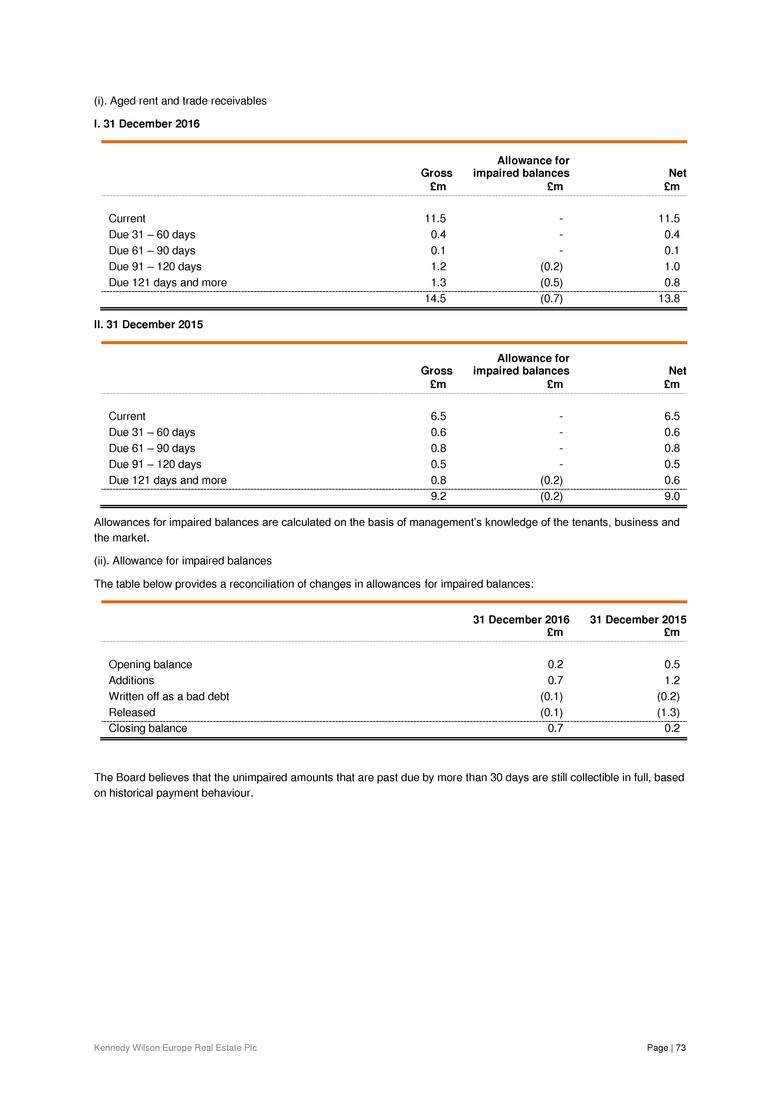
Kennedy Wilson Europe Real Estate Plc Page | 73 (i). Aged rent and trade receivables I. 31 December 2016 Gross Allowance for impaired balances Net £m £m £m Current 11.5 - 11.5 Due 31 – 60 days 0.4 - 0.4 Due 61 – 90 days 0.1 - 0.1 Due 91 – 120 days 1.2 (0.2) 1.0 Due 121 days and more 1.3 (0.5) 0.8 14.5 (0.7) 13.8 II. 31 December 2015 Gross Allowance for impaired balances Net £m £m £m Current 6.5 - 6.5 Due 31 – 60 days 0.6 - 0.6 Due 61 – 90 days 0.8 - 0.8 Due 91 – 120 days 0.5 - 0.5 Due 121 days and more 0.8 (0.2) 0.6 9.2 (0.2) 9.0 Allowances for impaired balances are calculated on the basis of management’s knowledge of the tenants, business and the market. (ii). Allowance for impaired balances The table below provides a reconciliation of changes in allowances for impaired balances: 31 December 2016 31 December 2015 £m £m Opening balance 0.2 0.5 Additions 0.7 1.2 Written off as a bad debt (0.1) (0.2) Released (0.1) (1.3) Closing balance 0.7 0.2 The Board believes that the unimpaired amounts that are past due by more than 30 days are still collectible in full, based on historical payment behaviour.
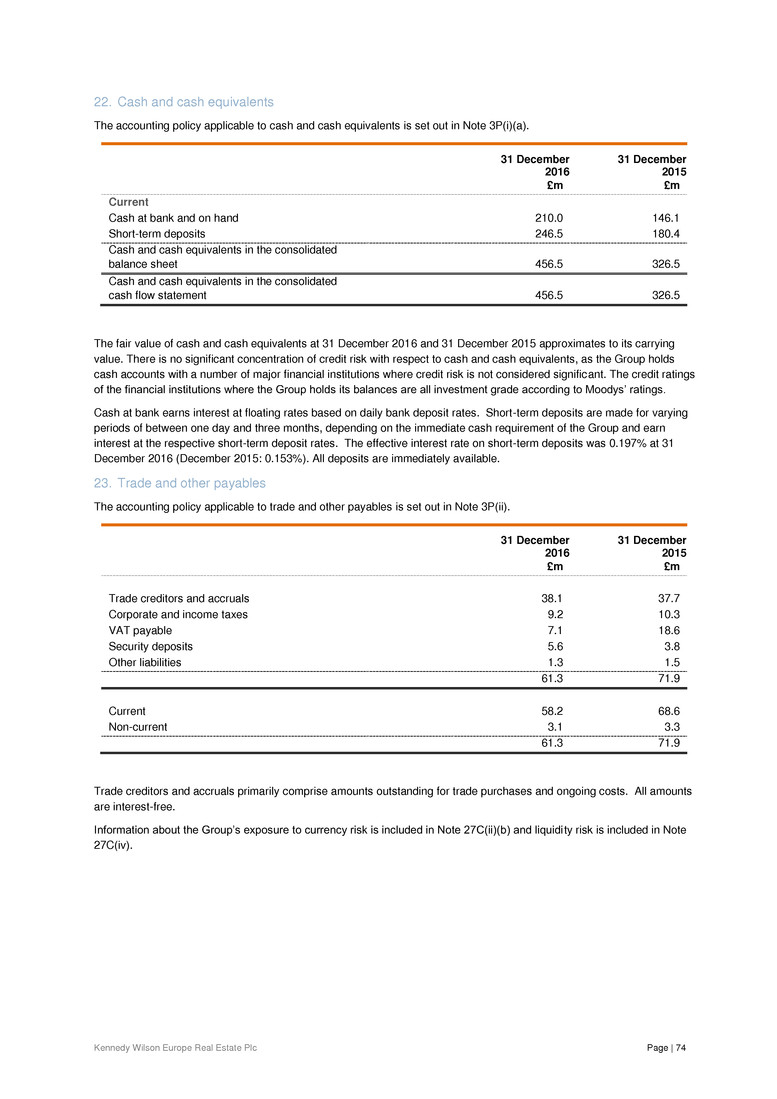
Kennedy Wilson Europe Real Estate Plc Page | 74 22. Cash and cash equivalents The accounting policy applicable to cash and cash equivalents is set out in Note 3P(i)(a). 31 December 2016 31 December 2015 £m £m Current Cash at bank and on hand 210.0 146.1 Short-term deposits 246.5 180.4 Cash and cash equivalents in the consolidated balance sheet 456.5 326.5 Cash and cash equivalents in the consolidated cash flow statement 456.5 326.5 The fair value of cash and cash equivalents at 31 December 2016 and 31 December 2015 approximates to its carrying value. There is no significant concentration of credit risk with respect to cash and cash equivalents, as the Group holds cash accounts with a number of major financial institutions where credit risk is not considered significant. The credit ratings of the financial institutions where the Group holds its balances are all investment grade according to Moodys’ ratings. Cash at bank earns interest at floating rates based on daily bank deposit rates. Short-term deposits are made for varying periods of between one day and three months, depending on the immediate cash requirement of the Group and earn interest at the respective short-term deposit rates. The effective interest rate on short-term deposits was 0.197% at 31 December 2016 (December 2015: 0.153%). All deposits are immediately available. 23. Trade and other payables The accounting policy applicable to trade and other payables is set out in Note 3P(ii). 31 December 2016 31 December 2015 £m £m Trade creditors and accruals 38.1 37.7 Corporate and income taxes 9.2 10.3 VAT payable 7.1 18.6 Security deposits 5.6 3.8 Other liabilities 1.3 1.5 61.3 71.9 Current 58.2 68.6 Non-current 3.1 3.3 61.3 71.9 Trade creditors and accruals primarily comprise amounts outstanding for trade purchases and ongoing costs. All amounts are interest-free. Information about the Group’s exposure to currency risk is included in Note 27C(ii)(b) and liquidity risk is included in Note 27C(iv).
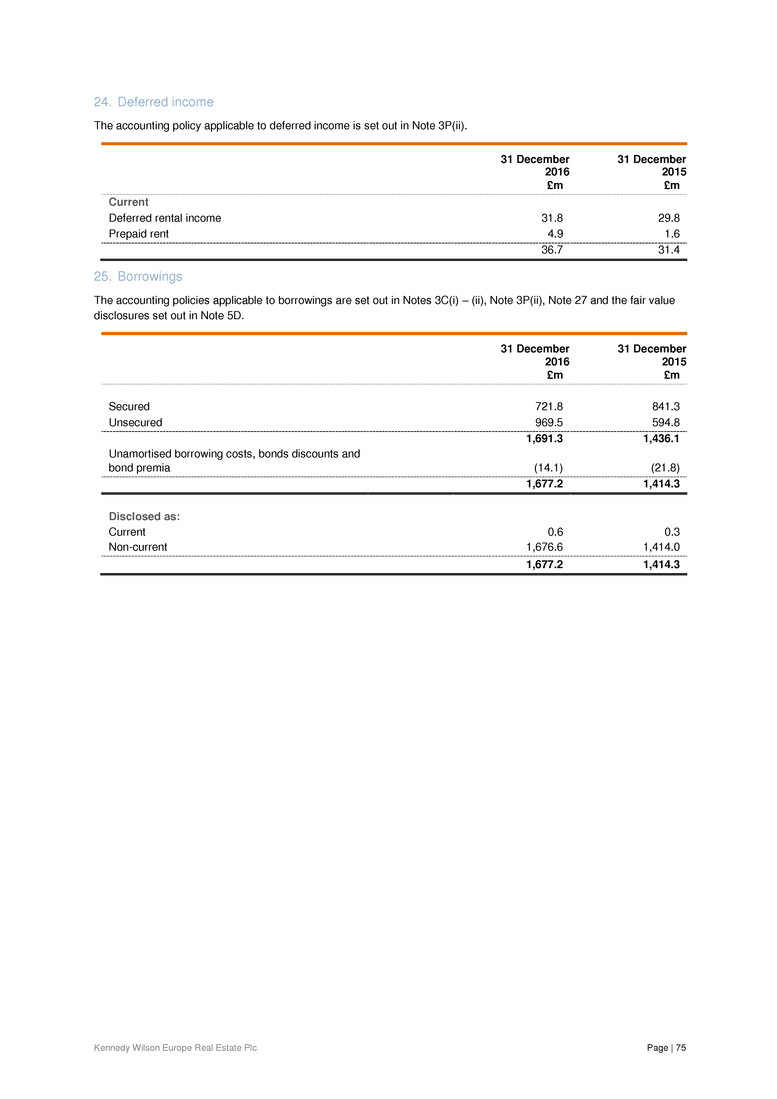
Kennedy Wilson Europe Real Estate Plc Page | 75 24. Deferred income The accounting policy applicable to deferred income is set out in Note 3P(ii). 31 December 2016 31 December 2015 £m £m Current Deferred rental income 31.8 29.8 Prepaid rent 4.9 1.6 36.7 31.4 25. Borrowings The accounting policies applicable to borrowings are set out in Notes 3C(i) – (ii), Note 3P(ii), Note 27 and the fair value disclosures set out in Note 5D. 31 December 2016 31 December 2015 £m £m Secured 721.8 841.3 Unsecured 969.5 594.8 1,691.3 1,436.1 Unamortised borrowing costs, bonds discounts and bond premia (14.1) (21.8) 1,677.2 1,414.3 Disclosed as: Current 0.6 0.3 Non-current 1,676.6 1,414.0 1,677.2 1,414.3
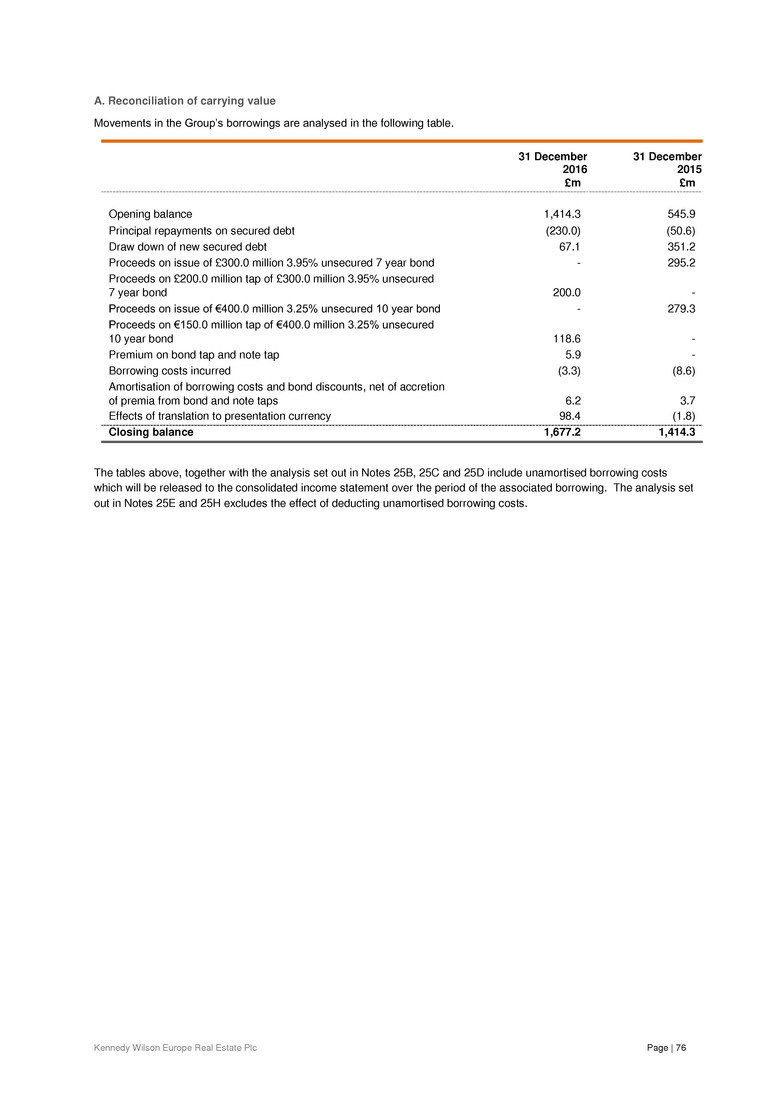
Kennedy Wilson Europe Real Estate Plc Page | 76 A. Reconciliation of carrying value Movements in the Group’s borrowings are analysed in the following table. 31 December 2016 31 December 2015 £m £m Opening balance 1,414.3 545.9 Principal repayments on secured debt (230.0) (50.6) Draw down of new secured debt 67.1 351.2 Proceeds on issue of £300.0 million 3.95% unsecured 7 year bond - 295.2 Proceeds on £200.0 million tap of £300.0 million 3.95% unsecured 7 year bond 200.0 - Proceeds on issue of €400.0 million 3.25% unsecured 10 year bond - 279.3 Proceeds on €150.0 million tap of €400.0 million 3.25% unsecured 10 year bond 118.6 - Premium on bond tap and note tap 5.9 - Borrowing costs incurred (3.3) (8.6) Amortisation of borrowing costs and bond discounts, net of accretion of premia from bond and note taps 6.2 3.7 Effects of translation to presentation currency 98.4 (1.8) Closing balance 1,677.2 1,414.3 The tables above, together with the analysis set out in Notes 25B, 25C and 25D include unamortised borrowing costs which will be released to the consolidated income statement over the period of the associated borrowing. The analysis set out in Notes 25E and 25H excludes the effect of deducting unamortised borrowing costs.

Kennedy Wilson Europe Real Estate Plc Page | 77 B. Secured borrowings I. 31 December 2016 Draw down date1 Effective interest rate Maturity Fair value2 Book value2 % £m £m £184.0 million mortgage borrowing 24 September 2014 Libor + 1.80% December 2019 164.9 167.3 €264.0 million mortgage borrowing 17 December 2014 Euribor + 2.125% December 20193 205.7 205.4 £116.6 million mortgage borrowing 31 January 2015 Libor + 2.50% 30 January 2018 45.7 45.6 £70.7 million mortgage borrowing 31 January 2015 2.90% 30 January 2020 72.4 70.4 £165.0 million mortgage borrowing 31 January 2015 2.91% 30 January 2023 167.4 161.0 €37.25 million mortgage borrowing4 22 January 2016 Euribor + 1.60% 29 December 2030 31.6 30.6 €50.0 million mortgage borrowing4 1 March 2016 Euribor + 1.60% 1 March 2031 37.0 36.0 724.7 716.3 Unamortised borrowing costs (included above) 5.5 721.8 Footnotes: 1. Draw down date or date of acquisition, whichever is later. 2. The fair value of floating rate borrowings have been established using an equivalent market value established by the Investment Manager determining the equivalent credit spread for this debt at the balance sheet date. The fair value of fixed rate borrowings have been calculated using a discounted cash flow approach. 3. This facility contains two options to extend the maturity date by one year each upon satisfaction of the conditions per the facility agreement and payment of a 0.2% extension fee. 4. Amortising loan.
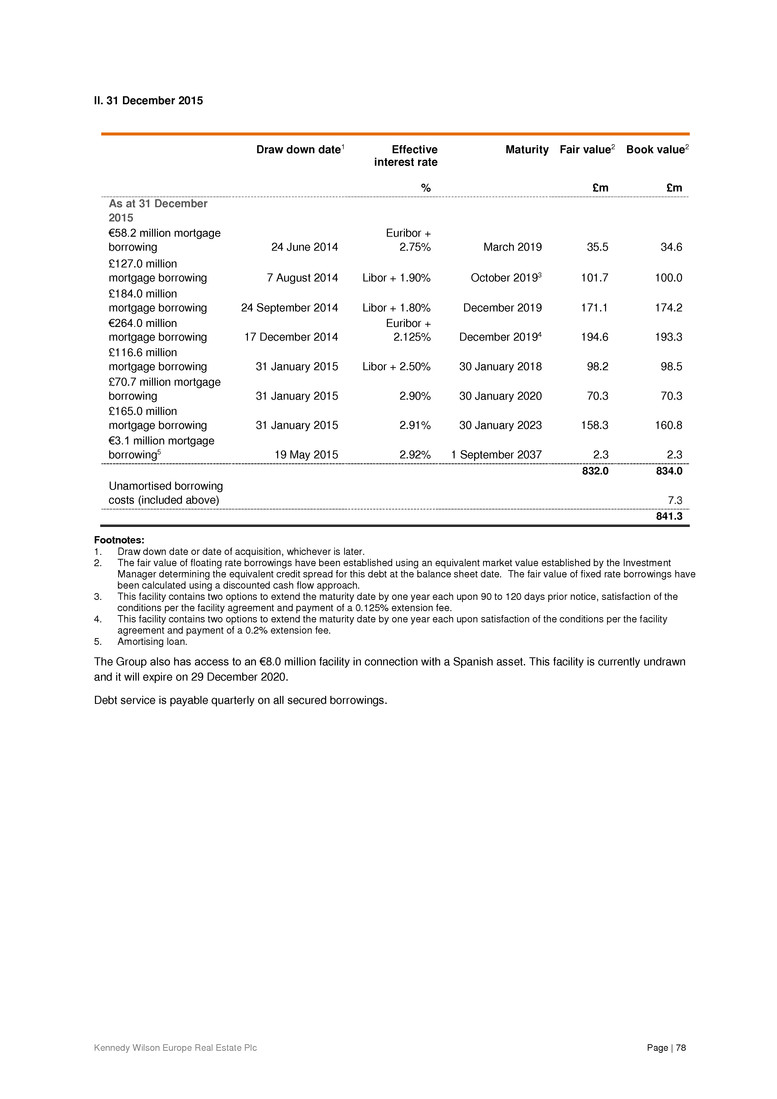
Kennedy Wilson Europe Real Estate Plc Page | 78 II. 31 December 2015 Draw down date1 Effective interest rate Maturity Fair value2 Book value2 % £m £m As at 31 December 2015 €58.2 million mortgage borrowing 24 June 2014 Euribor + 2.75% March 2019 35.5 34.6 £127.0 million mortgage borrowing 7 August 2014 Libor + 1.90% October 20193 101.7 100.0 £184.0 million mortgage borrowing 24 September 2014 Libor + 1.80% December 2019 171.1 174.2 €264.0 million mortgage borrowing 17 December 2014 Euribor + 2.125% December 20194 194.6 193.3 £116.6 million mortgage borrowing 31 January 2015 Libor + 2.50% 30 January 2018 98.2 98.5 £70.7 million mortgage borrowing 31 January 2015 2.90% 30 January 2020 70.3 70.3 £165.0 million mortgage borrowing 31 January 2015 2.91% 30 January 2023 158.3 160.8 €3.1 million mortgage borrowing5 19 May 2015 2.92% 1 September 2037 2.3 2.3 832.0 834.0 Unamortised borrowing costs (included above) 7.3 841.3 Footnotes: 1. Draw down date or date of acquisition, whichever is later. 2. The fair value of floating rate borrowings have been established using an equivalent market value established by the Investment Manager determining the equivalent credit spread for this debt at the balance sheet date. The fair value of fixed rate borrowings have been calculated using a discounted cash flow approach. 3. This facility contains two options to extend the maturity date by one year each upon 90 to 120 days prior notice, satisfaction of the conditions per the facility agreement and payment of a 0.125% extension fee. 4. This facility contains two options to extend the maturity date by one year each upon satisfaction of the conditions per the facility agreement and payment of a 0.2% extension fee. 5. Amortising loan. The Group also has access to an €8.0 million facility in connection with a Spanish asset. This facility is currently undrawn and it will expire on 29 December 2020. Debt service is payable quarterly on all secured borrowings.

Kennedy Wilson Europe Real Estate Plc Page | 79 C. Bonds and notes I. 31 December 2016 Issue date Effective interest rate Maturity Fair value1 Book value1 % £m £m £500.0 million 3.95%, 7 year unsecured bond 30 June 2015 3.95% 30 June 2022 509.4 497.3 €550.0 million 3.25%, 10 year unsecured note 12 November 2015 3.25% 12 November 2025 478.7 464.1 988.1 961.4 Unamortised borrowing costs, discounts and premia 8.1 969.5 II. 31 December 2015 Issue date Effective interest rate Maturity Fair value1 Book value1 % £m £m £300.0 million 3.95%, 7 year unsecured bond 30 June 2015 3.95% 30 June 2022 295.1 293.5 €400.0 million 3.25%, 10 year unsecured note 12 November 2015 3.25% 12 November 2025 294.3 287.9 589.4 581.4 Unamortised borrowing costs and discounts 13.4 594.8 Footnote: 1. The fair value of each of the unsecured bonds and notes has been calculated using the quoted market price as at 31 December 2015. (i). £500.0 million 3.95% senior unsecured bond due 2022 (a). Bond tap On 19 September 2016, the Company completed a tap of this bond for an aggregate principal amount of £200.0 million. This bond tap will be aggregated with the £300.0 million bond and together they will form a single series. The tap was issued at a yield of 3.572% and will mature on 30 June 2022. They were rated BBB (outlook stable) by Standard & Poor’s. (ii). Multi-currency Euro Medium Term Note Programme (‘EMTN Programme’) On 5 November 2015 the Group announced the establishment of a £2.0 billion EMTN Programme. Under the EMTN Programme, the Group may issue, from time to time, up to £2.0 billion of various types of debt securities in certain markets and currencies. The EMTN Programme was assigned a rating of BBB by Standard & Poor’s. (a). Note tap On 19 April 2016, the Company completed a tap of this note for an aggregate principal amount of €150.0 million. This note tap will be aggregated with the €400.0 million bond and together they will form a single series. The tap was issued at a yield of 3.039% and will mature on 12 November 2025. They were rated BBB (outlook stable) by Standard & Poor’s. Interest on the unsecured standalone bonds is payable annually on the anniversary of draw down.

Kennedy Wilson Europe Real Estate Plc Page | 80 D. Revolving credit facility I. 31 December 2016 Draw down date Effective interest rate Maturity Fair value Book value % £m £m £225.0 million revolving credit facility 29 August 2014 n/a 29 August 2017 (0.5) (0.5) (0.5) (0.5) II. 31 December 2015 Draw down date Effective interest rate Maturity Fair value Book value % £m £m £225.0 million revolving credit facility 29 August 2014 n/a 29 August 2017 (1.2) (1.2) (1.2) (1.2) The £225.0 million RCF is unsecured and attracts a floating rate interest. Any portion of the RCF utilised in Euro will bear interest at a rate of Euribor plus a margin which ratchets between 160 bps and 260 bps depending on the Group LTV, whilst any portion of the RCF which is utilised in Pound Sterling will bear interest at a rate of Libor plus a margin which ratchets between 160 bps and 260 bps depending on the Group LTV. At 31 December 2016 and 31 December 2015, and as at the date of the consolidated financial statements, the RCF was undrawn. The Group incurs non-utilisation fees on the undrawn portion of the RCF. At 31 December 2016 the weighted average charge on the undrawn facilities was 55 bps (December 2015: 55 bps). E. Maturity profile of borrowings The maturity profile of the Group’s borrowings is as follows: 31 December 2016 31 December 2015 £m £m Due within one year 0.6 0.3 Due between two and five years 498.2 677.3 Due between six and ten years 1,158.8 757.1 Due greater than ten years 33.7 1.4 Closing balance 1,691.3 1,436.1 F. Collateral The borrowings set out in Note 25B are secured by fixed charges over certain investment and development property assets. The fair value of investment and development property over which security has been granted is £1,250.1 million (December 2015: £1,567.8 million). The RCF and the Group’s bonds are unsecured.
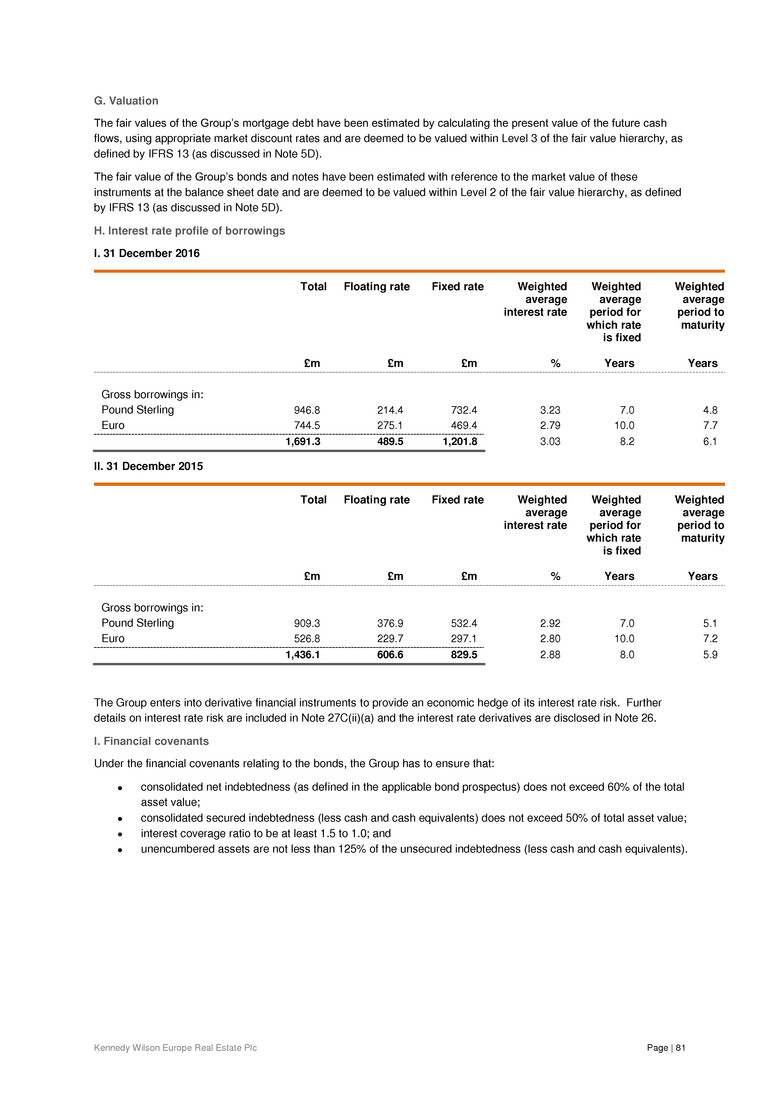
Kennedy Wilson Europe Real Estate Plc Page | 81 G. Valuation The fair values of the Group’s mortgage debt have been estimated by calculating the present value of the future cash flows, using appropriate market discount rates and are deemed to be valued within Level 3 of the fair value hierarchy, as defined by IFRS 13 (as discussed in Note 5D). The fair value of the Group’s bonds and notes have been estimated with reference to the market value of these instruments at the balance sheet date and are deemed to be valued within Level 2 of the fair value hierarchy, as defined by IFRS 13 (as discussed in Note 5D). H. Interest rate profile of borrowings I. 31 December 2016 Total Floating rate Fixed rate Weighted average interest rate Weighted average period for which rate is fixed Weighted average period to maturity £m £m £m % Years Years Gross borrowings in: Pound Sterling 946.8 214.4 732.4 3.23 7.0 4.8 Euro 744.5 275.1 469.4 2.79 10.0 7.7 1,691.3 489.5 1,201.8 3.03 8.2 6.1 II. 31 December 2015 Total Floating rate Fixed rate Weighted average interest rate Weighted average period for which rate is fixed Weighted average period to maturity £m £m £m % Years Years Gross borrowings in: Pound Sterling 909.3 376.9 532.4 2.92 7.0 5.1 Euro 526.8 229.7 297.1 2.80 10.0 7.2 1,436.1 606.6 829.5 2.88 8.0 5.9 The Group enters into derivative financial instruments to provide an economic hedge of its interest rate risk. Further details on interest rate risk are included in Note 27C(ii)(a) and the interest rate derivatives are disclosed in Note 26. I. Financial covenants Under the financial covenants relating to the bonds, the Group has to ensure that: consolidated net indebtedness (as defined in the applicable bond prospectus) does not exceed 60% of the total asset value; consolidated secured indebtedness (less cash and cash equivalents) does not exceed 50% of total asset value; interest coverage ratio to be at least 1.5 to 1.0; and unencumbered assets are not less than 125% of the unsecured indebtedness (less cash and cash equivalents).

Kennedy Wilson Europe Real Estate Plc Page | 82 Under the financial covenants relating to the RCF, the Group has to ensure that: consolidated net indebtedness (as defined in the revolving loan agreement) does not exceed 60% of the total asset value; a minimum fixed charge coverage ratio where consolidated earnings before interest, tax, depreciation and amortisation to consolidated fixed charges is not less than 1.9 to 1.0 for the last four quarters; a maximum secured recourse indebtedness for consolidated secured recourse debt does not exceed 2.5% of total asset value at any time; and unencumbered assets are not less than 125% of the unsecured indebtedness (less cash and cash equivalents). The secured borrowings are subject to various financial covenants including LTV and debt service coverage ratios, all of which were met throughout the year.
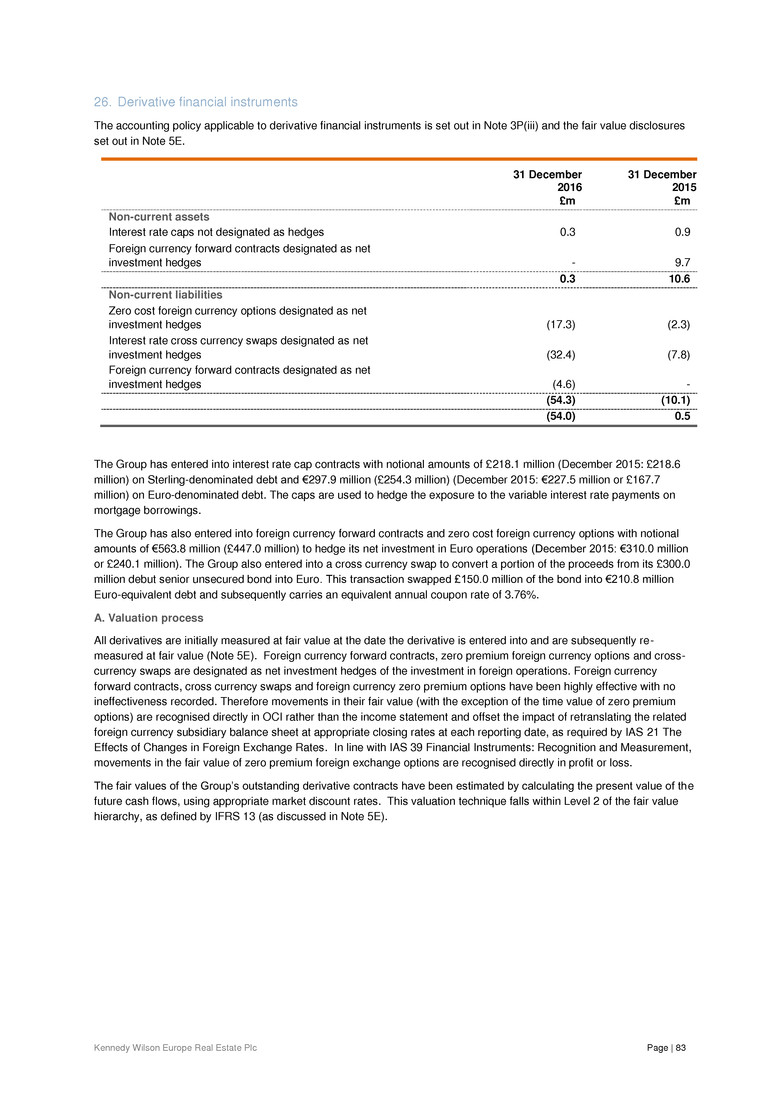
Kennedy Wilson Europe Real Estate Plc Page | 83 26. Derivative financial instruments The accounting policy applicable to derivative financial instruments is set out in Note 3P(iii) and the fair value disclosures set out in Note 5E. 31 December 2016 31 December 2015 £m £m Non-current assets Interest rate caps not designated as hedges 0.3 0.9 Foreign currency forward contracts designated as net investment hedges - 9.7 0.3 10.6 Non-current liabilities Zero cost foreign currency options designated as net investment hedges (17.3) (2.3) Interest rate cross currency swaps designated as net investment hedges (32.4) (7.8) Foreign currency forward contracts designated as net investment hedges (4.6) - (54.3) (10.1) (54.0) 0.5 The Group has entered into interest rate cap contracts with notional amounts of £218.1 million (December 2015: £218.6 million) on Sterling-denominated debt and €297.9 million (£254.3 million) (December 2015: €227.5 million or £167.7 million) on Euro-denominated debt. The caps are used to hedge the exposure to the variable interest rate payments on mortgage borrowings. The Group has also entered into foreign currency forward contracts and zero cost foreign currency options with notional amounts of €563.8 million (£447.0 million) to hedge its net investment in Euro operations (December 2015: €310.0 million or £240.1 million). The Group also entered into a cross currency swap to convert a portion of the proceeds from its £300.0 million debut senior unsecured bond into Euro. This transaction swapped £150.0 million of the bond into €210.8 million Euro-equivalent debt and subsequently carries an equivalent annual coupon rate of 3.76%. A. Valuation process All derivatives are initially measured at fair value at the date the derivative is entered into and are subsequently re- measured at fair value (Note 5E). Foreign currency forward contracts, zero premium foreign currency options and cross- currency swaps are designated as net investment hedges of the investment in foreign operations. Foreign currency forward contracts, cross currency swaps and foreign currency zero premium options have been highly effective with no ineffectiveness recorded. Therefore movements in their fair value (with the exception of the time value of zero premium options) are recognised directly in OCI rather than the income statement and offset the impact of retranslating the related foreign currency subsidiary balance sheet at appropriate closing rates at each reporting date, as required by IAS 21 The Effects of Changes in Foreign Exchange Rates. In line with IAS 39 Financial Instruments: Recognition and Measurement, movements in the fair value of zero premium foreign exchange options are recognised directly in profit or loss. The fair values of the Group’s outstanding derivative contracts have been estimated by calculating the present value of the future cash flows, using appropriate market discount rates. This valuation technique falls within Level 2 of the fair value hierarchy, as defined by IFRS 13 (as discussed in Note 5E).

Kennedy Wilson Europe Real Estate Plc Page | 84 27. Financial instruments - fair value and risk management The accounting policy applicable to financial instruments is set out in Note 3P and the fair value disclosures set out in Note 5. A. Accounting classifications and fair values The following table shows the book values and fair values of financial assets and financial liabilities, including their levels in the fair value hierarchy. It does not include fair value information for financial assets and financial liabilities not measured at fair value if the carrying amount is a reasonable approximation of fair value. I. 31 December 2016 Carrying value Fair value Fair value through the profit and loss Fair value hedging instruments Other financial liabilities Level 1 Level 2 Level 3 £m £m £m £m £m £m £m £m Loans secured by real estate 67.6 67.6 67.6 - - - - 67.6 Derivative financial assets 0.3 0.3 0.3 - - - 0.3 - Total financial assets disclosed at fair value 67.9 67.9 67.9 - - - 0.3 67.6 Borrowings 1,677.2 1,712.8 - - 1,712.8 - 988.1 724.7 Derivative financial liabilities 54.3 54.3 - 54.3 - - 54.3 - Total financial liabilities disclosed at fair value 1,731.5 1,767.1 - 54.3 1,712.8 - 1,042.4 724.7

Kennedy Wilson Europe Real Estate Plc Page | 85 II. 31 December 2015 Carrying value Fair value Fair value through the profit and loss Fair value hedging instruments Other financial liabilities Level 1 Level 2 Level 3 £m £m £m £m £m £m £m £m Loans secured by real estate 179.2 179.2 179.2 - - - - 179.2 Derivative financial assets 10.6 10.6 0.9 9.7 - - 10.6 - Total financial assets disclosed at fair value 189.8 189.8 180.1 9.7 - - 10.6 179.2 Borrowings 1,414.3 1421.4 - - 1,421.4 - 589.4 832.0 Derivative financial liabilities 10.1 10.1 - 10.1 - - 10.1 - Total financial liabilities disclosed at fair value 1,424.4 1,431.5 - 10.1 1,421.4 - 599.5 832.0
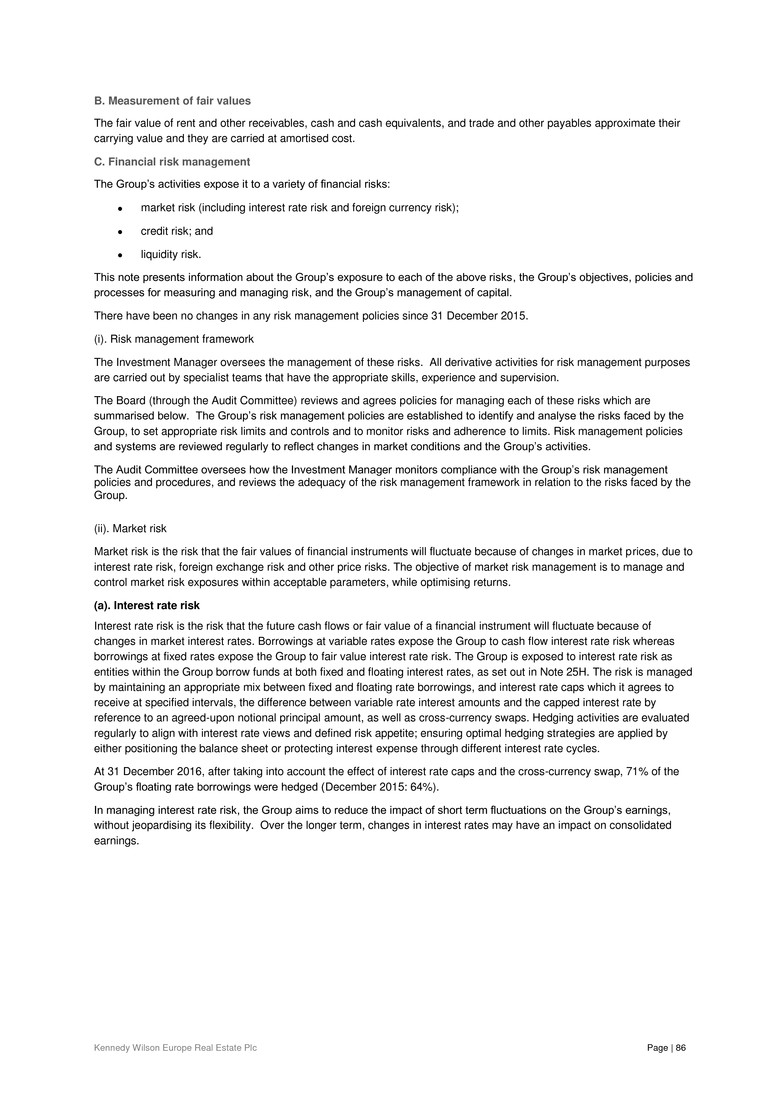
Kennedy Wilson Europe Real Estate Plc Page | 86 B. Measurement of fair values The fair value of rent and other receivables, cash and cash equivalents, and trade and other payables approximate their carrying value and they are carried at amortised cost. C. Financial risk management The Group’s activities expose it to a variety of financial risks: market risk (including interest rate risk and foreign currency risk); credit risk; and liquidity risk. This note presents information about the Group’s exposure to each of the above risks, the Group’s objectives, policies and processes for measuring and managing risk, and the Group’s management of capital. There have been no changes in any risk management policies since 31 December 2015. (i). Risk management framework The Investment Manager oversees the management of these risks. All derivative activities for risk management purposes are carried out by specialist teams that have the appropriate skills, experience and supervision. The Board (through the Audit Committee) reviews and agrees policies for managing each of these risks which are summarised below. The Group’s risk management policies are established to identify and analyse the risks faced by the Group, to set appropriate risk limits and controls and to monitor risks and adherence to limits. Risk management policies and systems are reviewed regularly to reflect changes in market conditions and the Group’s activities. The Audit Committee oversees how the Investment Manager monitors compliance with the Group’s risk management policies and procedures, and reviews the adequacy of the risk management framework in relation to the risks faced by the Group. (ii). Market risk Market risk is the risk that the fair values of financial instruments will fluctuate because of changes in market prices, due to interest rate risk, foreign exchange risk and other price risks. The objective of market risk management is to manage and control market risk exposures within acceptable parameters, while optimising returns. (a). Interest rate risk Interest rate risk is the risk that the future cash flows or fair value of a financial instrument will fluctuate because of changes in market interest rates. Borrowings at variable rates expose the Group to cash flow interest rate risk whereas borrowings at fixed rates expose the Group to fair value interest rate risk. The Group is exposed to interest rate risk as entities within the Group borrow funds at both fixed and floating interest rates, as set out in Note 25H. The risk is managed by maintaining an appropriate mix between fixed and floating rate borrowings, and interest rate caps which it agrees to receive at specified intervals, the difference between variable rate interest amounts and the capped interest rate by reference to an agreed-upon notional principal amount, as well as cross-currency swaps. Hedging activities are evaluated regularly to align with interest rate views and defined risk appetite; ensuring optimal hedging strategies are applied by either positioning the balance sheet or protecting interest expense through different interest rate cycles. At 31 December 2016, after taking into account the effect of interest rate caps and the cross-currency swap, 71% of the Group’s floating rate borrowings were hedged (December 2015: 64%). In managing interest rate risk, the Group aims to reduce the impact of short term fluctuations on the Group’s earnings, without jeopardising its flexibility. Over the longer term, changes in interest rates may have an impact on consolidated earnings.

Kennedy Wilson Europe Real Estate Plc Page | 87 The sensitivity analysis below has been determined based on the exposure to interest rates for both non-derivative and derivative financial instruments at the balance sheet date and represents management’s assessment of possible changes in interest rates. For the floating rate liabilities, the analysis has been prepared assuming that the amount of the liability at each of 31 December 2016 and 31 December 2015 were outstanding for an entire year. The sensitivity has been calculated by applying the interest rate change to the variable rate borrowings, net of interest-rate caps and cash and cash equivalents. Impact on profit Impact on net asset value 31 December 2016 31 December 2015 31 December 2016 31 December 2015 £m £m £m £m Increase of 100 bps (1.5) (3.7) (1.5) (3.7) Decrease of 100 bps 0.3 1.9 0.3 1.9 Increase of 200 bps (3.8) (7.1) (3.8) (7.1) Decrease of 200 bps 0.3 1.9 0.3 1.9 The Group is also exposed to interest rate risk on its cash and cash equivalents. These balances attract low interest rates and therefore a relative increase or decrease in their respective interest rates would not have a material impact on profit or loss. (b). Foreign currency risk The Group has operations in Europe which transact business denominated mostly in Euro. There is currency exposure caused by translating the local trading performance and local net assets into Pound Sterling for each financial period and at each reporting date. The Group does not have foreign currency trading with cross border flows. The Group hedges a majority of its foreign currency assets naturally by funding them with borrowings in Euro and aims to ensure that it has no material unhedged net assets or liabilities denominated in a foreign currency. Profit translation is not hedged. There are no other significant foreign currency risks impacting the Group. The Group’s net investment translation exposure (including the impact of derivative financial instruments) is summarised below: 31 December 2016 31 December 2015 £m £m Gross foreign currency assets 1,407.3 1,129.7 Gross foreign currency liabilities (1,165.0) (944.0) Net exposure 242.3 185.7 Gross currency liabilities include the nominal amount of £447.0 million (December 2015: £383.9 million) of foreign exchange derivatives designated as net investment hedges. The Group has entered into a number of foreign exchange contracts including forward contracts, options and a cross-currency swap to sell €563.8 million (December 2015: €520.8 million) and buy Pound Sterling.
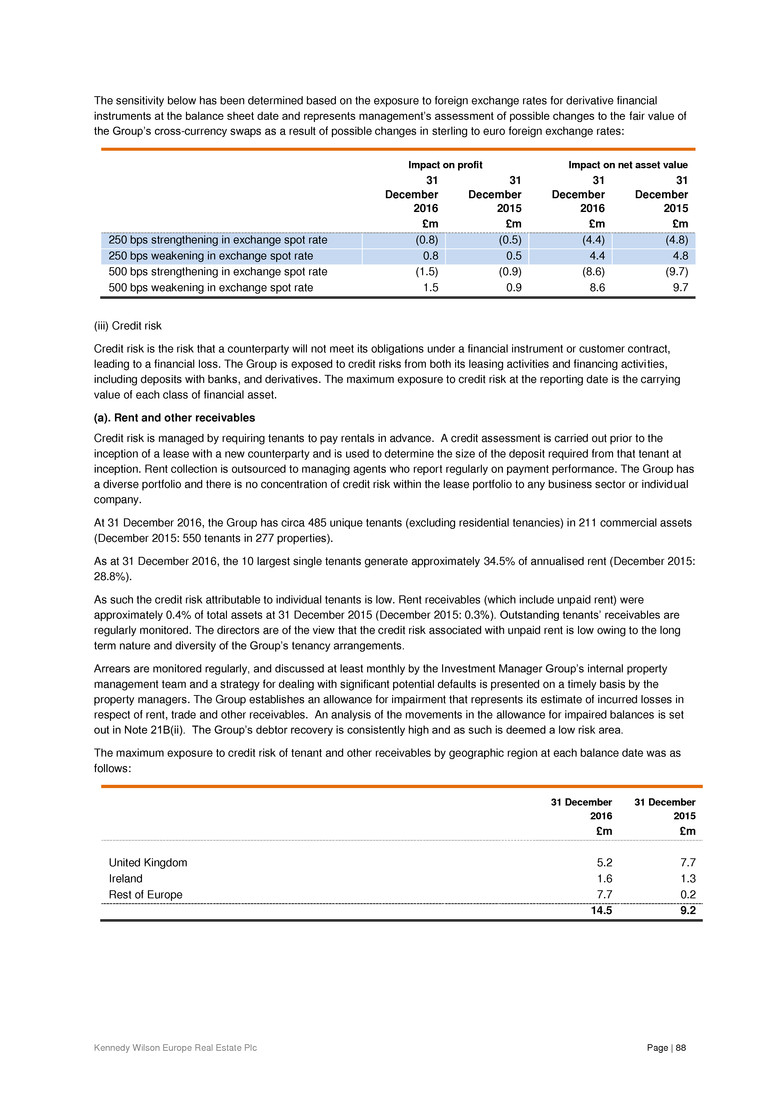
Kennedy Wilson Europe Real Estate Plc Page | 88 The sensitivity below has been determined based on the exposure to foreign exchange rates for derivative financial instruments at the balance sheet date and represents management’s assessment of possible changes to the fair value of the Group’s cross-currency swaps as a result of possible changes in sterling to euro foreign exchange rates: Impact on profit Impact on net asset value 31 December 2016 31 December 2015 31 December 2016 31 December 2015 £m £m £m £m 250 bps strengthening in exchange spot rate (0.8) (0.5) (4.4) (4.8) 250 bps weakening in exchange spot rate 0.8 0.5 4.4 4.8 500 bps strengthening in exchange spot rate (1.5) (0.9) (8.6) (9.7) 500 bps weakening in exchange spot rate 1.5 0.9 8.6 9.7 (iii) Credit risk Credit risk is the risk that a counterparty will not meet its obligations under a financial instrument or customer contract, leading to a financial loss. The Group is exposed to credit risks from both its leasing activities and financing activities, including deposits with banks, and derivatives. The maximum exposure to credit risk at the reporting date is the carrying value of each class of financial asset. (a). Rent and other receivables Credit risk is managed by requiring tenants to pay rentals in advance. A credit assessment is carried out prior to the inception of a lease with a new counterparty and is used to determine the size of the deposit required from that tenant at inception. Rent collection is outsourced to managing agents who report regularly on payment performance. The Group has a diverse portfolio and there is no concentration of credit risk within the lease portfolio to any business sector or individual company. At 31 December 2016, the Group has circa 485 unique tenants (excluding residential tenancies) in 211 commercial assets (December 2015: 550 tenants in 277 properties). As at 31 December 2016, the 10 largest single tenants generate approximately 34.5% of annualised rent (December 2015: 28.8%). As such the credit risk attributable to individual tenants is low. Rent receivables (which include unpaid rent) were approximately 0.4% of total assets at 31 December 2015 (December 2015: 0.3%). Outstanding tenants’ receivables are regularly monitored. The directors are of the view that the credit risk associated with unpaid rent is low owing to the long term nature and diversity of the Group’s tenancy arrangements. Arrears are monitored regularly, and discussed at least monthly by the Investment Manager Group’s internal property management team and a strategy for dealing with significant potential defaults is presented on a timely basis by the property managers. The Group establishes an allowance for impairment that represents its estimate of incurred losses in respect of rent, trade and other receivables. An analysis of the movements in the allowance for impaired balances is set out in Note 21B(ii). The Group’s debtor recovery is consistently high and as such is deemed a low risk area. The maximum exposure to credit risk of tenant and other receivables by geographic region at each balance date was as follows: 31 December 2016 31 December 2015 £m £m United Kingdom 5.2 7.7 Ireland 1.6 1.3 Rest of Europe 7.7 0.2 14.5 9.2
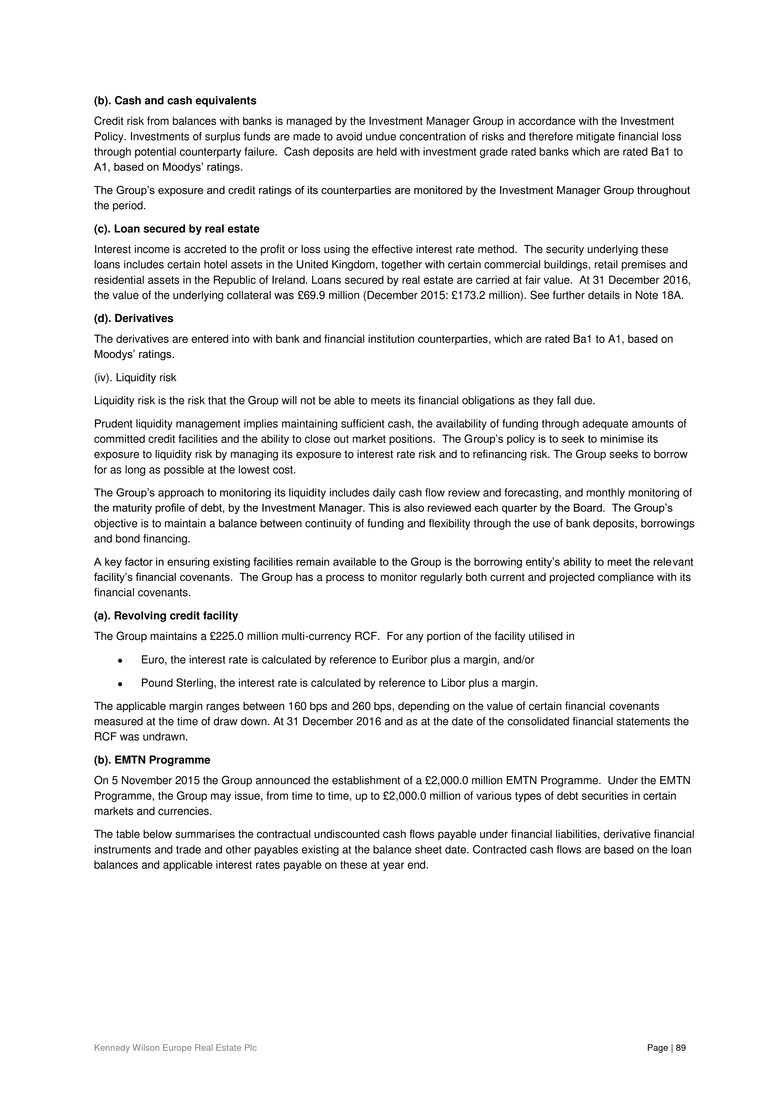
Kennedy Wilson Europe Real Estate Plc Page | 89 (b). Cash and cash equivalents Credit risk from balances with banks is managed by the Investment Manager Group in accordance with the Investment Policy. Investments of surplus funds are made to avoid undue concentration of risks and therefore mitigate financial loss through potential counterparty failure. Cash deposits are held with investment grade rated banks which are rated Ba1 to A1, based on Moodys’ ratings. The Group’s exposure and credit ratings of its counterparties are monitored by the Investment Manager Group throughout the period. (c). Loan secured by real estate Interest income is accreted to the profit or loss using the effective interest rate method. The security underlying these loans includes certain hotel assets in the United Kingdom, together with certain commercial buildings, retail premises and residential assets in the Republic of Ireland. Loans secured by real estate are carried at fair value. At 31 December 2016, the value of the underlying collateral was £69.9 million (December 2015: £173.2 million). See further details in Note 18A. (d). Derivatives The derivatives are entered into with bank and financial institution counterparties, which are rated Ba1 to A1, based on Moodys’ ratings. (iv). Liquidity risk Liquidity risk is the risk that the Group will not be able to meets its financial obligations as they fall due. Prudent liquidity management implies maintaining sufficient cash, the availability of funding through adequate amounts of committed credit facilities and the ability to close out market positions. The Group’s policy is to seek to minimise its exposure to liquidity risk by managing its exposure to interest rate risk and to refinancing risk. The Group seeks to borrow for as long as possible at the lowest cost. The Group’s approach to monitoring its liquidity includes daily cash flow review and forecasting, and monthly monitoring of the maturity profile of debt, by the Investment Manager. This is also reviewed each quarter by the Board. The Group’s objective is to maintain a balance between continuity of funding and flexibility through the use of bank deposits, borrowings and bond financing. A key factor in ensuring existing facilities remain available to the Group is the borrowing entity’s ability to meet the relevant facility’s financial covenants. The Group has a process to monitor regularly both current and projected compliance with its financial covenants. (a). Revolving credit facility The Group maintains a £225.0 million multi-currency RCF. For any portion of the facility utilised in Euro, the interest rate is calculated by reference to Euribor plus a margin, and/or Pound Sterling, the interest rate is calculated by reference to Libor plus a margin. The applicable margin ranges between 160 bps and 260 bps, depending on the value of certain financial covenants measured at the time of draw down. At 31 December 2016 and as at the date of the consolidated financial statements the RCF was undrawn. (b). EMTN Programme On 5 November 2015 the Group announced the establishment of a £2,000.0 million EMTN Programme. Under the EMTN Programme, the Group may issue, from time to time, up to £2,000.0 million of various types of debt securities in certain markets and currencies. The table below summarises the contractual undiscounted cash flows payable under financial liabilities, derivative financial instruments and trade and other payables existing at the balance sheet date. Contracted cash flows are based on the loan balances and applicable interest rates payable on these at year end.

Kennedy Wilson Europe Real Estate Plc Page | 90 I. 31 December 2016 Less than 3 months 3 to 12 months 1 to 2 years 2 to 5 years Over 5 years Total £m £m £m £m £m £m Secured borrowings 5.5 14.4 64.3 480.8 238.1 803.1 £500.0 million 3.95% 7 year unsecured bond1 - 18.8 18.8 56.4 539.4 633.4 €550.0 million 3.25% 10 year unsecured note2 - 15.3 15.3 45.8 530.5 606.9 Derivative financial instruments - - 3.9 18.0 32.4 54.3 Trade and other payables 25.9 2.7 0.2 1.3 1.6 31.7 31.4 51.2 102.5 602.3 1,342.0 2,129.4 Footnotes: 1. On 19 September 2016 the Company issued a further £200.0 million 3.95% senior unsecured bond as a tap to the original £300.0 million 3.95% senior unsecured bond issued on 30 June 2015. See Note 25C(i)(a). 2. On 19 April 2016 the Company issued a further €150.0 million 3.25% senior unsecured note as a tap to the original €400.0 million 3.25% senior unsecured note issued on 12 November 2015. See Note 25C(ii)(a). II. 31 December 2015 Less than 3 months 3 to 12 months 1 to 2 years 2 to 5 years Over 5 years Total £m £m £m £m £m £m Secured borrowings 5.6 17.4 23.3 716.6 174.6 937.5 £300.0 million 3.95% 7 year unsecured bond - 10.2 10.2 30.6 320.7 371.7 €400.0 million 3.25% 10 year unsecured note - 9.6 9.6 28.7 342.7 390.6 Derivative financial instruments - - - 2.3 7.8 10.1 Trade and other payables 30.0 1.6 1.7 1.1 0.7 35.1 35.6 38.8 44.8 779.3 846.5 1,745.0 The Group has two, one-year options to extend the maturity date of certain of its borrowings (Note 25B).

Kennedy Wilson Europe Real Estate Plc Page | 91 (v). Capital management The Group manages its capital to ensure that entities in the Group will be able to continue as a going concern and as such it aims to maintain a prudent mix between borrowings and equity financing. The Group’s capital structure comprises equity attributable to shareholders of the Company (Note 28), borrowings (Note 25) and cash and cash equivalents (Note 22). Equity comprises issued share capital, reserves and retained earnings as disclosed in the consolidated statement of changes in equity. Borrowings comprise term loan facilities, a revolving credit facility and unsecured bonds. Save for the currently undrawn RCF and the bonds, the remaining Group borrowings are secured on specific portfolios and are non–recourse to the Group as a whole The Group is not subject to any externally imposed capital requirements. The Board monitors the return on capital as well as the level of dividends to ordinary shareholders. Dividends are approved by the Board on an interim basis. (a). Net debt 31 December 2016 31 December 2015 £m £m Borrowings (Note 25) 1,677.2 1,414.3 Add: Unamortised borrowing costs (Note 25) 14.1 21.8 1,691.3 1,436.1 Cash and cash equivalents (Note 22) (456.5) (326.5) Net debt (excluding unamortised borrowing costs) 1,234.8 1,109.6 (b). Portfolio value 31 December 2016 31 December 2015 £m £m Investment and development property (Note 17) 2,741.6 2,554.3 Loans secured by real estate (Note 18) 67.6 179.2 Property, plant and equipment (Note 19) 73.0 59.2 2,882.2 2,792.7 (c). Loan to value 31 December 2016 31 December 2015 £m £m Portfolio value 2,882.2 2,792.7 Net debt (excluding unamortised borrowing costs) 1,234.8 1,109.6 Loan to value % 42.8 39.7
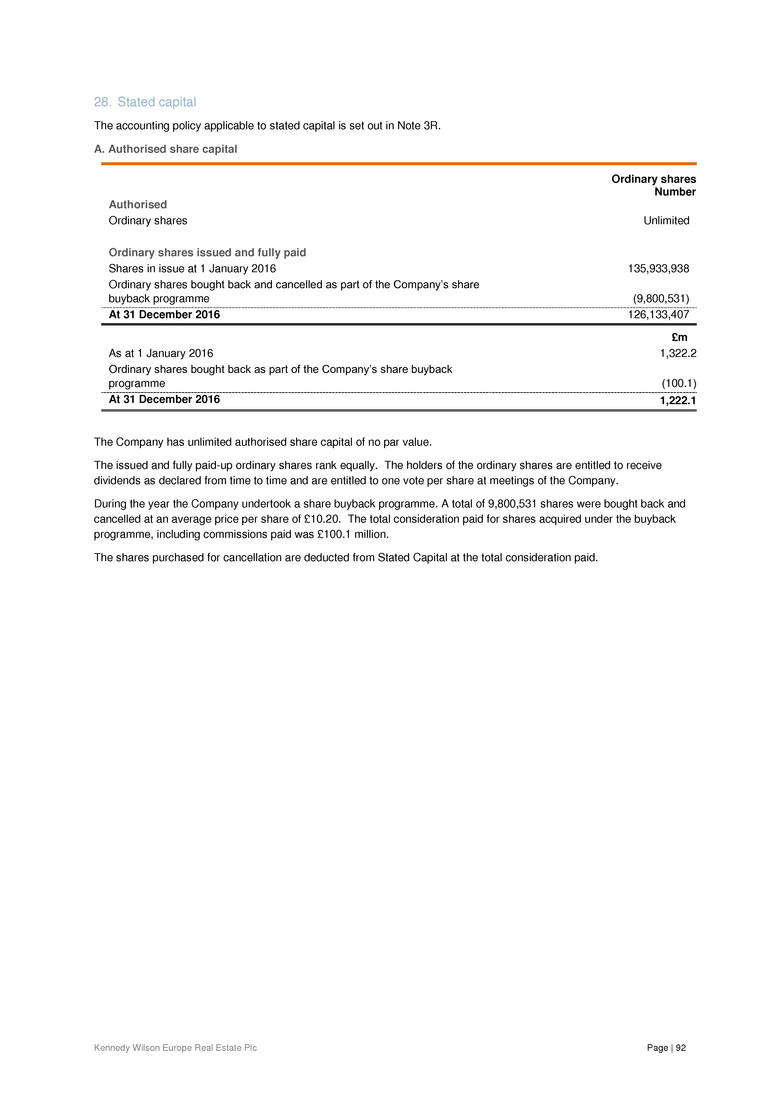
Kennedy Wilson Europe Real Estate Plc Page | 92 28. Stated capital The accounting policy applicable to stated capital is set out in Note 3R. A. Authorised share capital Ordinary shares Number Authorised Ordinary shares Unlimited Ordinary shares issued and fully paid Shares in issue at 1 January 2016 135,933,938 Ordinary shares bought back and cancelled as part of the Company’s share buyback programme (9,800,531) At 31 December 2016 126,133,407 £m As at 1 January 2016 1,322.2 Ordinary shares bought back as part of the Company’s share buyback programme (100.1) At 31 December 2016 1,222.1 The Company has unlimited authorised share capital of no par value. The issued and fully paid-up ordinary shares rank equally. The holders of the ordinary shares are entitled to receive dividends as declared from time to time and are entitled to one vote per share at meetings of the Company. During the year the Company undertook a share buyback programme. A total of 9,800,531 shares were bought back and cancelled at an average price per share of £10.20. The total consideration paid for shares acquired under the buyback programme, including commissions paid was £100.1 million. The shares purchased for cancellation are deducted from Stated Capital at the total consideration paid.
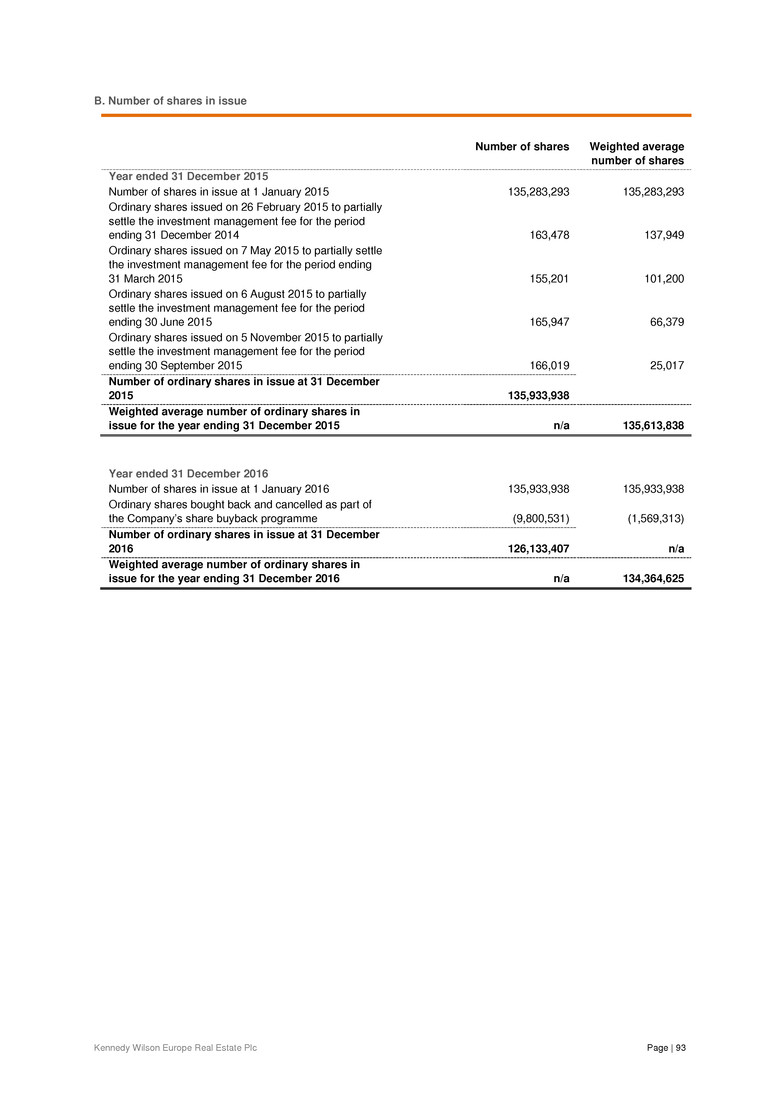
Kennedy Wilson Europe Real Estate Plc Page | 93 B. Number of shares in issue Number of shares Weighted average number of shares Year ended 31 December 2015 Number of shares in issue at 1 January 2015 135,283,293 135,283,293 Ordinary shares issued on 26 February 2015 to partially settle the investment management fee for the period ending 31 December 2014 163,478 137,949 Ordinary shares issued on 7 May 2015 to partially settle the investment management fee for the period ending 31 March 2015 155,201 101,200 Ordinary shares issued on 6 August 2015 to partially settle the investment management fee for the period ending 30 June 2015 165,947 66,379 Ordinary shares issued on 5 November 2015 to partially settle the investment management fee for the period ending 30 September 2015 166,019 25,017 Number of ordinary shares in issue at 31 December 2015 135,933,938 Weighted average number of ordinary shares in issue for the year ending 31 December 2015 n/a 135,613,838 Year ended 31 December 2016 Number of shares in issue at 1 January 2016 135,933,938 135,933,938 Ordinary shares bought back and cancelled as part of the Company’s share buyback programme (9,800,531) (1,569,313) Number of ordinary shares in issue at 31 December 2016 126,133,407 n/a Weighted average number of ordinary shares in issue for the year ending 31 December 2016 n/a 134,364,625
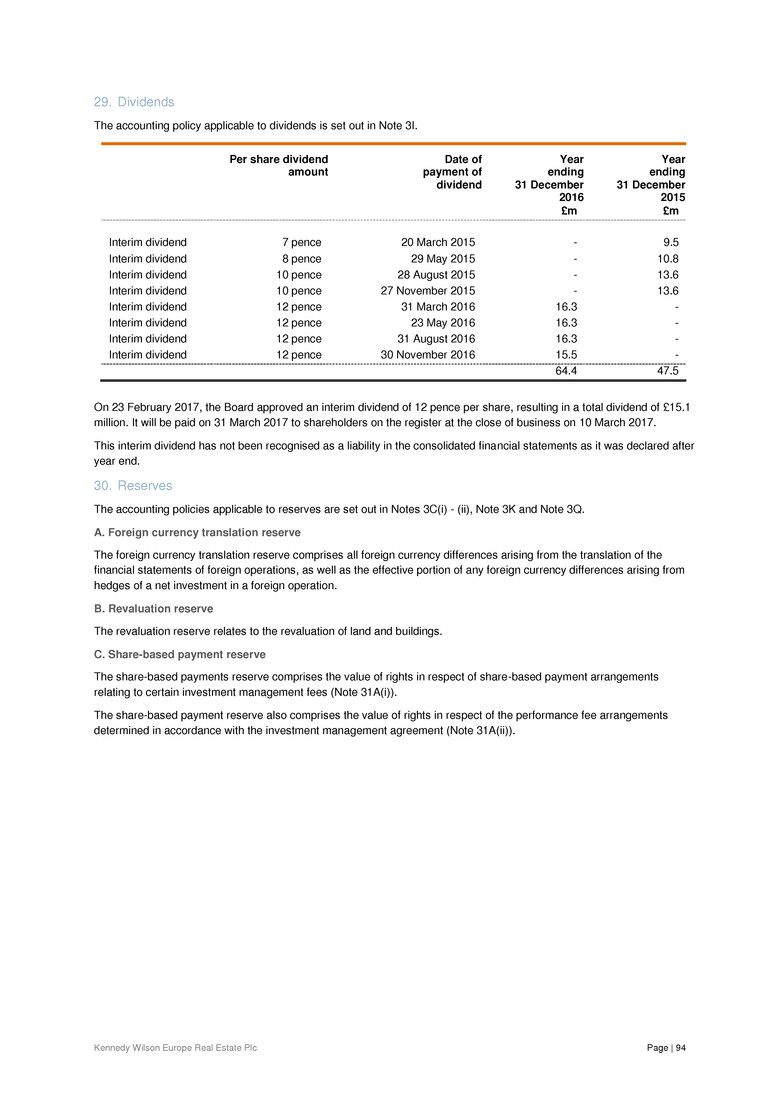
Kennedy Wilson Europe Real Estate Plc Page | 94 29. Dividends The accounting policy applicable to dividends is set out in Note 3I. Per share dividend amount Date of payment of dividend Year ending 31 December 2016 Year ending 31 December 2015 £m £m Interim dividend 7 pence 20 March 2015 - 9.5 Interim dividend 8 pence 29 May 2015 - 10.8 Interim dividend 10 pence 28 August 2015 - 13.6 Interim dividend 10 pence 27 November 2015 - 13.6 Interim dividend 12 pence 31 March 2016 16.3 - Interim dividend 12 pence 23 May 2016 16.3 - Interim dividend 12 pence 31 August 2016 16.3 - Interim dividend 12 pence 30 November 2016 15.5 - 64.4 47.5 On 23 February 2017, the Board approved an interim dividend of 12 pence per share, resulting in a total dividend of £15.1 million. It will be paid on 31 March 2017 to shareholders on the register at the close of business on 10 March 2017. This interim dividend has not been recognised as a liability in the consolidated financial statements as it was declared after year end. 30. Reserves The accounting policies applicable to reserves are set out in Notes 3C(i) - (ii), Note 3K and Note 3Q. A. Foreign currency translation reserve The foreign currency translation reserve comprises all foreign currency differences arising from the translation of the financial statements of foreign operations, as well as the effective portion of any foreign currency differences arising from hedges of a net investment in a foreign operation. B. Revaluation reserve The revaluation reserve relates to the revaluation of land and buildings. C. Share-based payment reserve The share-based payments reserve comprises the value of rights in respect of share-based payment arrangements relating to certain investment management fees (Note 31A(i)). The share-based payment reserve also comprises the value of rights in respect of the performance fee arrangements determined in accordance with the investment management agreement (Note 31A(ii)).
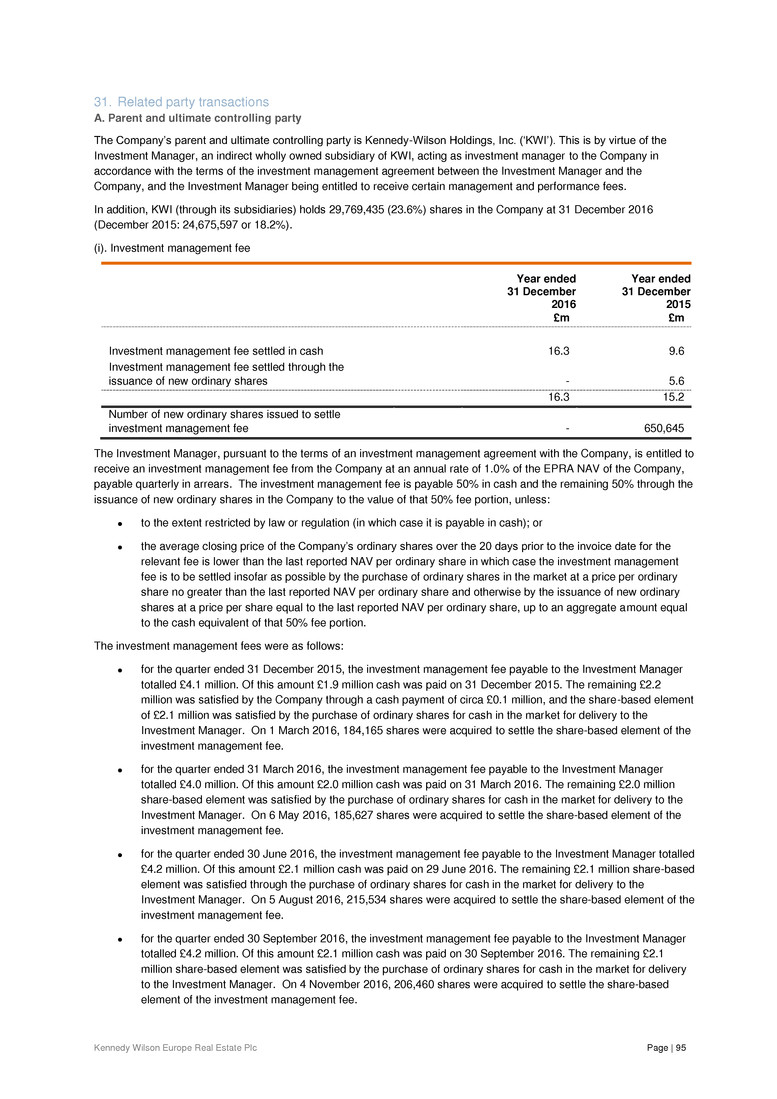
Kennedy Wilson Europe Real Estate Plc Page | 95 31. Related party transactions A. Parent and ultimate controlling party The Company’s parent and ultimate controlling party is Kennedy-Wilson Holdings, Inc. (‘KWI’). This is by virtue of the Investment Manager, an indirect wholly owned subsidiary of KWI, acting as investment manager to the Company in accordance with the terms of the investment management agreement between the Investment Manager and the Company, and the Investment Manager being entitled to receive certain management and performance fees. In addition, KWI (through its subsidiaries) holds 29,769,435 (23.6%) shares in the Company at 31 December 2016 (December 2015: 24,675,597 or 18.2%). (i). Investment management fee Year ended 31 December 2016 Year ended 31 December 2015 £m £m Investment management fee settled in cash 16.3 9.6 Investment management fee settled through the issuance of new ordinary shares - 5.6 16.3 15.2 Number of new ordinary shares issued to settle investment management fee - 650,645 The Investment Manager, pursuant to the terms of an investment management agreement with the Company, is entitled to receive an investment management fee from the Company at an annual rate of 1.0% of the EPRA NAV of the Company, payable quarterly in arrears. The investment management fee is payable 50% in cash and the remaining 50% through the issuance of new ordinary shares in the Company to the value of that 50% fee portion, unless: to the extent restricted by law or regulation (in which case it is payable in cash); or the average closing price of the Company’s ordinary shares over the 20 days prior to the invoice date for the relevant fee is lower than the last reported NAV per ordinary share in which case the investment management fee is to be settled insofar as possible by the purchase of ordinary shares in the market at a price per ordinary share no greater than the last reported NAV per ordinary share and otherwise by the issuance of new ordinary shares at a price per share equal to the last reported NAV per ordinary share, up to an aggregate amount equal to the cash equivalent of that 50% fee portion. The investment management fees were as follows: for the quarter ended 31 December 2015, the investment management fee payable to the Investment Manager totalled £4.1 million. Of this amount £1.9 million cash was paid on 31 December 2015. The remaining £2.2 million was satisfied by the Company through a cash payment of circa £0.1 million, and the share-based element of £2.1 million was satisfied by the purchase of ordinary shares for cash in the market for delivery to the Investment Manager. On 1 March 2016, 184,165 shares were acquired to settle the share-based element of the investment management fee. for the quarter ended 31 March 2016, the investment management fee payable to the Investment Manager totalled £4.0 million. Of this amount £2.0 million cash was paid on 31 March 2016. The remaining £2.0 million share-based element was satisfied by the purchase of ordinary shares for cash in the market for delivery to the Investment Manager. On 6 May 2016, 185,627 shares were acquired to settle the share-based element of the investment management fee. for the quarter ended 30 June 2016, the investment management fee payable to the Investment Manager totalled £4.2 million. Of this amount £2.1 million cash was paid on 29 June 2016. The remaining £2.1 million share-based element was satisfied through the purchase of ordinary shares for cash in the market for delivery to the Investment Manager. On 5 August 2016, 215,534 shares were acquired to settle the share-based element of the investment management fee. for the quarter ended 30 September 2016, the investment management fee payable to the Investment Manager totalled £4.2 million. Of this amount £2.1 million cash was paid on 30 September 2016. The remaining £2.1 million share-based element was satisfied by the purchase of ordinary shares for cash in the market for delivery to the Investment Manager. On 4 November 2016, 206,460 shares were acquired to settle the share-based element of the investment management fee.

Kennedy Wilson Europe Real Estate Plc Page | 96 for the quarter ended 31 December 2016, the investment management fee payable to the Investment Manager totals £3.9 million. Of this amount £2.0 million was paid on 30 December 2016. The remaining £1.9 million share- based element will be satisfied insofar as possible by the purchase of ordinary shares for cash in the market for delivery to the Investment Manager at a price per ordinary share no greater than the last reported NAV per ordinary share and otherwise by the issuance of new ordinary shares at a price per share equal to the last reported NAV per ordinary share. The total amount of the investment management fee in respect of the year ended 31 December 2016 was £16.3 million (year ended 31 December 2015: £15.2 million). The Investment Manager has also paid certain expenses on behalf of the Company and the Company has reimbursed the Investment Manager in the amount of £2.0 million (year ended 31 December 2015: £0.7 million). (ii). Performance fee Year ended 31 December 2016 Year ended 31 December 2015 £m £m Performance fee - 29.7 The Investment Manager, pursuant to the terms of an investment management agreement with the Company, is entitled to receive a performance fee. It is a form of remuneration used to reward the Investment Manager for generating returns to shareholders. Since the average closing share price of the Company’s ordinary shares for the twenty days immediately prior to the invoice date for the 2015 performance fee was below the last reported NAV per share the 2015 performance fee was settled by the purchase of ordinary shares in the market for the cash equivalent amount of the performance fee being £29.7 million. On 1 March 2016, 2,684,102 shares were acquired to settle the performance fee. Since the performance fee threshold has not been reached during the year ended 31 December 2016, no performance fee is payable for this year. The return to shareholders in an accounting period is the increase in the EPRA NAV per ordinary share plus the total dividends and other distributions that are declared in the accounting period (adjusted to exclude the effects of any issuance of ordinary shares during that accounting period) (“Shareholder Return”). The performance fee is calculated annually on a per ordinary share basis as 20% of the lesser of performance above two hurdles, as follows: The excess of Shareholder Return over a 10% annual hurdle rate. The annual return hurdle resets annually to 10% of the sum of the previous accounting period’s EPRA NAV per ordinary share; and The excess of the year end EPRA NAV per ordinary share (which is adjusted to include total dividends declared or other distributions in the accounting period and adjusted to exclude the effects of any issuance of ordinary shares during that accounting period) over the relevant high water mark. The relevant high water mark in each accounting period is the greater of – the closing EPRA NAV per ordinary share achieved in the reference period (which is the most recent accounting period in which a performance fee was payable) adjusted for total dividends or other distributions paid per ordinary share and adjusted to exclude the effects of any issue of ordinary shares during the reference period, and – the gross opening NAV (being the gross cash and non-cash proceeds of the initial issue) plus further cash and non-cash issues of ordinary shares (excluding any issues of ordinary shares in part settlement of the investment management fee or the performance fee), calculated on a per ordinary share basis as at the end of the accounting period in respect of which the performance fee is calculated. The performance fee is payable either through the issuance of new ordinary shares in the Company to the value of the performance fee or by the purchase of shares in the market at a price no greater than the last reported NAV per ordinary share for delivery to the Investment Manager for an aggregate amount equal to the cash equivalent value of the performance fee. To the extent that payment of the performance fee in ordinary shares is restricted by law or regulation, it is payable in cash. Where the average closing price of the Company’s ordinary shares over the twenty days prior to the payment date for the performance fee is higher than the last reported NAV per ordinary share, the performance fee is settled through the issue of new ordinary shares, the number of which is determined by dividing the cash equivalent amount of the performance fee
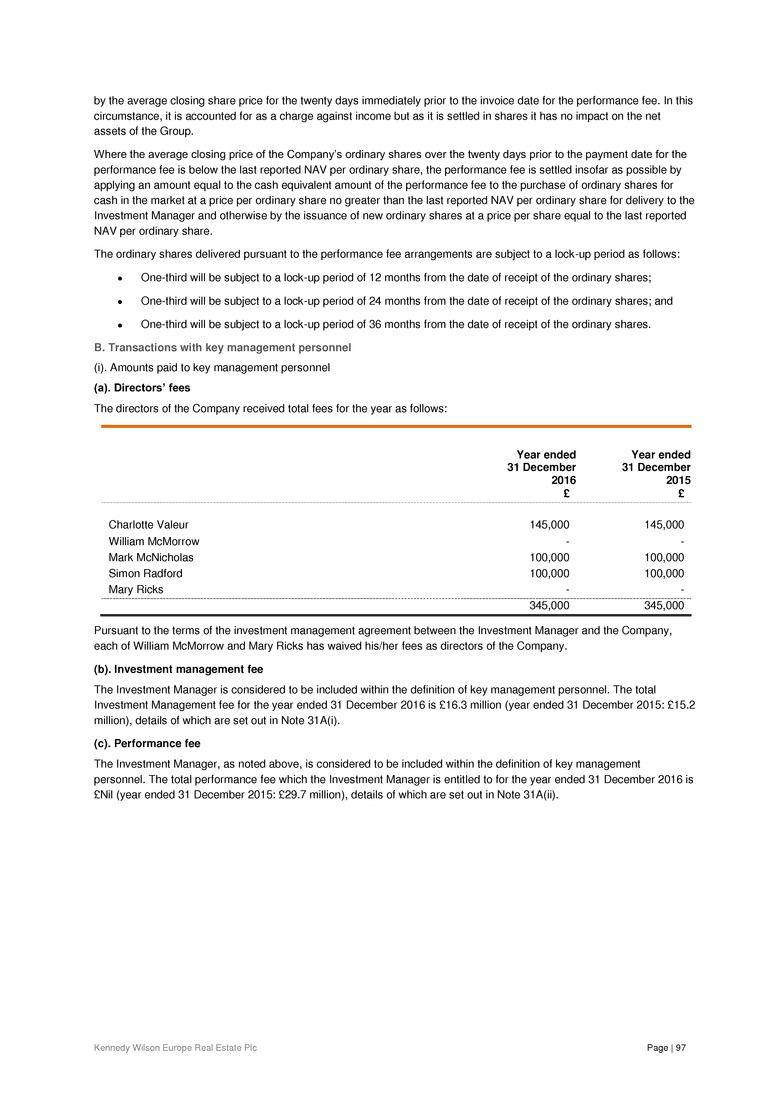
Kennedy Wilson Europe Real Estate Plc Page | 97 by the average closing share price for the twenty days immediately prior to the invoice date for the performance fee. In this circumstance, it is accounted for as a charge against income but as it is settled in shares it has no impact on the net assets of the Group. Where the average closing price of the Company’s ordinary shares over the twenty days prior to the payment date for the performance fee is below the last reported NAV per ordinary share, the performance fee is settled insofar as possible by applying an amount equal to the cash equivalent amount of the performance fee to the purchase of ordinary shares for cash in the market at a price per ordinary share no greater than the last reported NAV per ordinary share for delivery to the Investment Manager and otherwise by the issuance of new ordinary shares at a price per share equal to the last reported NAV per ordinary share. The ordinary shares delivered pursuant to the performance fee arrangements are subject to a lock-up period as follows: One-third will be subject to a lock-up period of 12 months from the date of receipt of the ordinary shares; One-third will be subject to a lock-up period of 24 months from the date of receipt of the ordinary shares; and One-third will be subject to a lock-up period of 36 months from the date of receipt of the ordinary shares. B. Transactions with key management personnel (i). Amounts paid to key management personnel (a). Directors’ fees The directors of the Company received total fees for the year as follows: Year ended 31 December 2016 Year ended 31 December 2015 £ £ Charlotte Valeur 145,000 145,000 William McMorrow - - Mark McNicholas 100,000 100,000 Simon Radford 100,000 100,000 Mary Ricks - - 345,000 345,000 Pursuant to the terms of the investment management agreement between the Investment Manager and the Company, each of William McMorrow and Mary Ricks has waived his/her fees as directors of the Company. (b). Investment management fee The Investment Manager is considered to be included within the definition of key management personnel. The total Investment Management fee for the year ended 31 December 2016 is £16.3 million (year ended 31 December 2015: £15.2 million), details of which are set out in Note 31A(i). (c). Performance fee The Investment Manager, as noted above, is considered to be included within the definition of key management personnel. The total performance fee which the Investment Manager is entitled to for the year ended 31 December 2016 is £Nil (year ended 31 December 2015: £29.7 million), details of which are set out in Note 31A(ii).
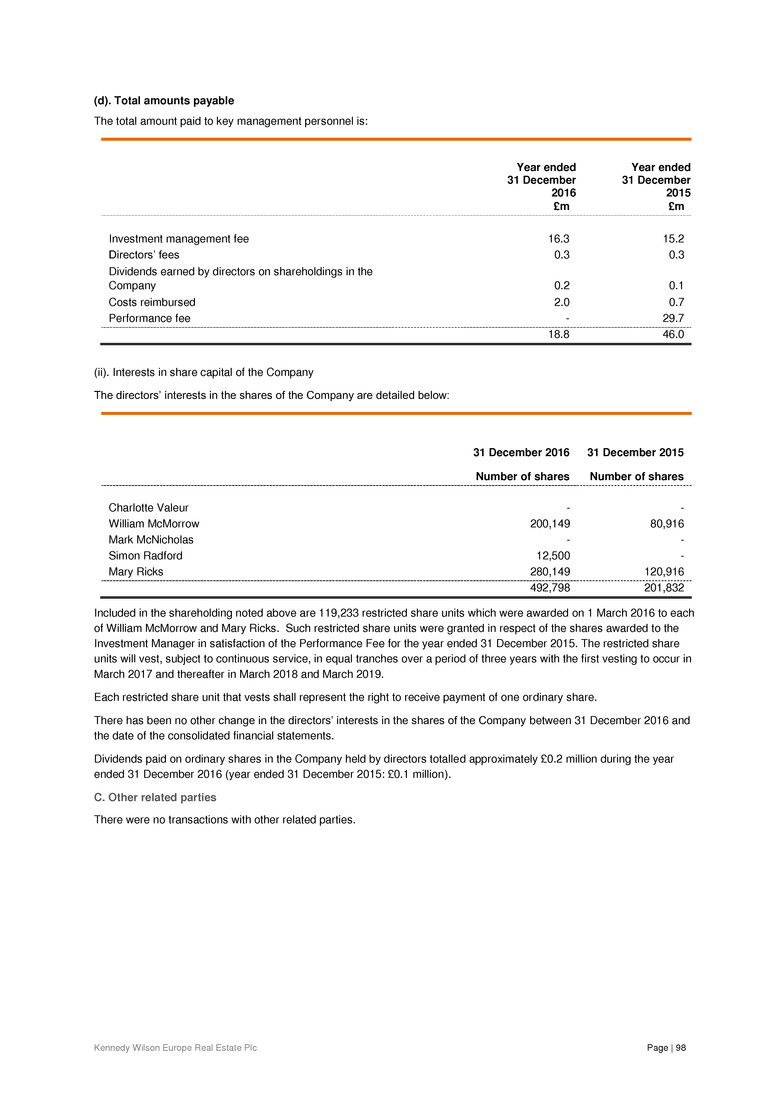
Kennedy Wilson Europe Real Estate Plc Page | 98 (d). Total amounts payable The total amount paid to key management personnel is: Year ended 31 December 2016 Year ended 31 December 2015 £m £m Investment management fee 16.3 15.2 Directors’ fees 0.3 0.3 Dividends earned by directors on shareholdings in the Company 0.2 0.1 Costs reimbursed 2.0 0.7 Performance fee - 29.7 18.8 46.0 (ii). Interests in share capital of the Company The directors’ interests in the shares of the Company are detailed below: 31 December 2016 31 December 2015 Number of shares Number of shares Charlotte Valeur - - William McMorrow 200,149 80,916 Mark McNicholas - - Simon Radford 12,500 - Mary Ricks 280,149 120,916 492,798 201,832 Included in the shareholding noted above are 119,233 restricted share units which were awarded on 1 March 2016 to each of William McMorrow and Mary Ricks. Such restricted share units were granted in respect of the shares awarded to the Investment Manager in satisfaction of the Performance Fee for the year ended 31 December 2015. The restricted share units will vest, subject to continuous service, in equal tranches over a period of three years with the first vesting to occur in March 2017 and thereafter in March 2018 and March 2019. Each restricted share unit that vests shall represent the right to receive payment of one ordinary share. There has been no other change in the directors’ interests in the shares of the Company between 31 December 2016 and the date of the consolidated financial statements. Dividends paid on ordinary shares in the Company held by directors totalled approximately £0.2 million during the year ended 31 December 2016 (year ended 31 December 2015: £0.1 million). C. Other related parties There were no transactions with other related parties.
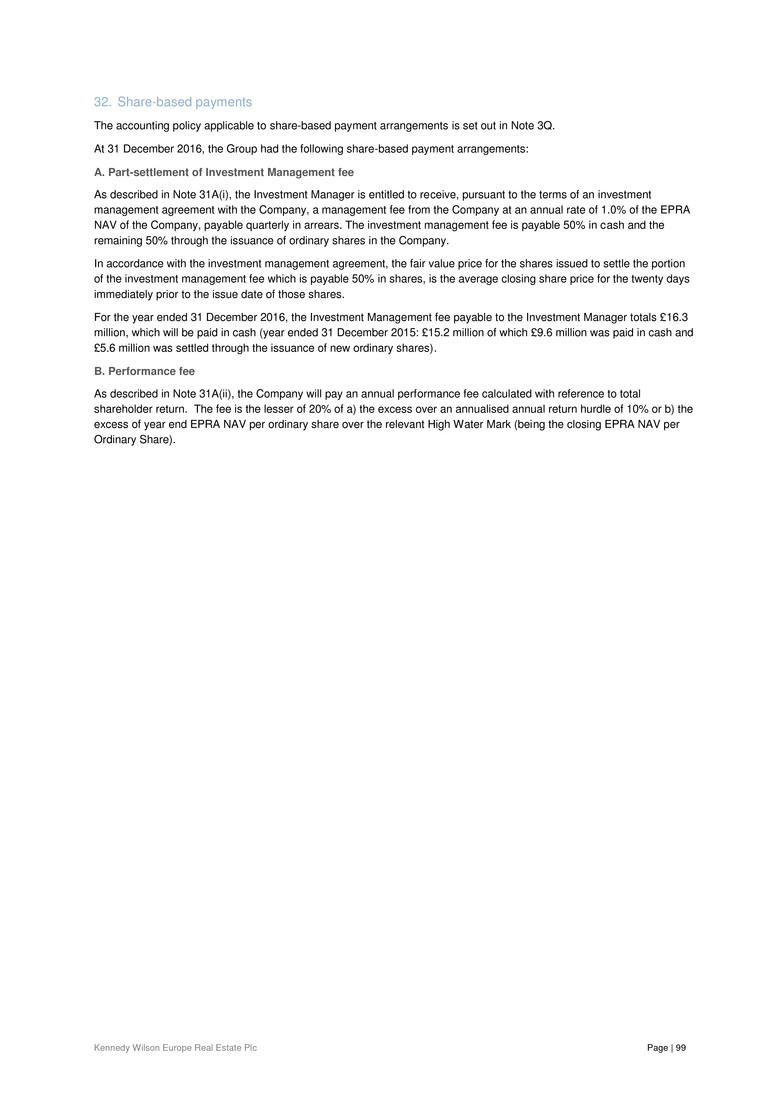
Kennedy Wilson Europe Real Estate Plc Page | 99 32. Share-based payments The accounting policy applicable to share-based payment arrangements is set out in Note 3Q. At 31 December 2016, the Group had the following share-based payment arrangements: A. Part-settlement of Investment Management fee As described in Note 31A(i), the Investment Manager is entitled to receive, pursuant to the terms of an investment management agreement with the Company, a management fee from the Company at an annual rate of 1.0% of the EPRA NAV of the Company, payable quarterly in arrears. The investment management fee is payable 50% in cash and the remaining 50% through the issuance of ordinary shares in the Company. In accordance with the investment management agreement, the fair value price for the shares issued to settle the portion of the investment management fee which is payable 50% in shares, is the average closing share price for the twenty days immediately prior to the issue date of those shares. For the year ended 31 December 2016, the Investment Management fee payable to the Investment Manager totals £16.3 million, which will be paid in cash (year ended 31 December 2015: £15.2 million of which £9.6 million was paid in cash and £5.6 million was settled through the issuance of new ordinary shares). B. Performance fee As described in Note 31A(ii), the Company will pay an annual performance fee calculated with reference to total shareholder return. The fee is the lesser of 20% of a) the excess over an annualised annual return hurdle of 10% or b) the excess of year end EPRA NAV per ordinary share over the relevant High Water Mark (being the closing EPRA NAV per Ordinary Share).

Kennedy Wilson Europe Real Estate Plc Page | 100 33. Group entities The accounting policy applicable to group entities is set out in Note 3A(i). Except where indicated the following are indirect subsidiaries of the Company. All the Company’s direct and indirect interests are in ordinary shares. Except as noted, all are wholly owned property investment companies and are included in the consolidated financial statements. Incorporated and registered in Jersey Bizet Limited Jupiter Argyle Ltd Jupiter Friars Ltd Jupiter Holdco Ltd Jupiter Hull Limited Jupiter Marathon Ltd Jupiter Pennine Ltd Jupiter Rubislaw Ltd Jupiter Seafield Ltd Jupiter Showroom Ltd Jupiter Tradeco Ltd Jupiter Trident Ltd KW Artemis UK Properties HoldCo Ltd KW BPR Ltd KW Dukes Park Limited KW High Street Retail B Ltd KW Industrial B Ltd KW Industrial SPV 1 Ltd KW Industrial SPV 2 Ltd KW Ipswich Limited KW Office Limited KW Office SPV 1 Ltd (formerly KW Dionysus Ltd) KW Office SPV 2 Ltd (formerly KW Agamemnon Ltd) KW Office SPV 3 Ltd KW MH Limited KW Niobe Ltd KW Regional Office B Ltd KW Retail SPV 1 Ltd KW Retail SPV 2 Ltd (formerly Crumbie Ltd) KW Retail Warehouse SPV 1 Ltd KW Ringway Limited KW Trade Co Ltd (formerly Bengal Ltd) KW UK Assets Holdco Ltd * KWVF Tiger Ltd KW Towers Limited Nessun Limited Scarlatti Limited Triviata Limited Gatsby Aberdeen Limited Gatsby Capital 1 Limited Gatsby Capital 2 Limited Gatsby Capital 3 Limited Gatsby Chatham Limited Gatsby Croydon Limited Gatsby GIR Limited Gatsby GR Limited Gatsby Grocery Limited Gatsby Industrial Limited Gatsby INV 1 Limited Gatsby Middlewich Limited Gatsby PFS Limited Gatsby PH Limited Gatsby Retail Limited Gatsby Saltash Limited KW Gatsby Limited KW Italy Investments Holdco Limited * KW Olimpia Holdco Limited SEO Bartley Wood Limited SEO Bracknell Limited SEO Farnborough Limited SEO Finance Limited SEO Harlow Limited SEO Langley Limited SEO Maidenhead Limited SEO Reading Limited SEO Stockley Limited SEO Watford Limited KW Pioneer Point Limited Incorporated and registered in Republic of Ireland Cavalli Investments ICAV KW Investment Funds ICAV KW Portmarnock Ops Ltd Incorporated and registered in Luxembourg KW Lux FinanceCo S.à.r.l. * KW Real Estate Lux S.à.r.l. * KW Investment Lux S.à.r.l. * KW Investment One Lux S.à.r.l. KW Investment Two Lux S.à.r.l. KW Investment Three Lux S.à.r.l. KW Investment Four Lux S.à.r.l. KW Investment Five Lux S.à.r.l. KW Investment Six Lux S.à.r.l. KW Investment Eight Lux S.à.r.l. KW Investment Nine Lux S.à.r.l. KW Investment Ten Lux S.à.r.l. KW Investment Eleven Lux S.à.r.l. KW Investment Twelve Lux S.à.r.l. Incorporated and registered in England or Scotland St Andrews Bay Development Ltd KW Pioneer Point UK OpCo Limited Incorporated and registered in Spain Alemina Investments, S.L. ** KW Spanish Holdco, SL KW LMG Propco 1, SL KW New Propco 1, SL KW Sol Propco, SL KW Sol Propco 2, SL KW Velazquez Propco1, SL KW Velazquez Propco 2, SL Leterana Servicios Y Gestiones, SL ** Parque Comercial Guadalhorce, SL Incorporated and registered in the Isle of Man Kish One Limited * Directly owned ** 90% owned by the Group
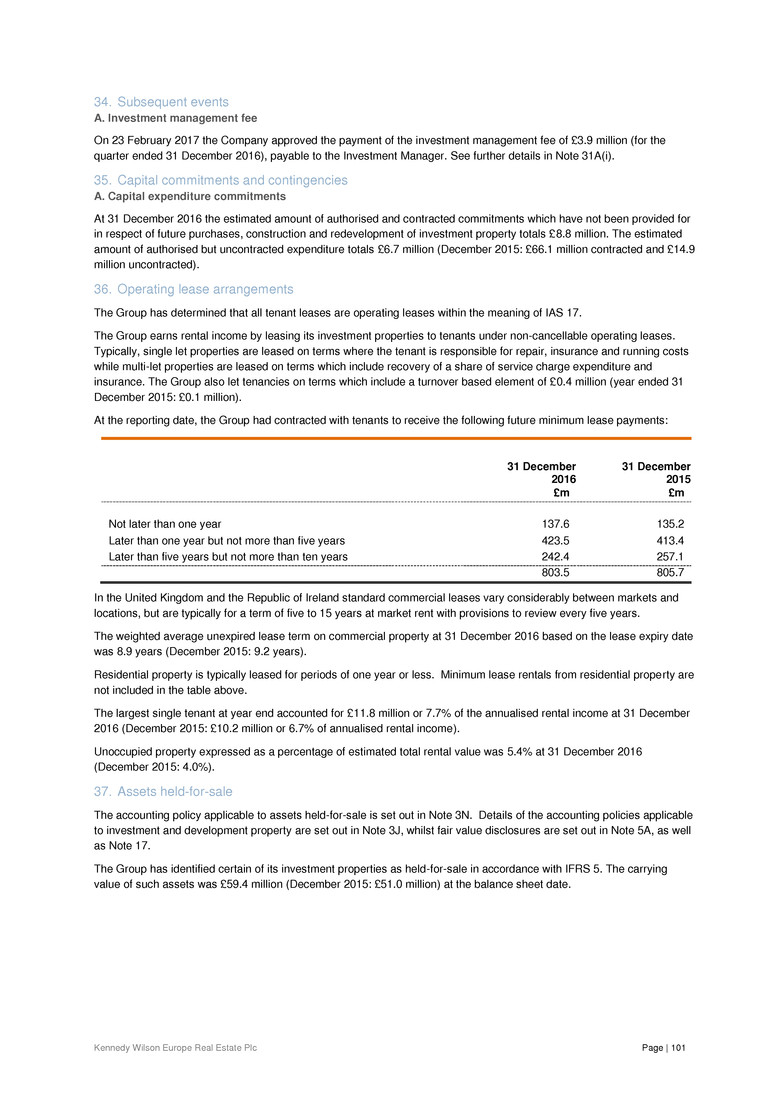
Kennedy Wilson Europe Real Estate Plc Page | 101 34. Subsequent events A. Investment management fee On 23 February 2017 the Company approved the payment of the investment management fee of £3.9 million (for the quarter ended 31 December 2016), payable to the Investment Manager. See further details in Note 31A(i). 35. Capital commitments and contingencies A. Capital expenditure commitments At 31 December 2016 the estimated amount of authorised and contracted commitments which have not been provided for in respect of future purchases, construction and redevelopment of investment property totals £8.8 million. The estimated amount of authorised but uncontracted expenditure totals £6.7 million (December 2015: £66.1 million contracted and £14.9 million uncontracted). 36. Operating lease arrangements The Group has determined that all tenant leases are operating leases within the meaning of IAS 17. The Group earns rental income by leasing its investment properties to tenants under non-cancellable operating leases. Typically, single let properties are leased on terms where the tenant is responsible for repair, insurance and running costs while multi-let properties are leased on terms which include recovery of a share of service charge expenditure and insurance. The Group also let tenancies on terms which include a turnover based element of £0.4 million (year ended 31 December 2015: £0.1 million). At the reporting date, the Group had contracted with tenants to receive the following future minimum lease payments: 31 December 2016 31 December 2015 £m £m Not later than one year 137.6 135.2 Later than one year but not more than five years 423.5 413.4 Later than five years but not more than ten years 242.4 257.1 803.5 805.7 In the United Kingdom and the Republic of Ireland standard commercial leases vary considerably between markets and locations, but are typically for a term of five to 15 years at market rent with provisions to review every five years. The weighted average unexpired lease term on commercial property at 31 December 2016 based on the lease expiry date was 8.9 years (December 2015: 9.2 years). Residential property is typically leased for periods of one year or less. Minimum lease rentals from residential property are not included in the table above. The largest single tenant at year end accounted for £11.8 million or 7.7% of the annualised rental income at 31 December 2016 (December 2015: £10.2 million or 6.7% of annualised rental income). Unoccupied property expressed as a percentage of estimated total rental value was 5.4% at 31 December 2016 (December 2015: 4.0%). 37. Assets held-for-sale The accounting policy applicable to assets held-for-sale is set out in Note 3N. Details of the accounting policies applicable to investment and development property are set out in Note 3J, whilst fair value disclosures are set out in Note 5A, as well as Note 17. The Group has identified certain of its investment properties as held-for-sale in accordance with IFRS 5. The carrying value of such assets was £59.4 million (December 2015: £51.0 million) at the balance sheet date.
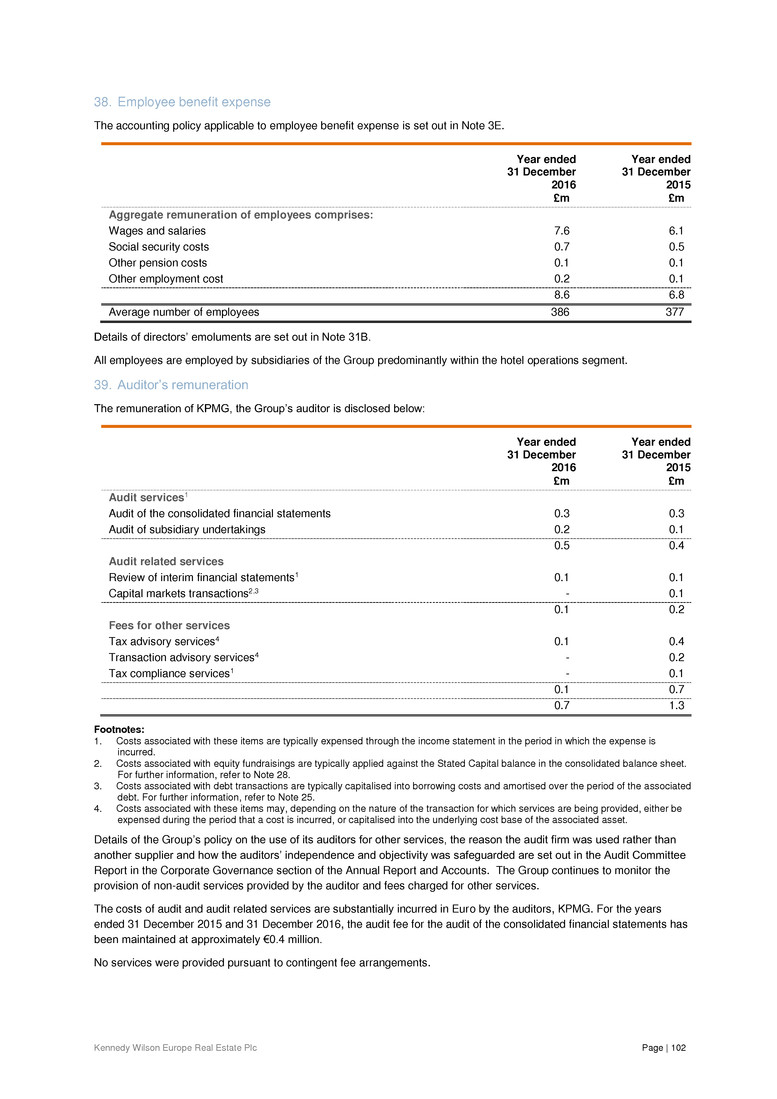
Kennedy Wilson Europe Real Estate Plc Page | 102 38. Employee benefit expense The accounting policy applicable to employee benefit expense is set out in Note 3E. Year ended 31 December 2016 Year ended 31 December 2015 £m £m Aggregate remuneration of employees comprises: Wages and salaries 7.6 6.1 Social security costs 0.7 0.5 Other pension costs 0.1 0.1 Other employment cost 0.2 0.1 8.6 6.8 Average number of employees 386 377 Details of directors’ emoluments are set out in Note 31B. All employees are employed by subsidiaries of the Group predominantly within the hotel operations segment. 39. Auditor’s remuneration The remuneration of KPMG, the Group’s auditor is disclosed below: Year ended 31 December 2016 Year ended 31 December 2015 £m £m Audit services1 Audit of the consolidated financial statements 0.3 0.3 Audit of subsidiary undertakings 0.2 0.1 0.5 0.4 Audit related services Review of interim financial statements1 0.1 0.1 Capital markets transactions2,3 - 0.1 0.1 0.2 Fees for other services Tax advisory services4 0.1 0.4 Transaction advisory services4 - 0.2 Tax compliance services1 - 0.1 0.1 0.7 0.7 1.3 Footnotes: 1. Costs associated with these items are typically expensed through the income statement in the period in which the expense is incurred. 2. Costs associated with equity fundraisings are typically applied against the Stated Capital balance in the consolidated balance sheet. For further information, refer to Note 28. 3. Costs associated with debt transactions are typically capitalised into borrowing costs and amortised over the period of the associated debt. For further information, refer to Note 25. 4. Costs associated with these items may, depending on the nature of the transaction for which services are being provided, either be expensed during the period that a cost is incurred, or capitalised into the underlying cost base of the associated asset. Details of the Group’s policy on the use of its auditors for other services, the reason the audit firm was used rather than another supplier and how the auditors’ independence and objectivity was safeguarded are set out in the Audit Committee Report in the Corporate Governance section of the Annual Report and Accounts. The Group continues to monitor the provision of non-audit services provided by the auditor and fees charged for other services. The costs of audit and audit related services are substantially incurred in Euro by the auditors, KPMG. For the years ended 31 December 2015 and 31 December 2016, the audit fee for the audit of the consolidated financial statements has been maintained at approximately €0.4 million. No services were provided pursuant to contingent fee arrangements.

Kennedy Wilson Europe Real Estate Plc Page | 103 40. Approval of the annual financial statements The consolidated financial statements were authorised for issue by the Company’s Board of Directors on 23 February 2017.
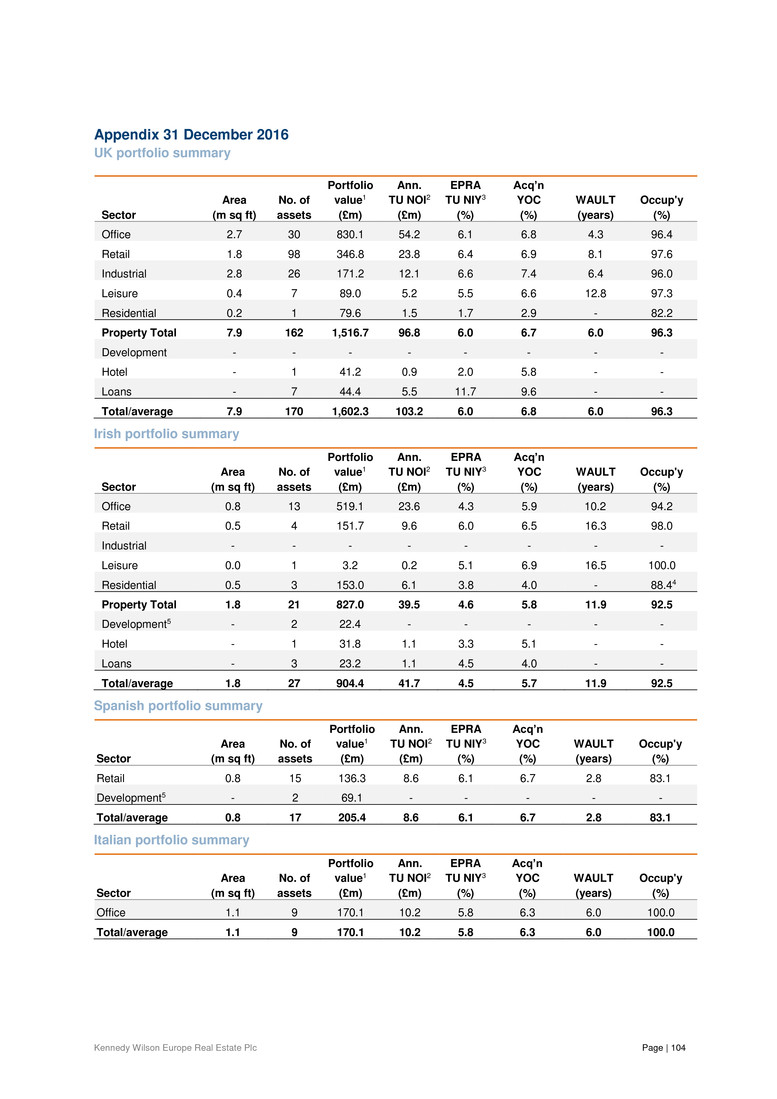
Kennedy Wilson Europe Real Estate Plc Page | 104 Appendix 31 December 2016 UK portfolio summary Portfolio Ann. EPRA Acq’n Area No. of value1 TU NOI2 TU NIY3 YOC WAULT Occup'y Sector (m sq ft) assets (£m) (£m) (%) (%) (years) (%) Office 2.7 30 830.1 54.2 6.1 6.8 4.3 96.4 Retail 1.8 98 346.8 23.8 6.4 6.9 8.1 97.6 Industrial 2.8 26 171.2 12.1 6.6 7.4 6.4 96.0 Leisure 0.4 7 89.0 5.2 5.5 6.6 12.8 97.3 Residential 0.2 1 79.6 1.5 1.7 2.9 - 82.2 Property Total 7.9 162 1,516.7 96.8 6.0 6.7 6.0 96.3 Development - - - - - - - - Hotel - 1 41.2 0.9 2.0 5.8 - - Loans - 7 44.4 5.5 11.7 9.6 - - Total/average 7.9 170 1,602.3 103.2 6.0 6.8 6.0 96.3 Irish portfolio summary Portfolio Ann. EPRA Acq’n Area No. of value1 TU NOI2 TU NIY3 YOC WAULT Occup'y Sector (m sq ft) assets (£m) (£m) (%) (%) (years) (%) Office 0.8 13 519.1 23.6 4.3 5.9 10.2 94.2 Retail 0.5 4 151.7 9.6 6.0 6.5 16.3 98.0 Industrial - - - - - - - - Leisure 0.0 1 3.2 0.2 5.1 6.9 16.5 100.0 Residential 0.5 3 153.0 6.1 3.8 4.0 - 88.44 Property Total 1.8 21 827.0 39.5 4.6 5.8 11.9 92.5 Development5 - 2 22.4 - - - - - Hotel - 1 31.8 1.1 3.3 5.1 - - Loans - 3 23.2 1.1 4.5 4.0 - - Total/average 1.8 27 904.4 41.7 4.5 5.7 11.9 92.5 Spanish portfolio summary Portfolio Ann. EPRA Acq’n Area No. of value1 TU NOI2 TU NIY3 YOC WAULT Occup'y Sector (m sq ft) assets (£m) (£m) (%) (%) (years) (%) Retail 0.8 15 136.3 8.6 6.1 6.7 2.8 83.1 Development5 - 2 69.1 - - - - - Total/average 0.8 17 205.4 8.6 6.1 6.7 2.8 83.1 Italian portfolio summary Portfolio Ann. EPRA Acq’n Area No. of value1 TU NOI2 TU NIY3 YOC WAULT Occup'y Sector (m sq ft) assets (£m) (£m) (%) (%) (years) (%) Office 1.1 9 170.1 10.2 5.8 6.3 6.0 100.0 Total/average 1.1 9 170.1 10.2 5.8 6.3 6.0 100.0
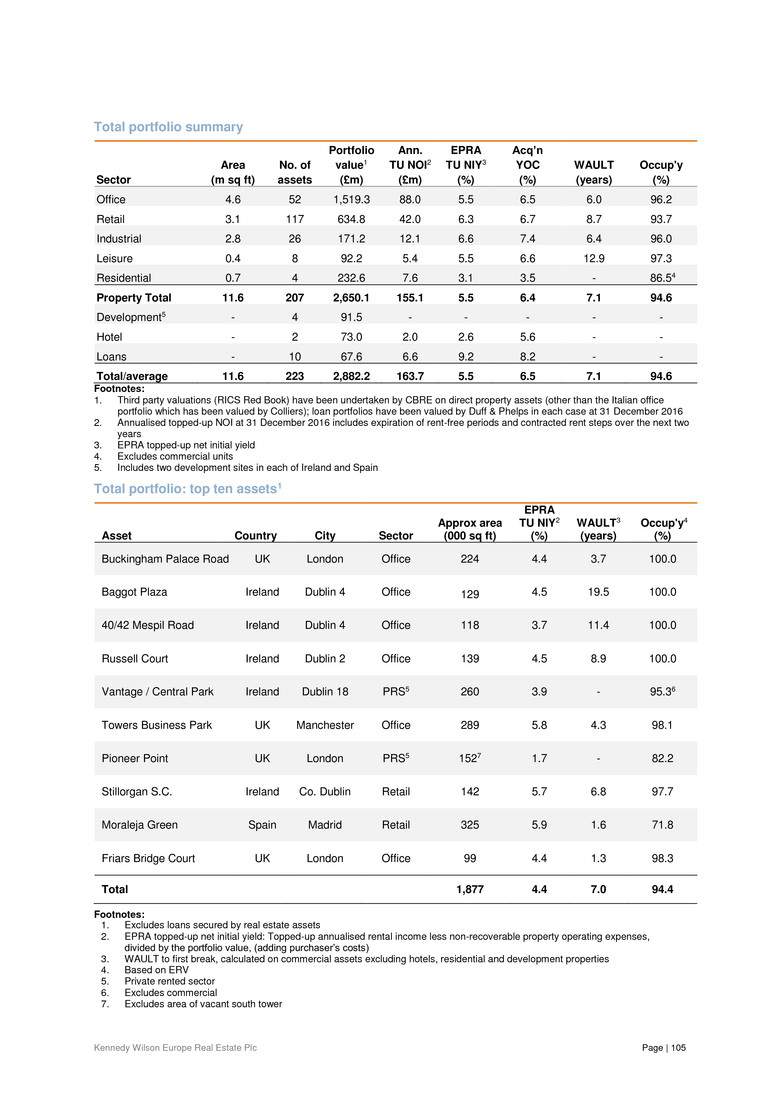
Kennedy Wilson Europe Real Estate Plc Page | 105 Total portfolio summary Portfolio Ann. EPRA Acq’n Area No. of value1 TU NOI2 TU NIY3 YOC WAULT Occup'y Sector (m sq ft) assets (£m) (£m) (%) (%) (years) (%) Office 4.6 52 1,519.3 88.0 5.5 6.5 6.0 96.2 Retail 3.1 117 634.8 42.0 6.3 6.7 8.7 93.7 Industrial 2.8 26 171.2 12.1 6.6 7.4 6.4 96.0 Leisure 0.4 8 92.2 5.4 5.5 6.6 12.9 97.3 Residential 0.7 4 232.6 7.6 3.1 3.5 - 86.54 Property Total 11.6 207 2,650.1 155.1 5.5 6.4 7.1 94.6 Development5 - 4 91.5 - - - - - Hotel - 2 73.0 2.0 2.6 5.6 - - Loans - 10 67.6 6.6 9.2 8.2 - - Total/average 11.6 223 2,882.2 163.7 5.5 6.5 7.1 94.6 Footnotes: 1. Third party valuations (RICS Red Book) have been undertaken by CBRE on direct property assets (other than the Italian office portfolio which has been valued by Colliers); loan portfolios have been valued by Duff & Phelps in each case at 31 December 2016 2. Annualised topped-up NOI at 31 December 2016 includes expiration of rent-free periods and contracted rent steps over the next two years 3. EPRA topped-up net initial yield 4. Excludes commercial units 5. Includes two development sites in each of Ireland and Spain Total portfolio: top ten assets1 Approx area EPRA TU NIY2 WAULT3 Occup'y4 Asset Country City Sector (000 sq ft) (%) (years) (%) Buckingham Palace Road UK London Office 224 4.4 3.7 100.0 Baggot Plaza Ireland Dublin 4 Office 129 4.5 19.5 100.0 40/42 Mespil Road Ireland Dublin 4 Office 118 3.7 11.4 100.0 Russell Court Ireland Dublin 2 Office 139 4.5 8.9 100.0 Vantage / Central Park Ireland Dublin 18 PRS5 260 3.9 - 95.36 Towers Business Park UK Manchester Office 289 5.8 4.3 98.1 Pioneer Point UK London PRS5 1527 1.7 - 82.2 Stillorgan S.C. Ireland Co. Dublin Retail 142 5.7 6.8 97.7 Moraleja Green Spain Madrid Retail 325 5.9 1.6 71.8 Friars Bridge Court UK London Office 99 4.4 1.3 98.3 Total 1,877 4.4 7.0 94.4 Footnotes: 1. Excludes loans secured by real estate assets 2. EPRA topped-up net initial yield: Topped-up annualised rental income less non-recoverable property operating expenses, divided by the portfolio value, (adding purchaser’s costs) 3. WAULT to first break, calculated on commercial assets excluding hotels, residential and development properties 4. Based on ERV 5. Private rented sector 6. Excludes commercial 7. Excludes area of vacant south tower
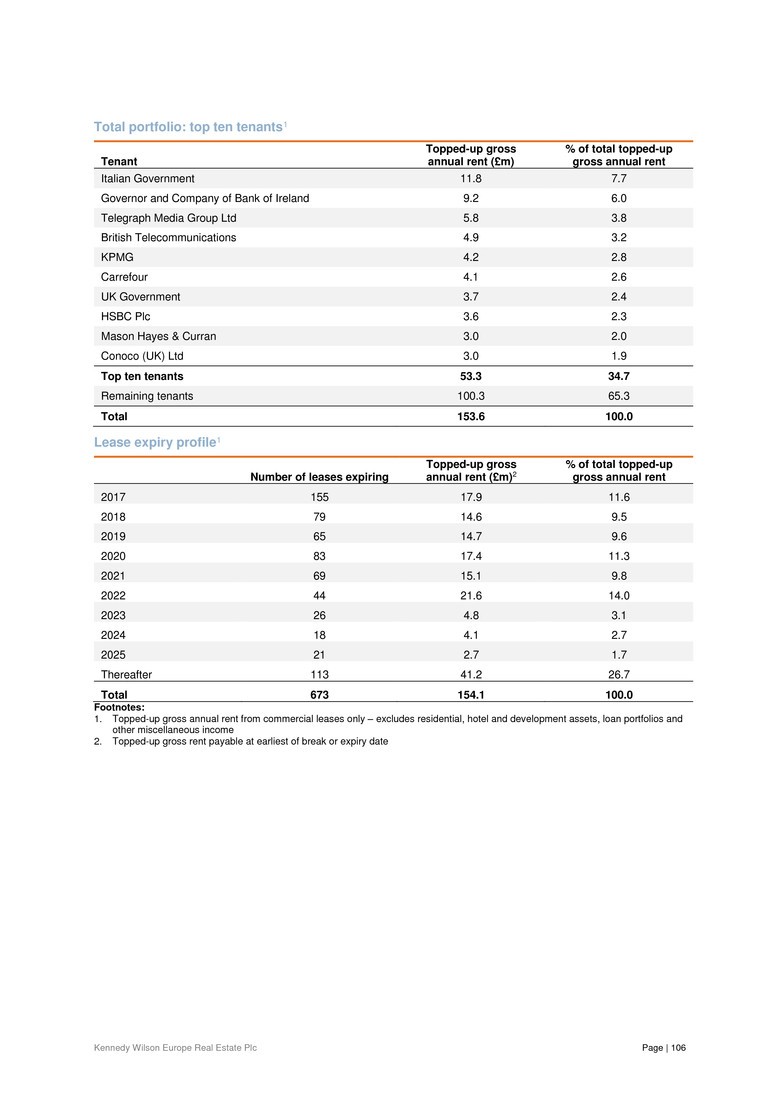
Kennedy Wilson Europe Real Estate Plc Page | 106 Total portfolio: top ten tenants1 Tenant Topped-up gross annual rent (£m) % of total topped-up gross annual rent Italian Government 11.8 7.7 Governor and Company of Bank of Ireland 9.2 6.0 Telegraph Media Group Ltd 5.8 3.8 British Telecommunications 4.9 3.2 KPMG 4.2 2.8 Carrefour 4.1 2.6 UK Government 3.7 2.4 HSBC Plc 3.6 2.3 Mason Hayes & Curran 3.0 2.0 Conoco (UK) Ltd 3.0 1.9 Top ten tenants 53.3 34.7 Remaining tenants 100.3 65.3 Total 153.6 100.0 Lease expiry profile1 Number of leases expiring Topped-up gross annual rent (£m)2 % of total topped-up gross annual rent 2017 155 17.9 11.6 2018 79 14.6 9.5 2019 65 14.7 9.6 2020 83 17.4 11.3 2021 69 15.1 9.8 2022 44 21.6 14.0 2023 26 4.8 3.1 2024 18 4.1 2.7 2025 21 2.7 1.7 Thereafter 113 41.2 26.7 Total 673 154.1 100.0 Footnotes: 1. Topped-up gross annual rent from commercial leases only – excludes residential, hotel and development assets, loan portfolios and other miscellaneous income 2. Topped-up gross rent payable at earliest of break or expiry date
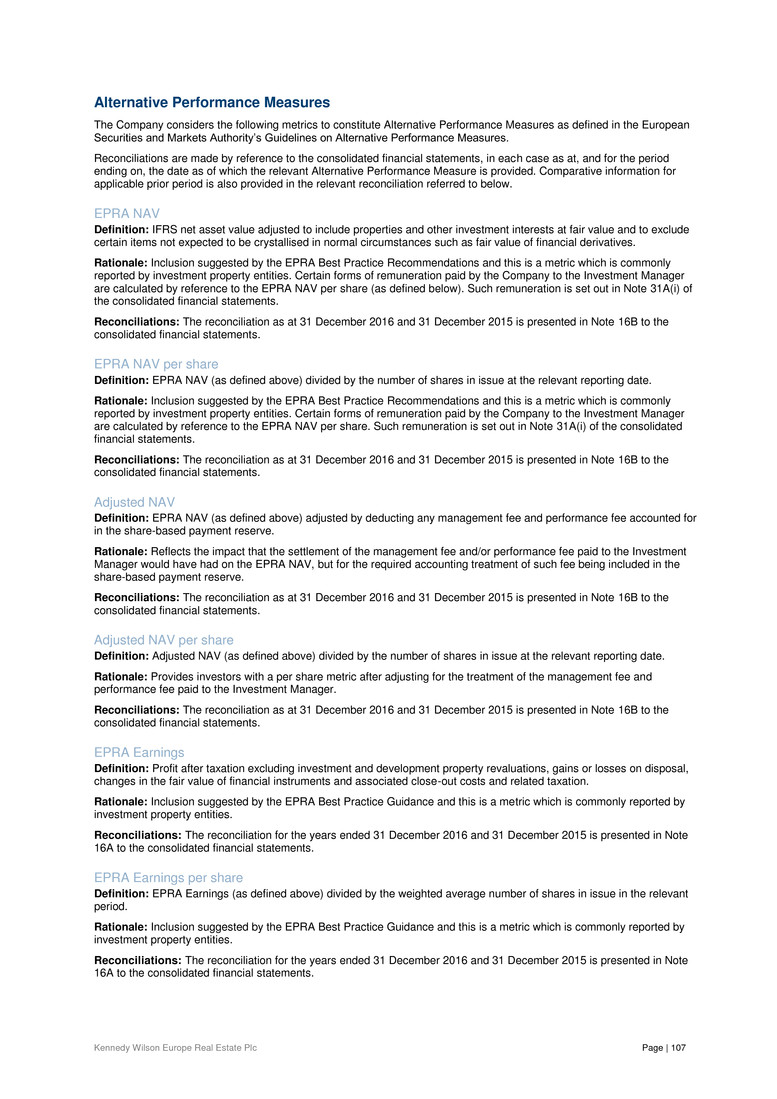
Kennedy Wilson Europe Real Estate Plc Page | 107 Alternative Performance Measures The Company considers the following metrics to constitute Alternative Performance Measures as defined in the European Securities and Markets Authority’s Guidelines on Alternative Performance Measures. Reconciliations are made by reference to the consolidated financial statements, in each case as at, and for the period ending on, the date as of which the relevant Alternative Performance Measure is provided. Comparative information for applicable prior period is also provided in the relevant reconciliation referred to below. EPRA NAV Definition: IFRS net asset value adjusted to include properties and other investment interests at fair value and to exclude certain items not expected to be crystallised in normal circumstances such as fair value of financial derivatives. Rationale: Inclusion suggested by the EPRA Best Practice Recommendations and this is a metric which is commonly reported by investment property entities. Certain forms of remuneration paid by the Company to the Investment Manager are calculated by reference to the EPRA NAV per share (as defined below). Such remuneration is set out in Note 31A(i) of the consolidated financial statements. Reconciliations: The reconciliation as at 31 December 2016 and 31 December 2015 is presented in Note 16B to the consolidated financial statements. EPRA NAV per share Definition: EPRA NAV (as defined above) divided by the number of shares in issue at the relevant reporting date. Rationale: Inclusion suggested by the EPRA Best Practice Recommendations and this is a metric which is commonly reported by investment property entities. Certain forms of remuneration paid by the Company to the Investment Manager are calculated by reference to the EPRA NAV per share. Such remuneration is set out in Note 31A(i) of the consolidated financial statements. Reconciliations: The reconciliation as at 31 December 2016 and 31 December 2015 is presented in Note 16B to the consolidated financial statements. Adjusted NAV Definition: EPRA NAV (as defined above) adjusted by deducting any management fee and performance fee accounted for in the share-based payment reserve. Rationale: Reflects the impact that the settlement of the management fee and/or performance fee paid to the Investment Manager would have had on the EPRA NAV, but for the required accounting treatment of such fee being included in the share-based payment reserve. Reconciliations: The reconciliation as at 31 December 2016 and 31 December 2015 is presented in Note 16B to the consolidated financial statements. Adjusted NAV per share Definition: Adjusted NAV (as defined above) divided by the number of shares in issue at the relevant reporting date. Rationale: Provides investors with a per share metric after adjusting for the treatment of the management fee and performance fee paid to the Investment Manager. Reconciliations: The reconciliation as at 31 December 2016 and 31 December 2015 is presented in Note 16B to the consolidated financial statements. EPRA Earnings Definition: Profit after taxation excluding investment and development property revaluations, gains or losses on disposal, changes in the fair value of financial instruments and associated close-out costs and related taxation. Rationale: Inclusion suggested by the EPRA Best Practice Guidance and this is a metric which is commonly reported by investment property entities. Reconciliations: The reconciliation for the years ended 31 December 2016 and 31 December 2015 is presented in Note 16A to the consolidated financial statements. EPRA Earnings per share Definition: EPRA Earnings (as defined above) divided by the weighted average number of shares in issue in the relevant period. Rationale: Inclusion suggested by the EPRA Best Practice Guidance and this is a metric which is commonly reported by investment property entities. Reconciliations: The reconciliation for the years ended 31 December 2016 and 31 December 2015 is presented in Note 16A to the consolidated financial statements.

Kennedy Wilson Europe Real Estate Plc Page | 108 Adjusted Earnings Definition: EPRA Earnings (as defined above) adjusted by adding back the performance fee expense. Rationale: Provides investors with information about the underlying profitability of the Group through the exclusion of an item which is capital in nature, and which is over and above those items specifically excluded for purposes of calculating EPRA Earnings (as defined above). Reconciliations: The reconciliation for the years ended 31 December 2016 and 31 December 2015 is presented in Note 16A to the consolidated financial statements. Adjusted Earnings per share Definition: Adjusted Earnings (as defined above) divided by the weighted average number of shares in issue in the relevant period. Rationale: Provides investors with a per share metric after adjusting for items identified in Adjusted Earnings. Reconciliations: The reconciliation for the years ended 31 December 2016 and 31 December 2015 is presented in Note 16A to the consolidated financial statements. Loan to Value Definition: Loan to value is the ratio of Net Debt (as defined below) to the portfolio value. Rationale: Provides information about the amount of leverage risk in the Group. Under the terms of certain financial covenants to which the Company is subject and the Company’s investment policy, the loan to value ratio is subject to a maximum amount. Reconciliations: The reconciliation as at 31 December 2016 and 31 December 2015 is presented in Note 27C(v)(c) to the consolidated financial statements. Net Debt Definition: Net debt is gross debt less cash and cash equivalents. Rationale: Key component to the calculation of the Loan to Value metric (as defined above) and is commonly reported by real estate investment companies. Reconciliations: The reconciliation as at 31 December 2016 and 31 December 2015 is presented in Note 27C(v)(a) to the consolidated financial statements. Dividend cover Definition: Ratio of Adjusted Earnings (as defined above) to dividends paid. Rationale: Provides investors an indication of the number of times the Company is capable of paying dividends from the profits earned during the relevant period. Reconciliations: Adjusted Earnings divided by dividends paid during the period. See “Adjusted Earnings” above for the Adjusted Earnings reconciliation in the consolidated financial statements. The comparative information as regards dividends paid for the years ended 31 December 2016 and 31 December 2015 is presented in Note 29 to the consolidated financial statements. Total accounting return Definition: Percentage growth in Adjusted NAV per share (as defined above) plus dividend per share divided by opening Adjusted NAV per share. Rationale: Provides information about the total income and capital performance of the Company over a relevant period. It is commonly reported by real estate investment companies. Reconciliations: Adjusted NAV per share plus dividend per share, divided by opening Adjusted NAV per share. See “Adjusted NAV per share” above for the “Adjusted NAV per share” reconciliation in the consolidated financial statements. The comparative information as regards total accounting return as at 31 December 2016 and 31 December 2015 is presented in Table 6 of the Finance Review. The comparative information as regards dividend per share for the years ended 31 December 2016 and 31 December 2015 is presented in Note 29 to the consolidated financial statements.











































































































